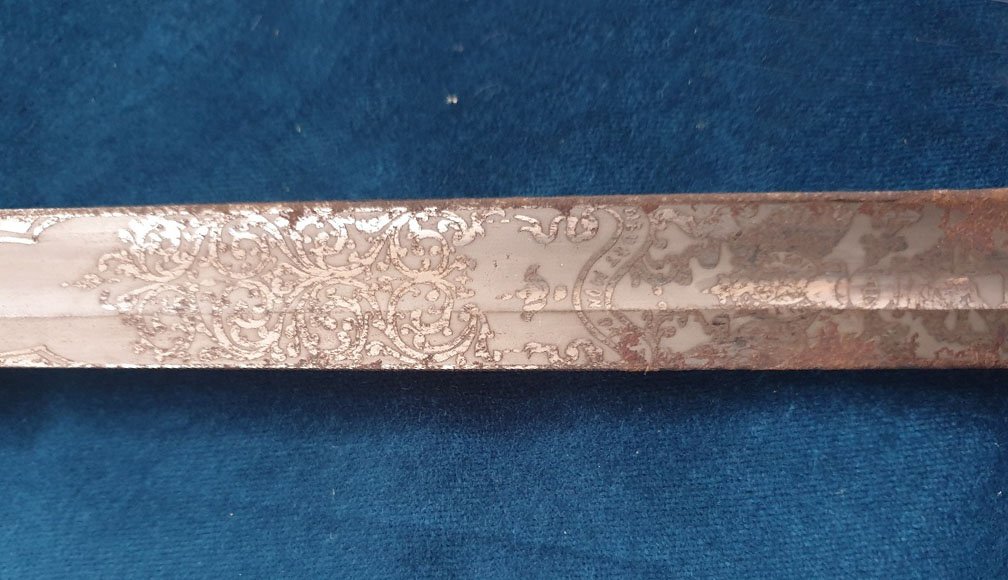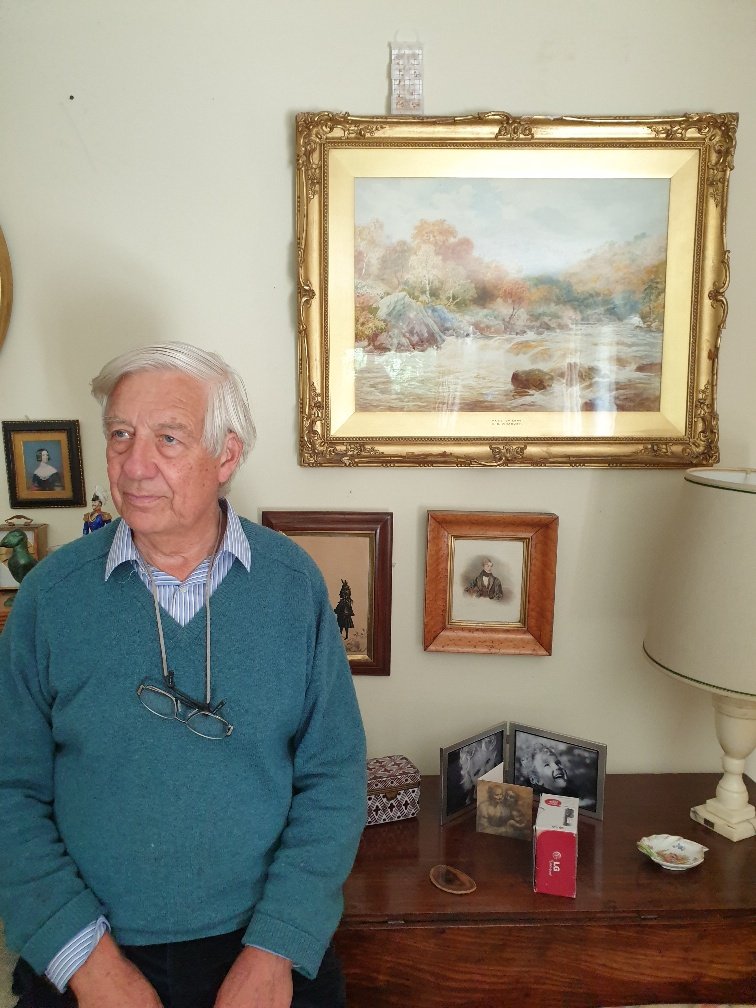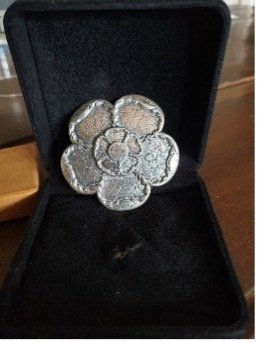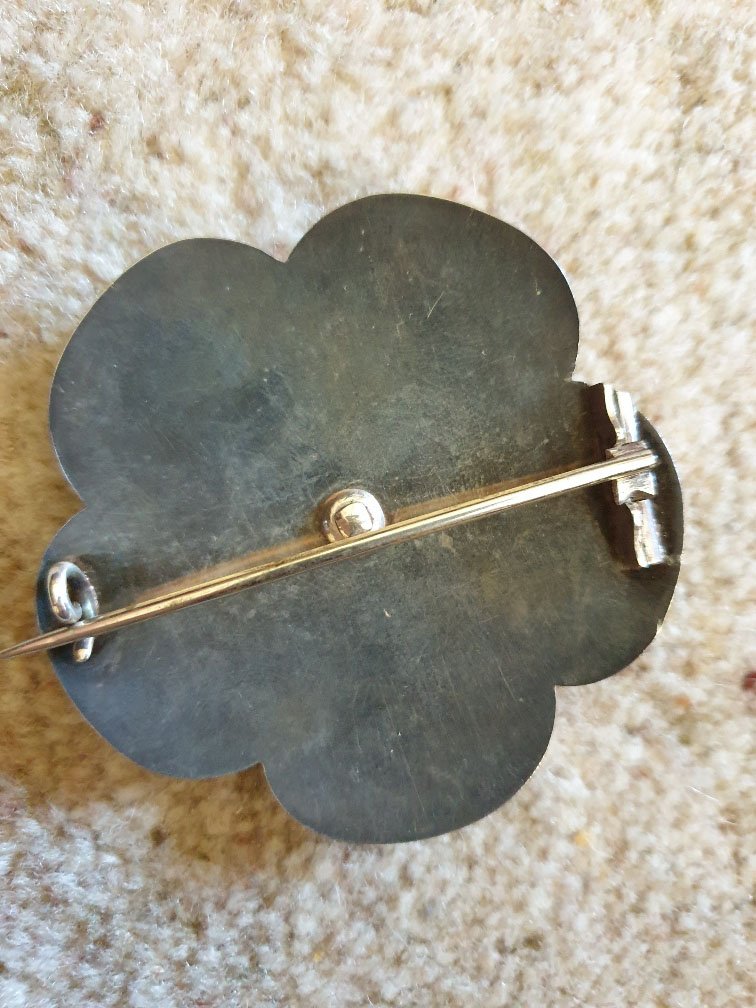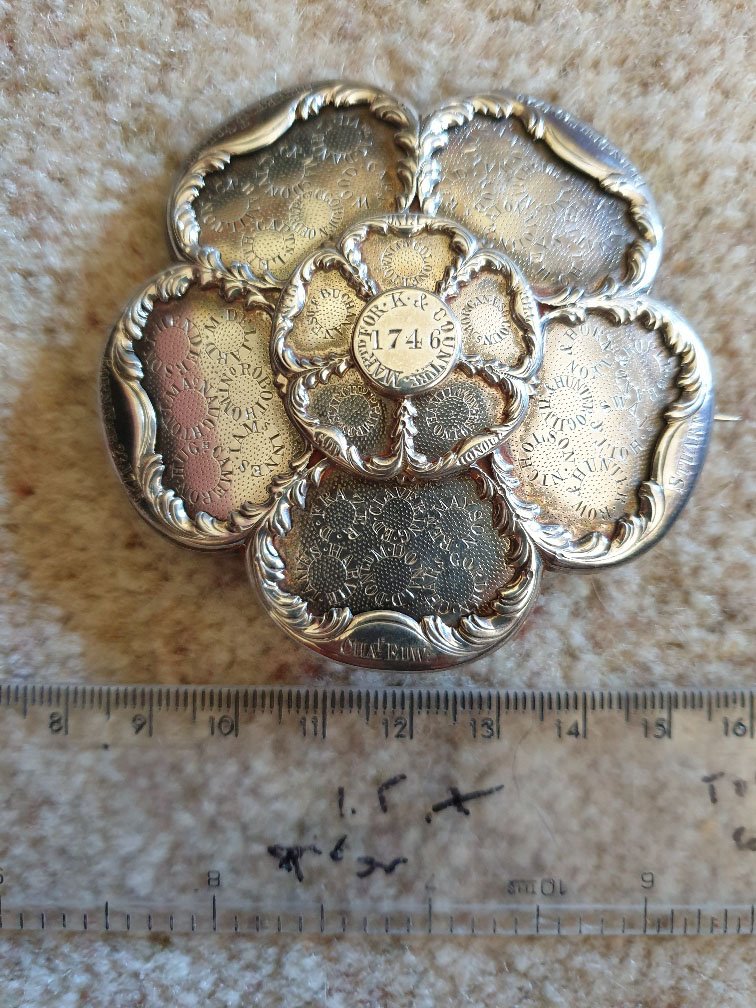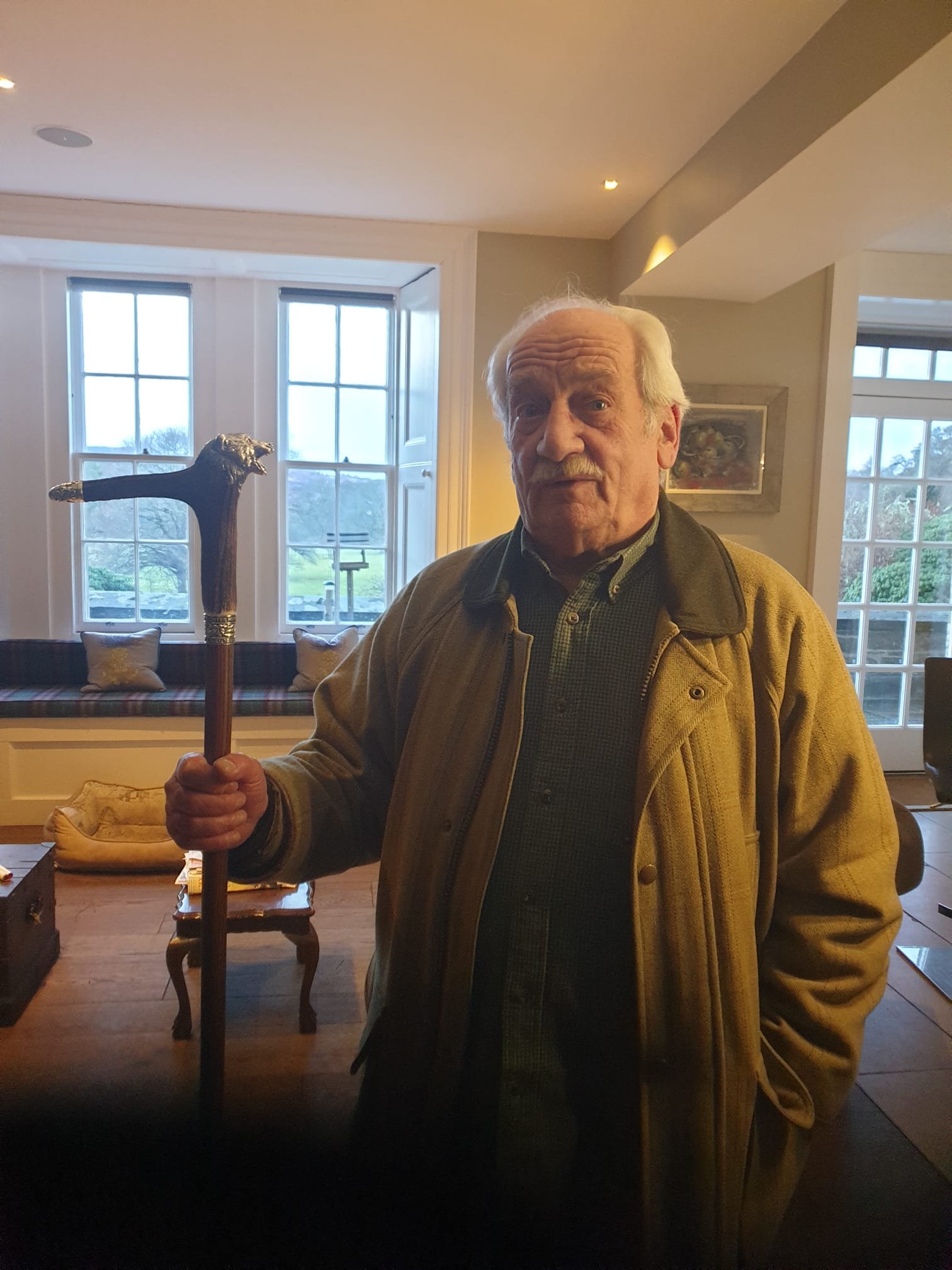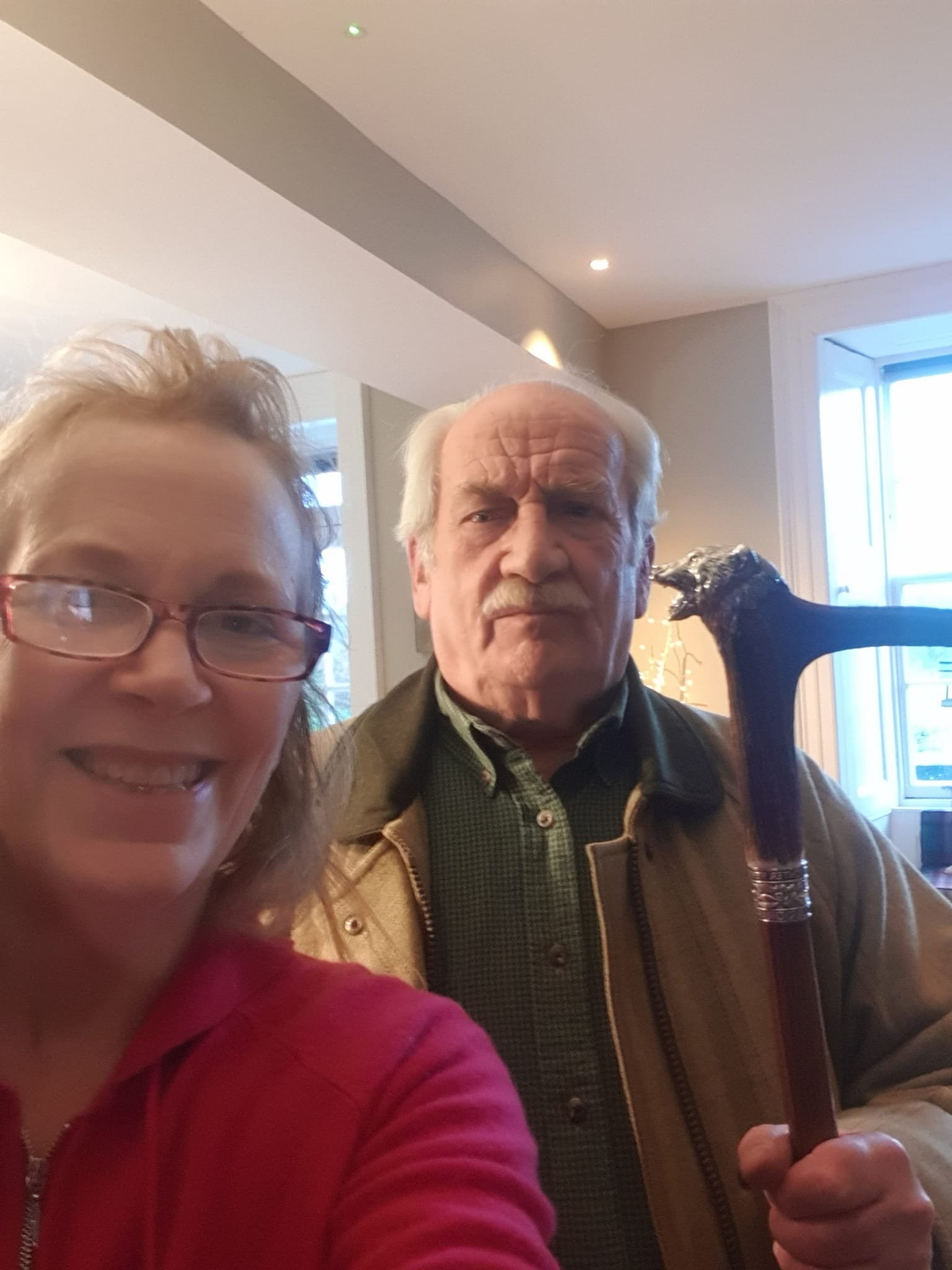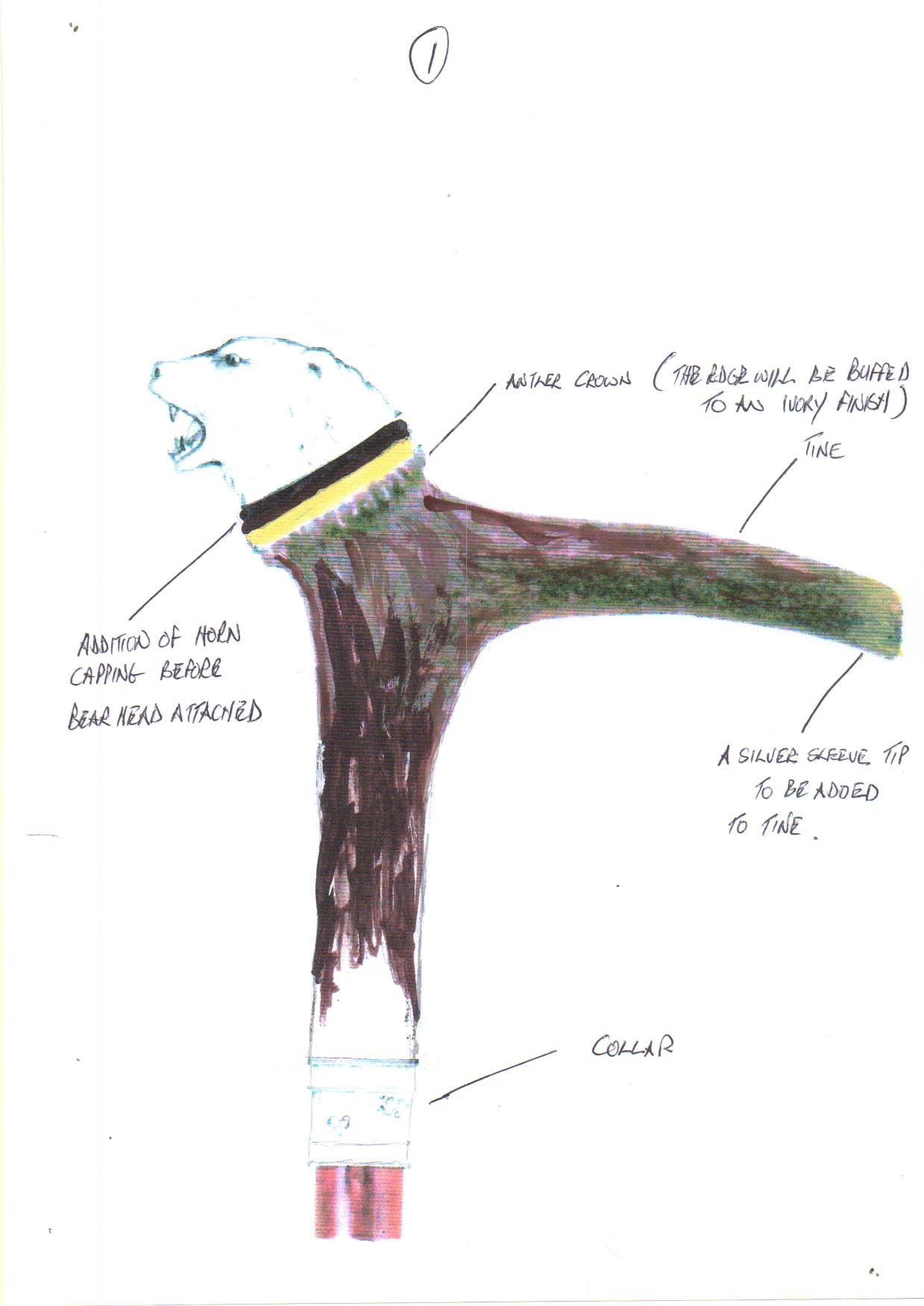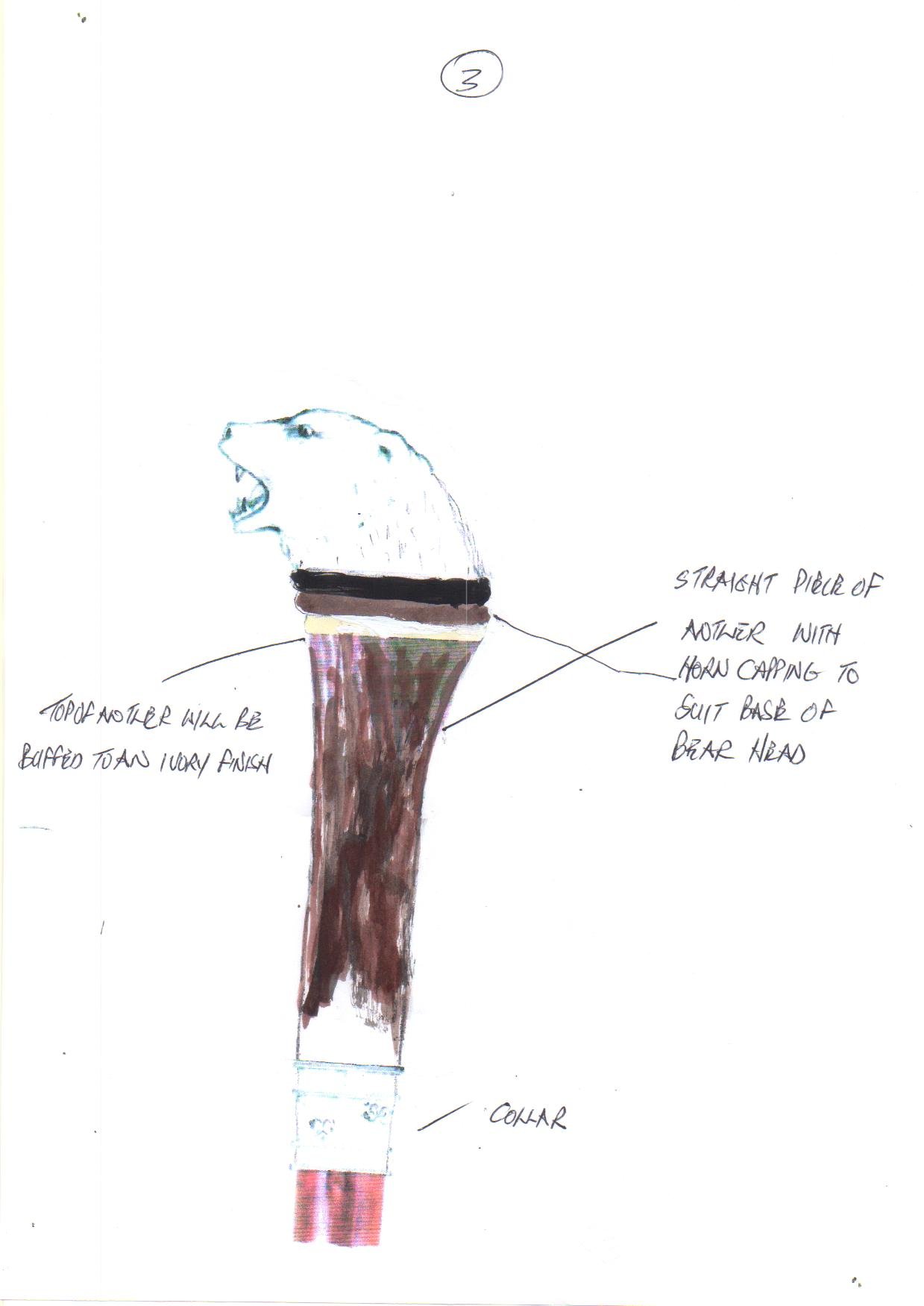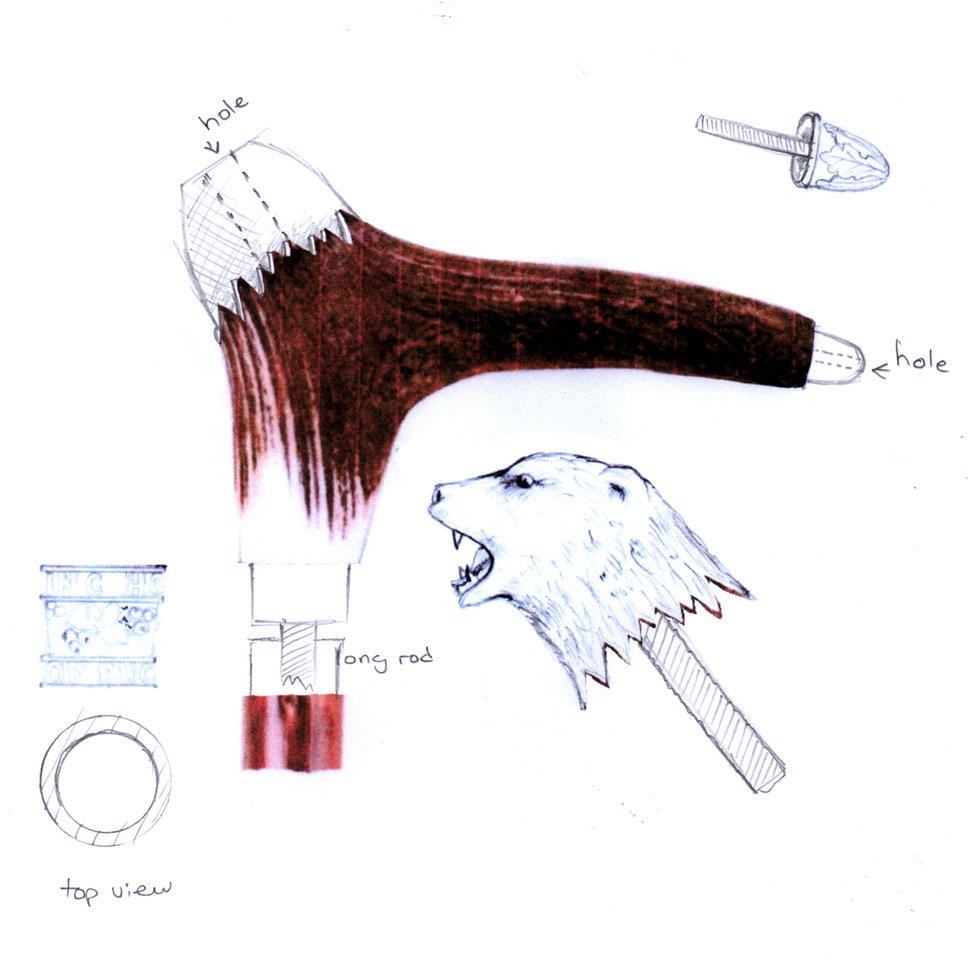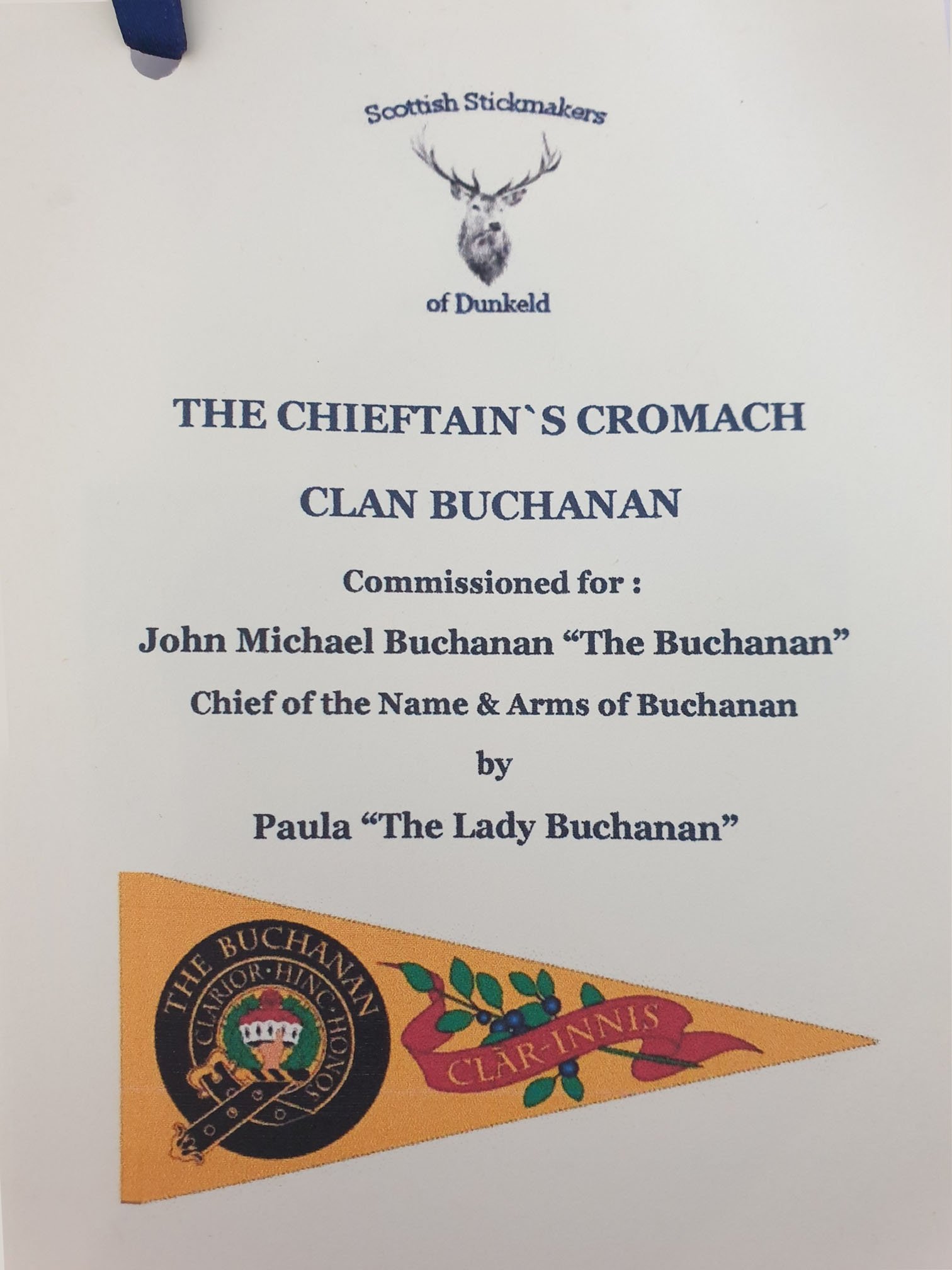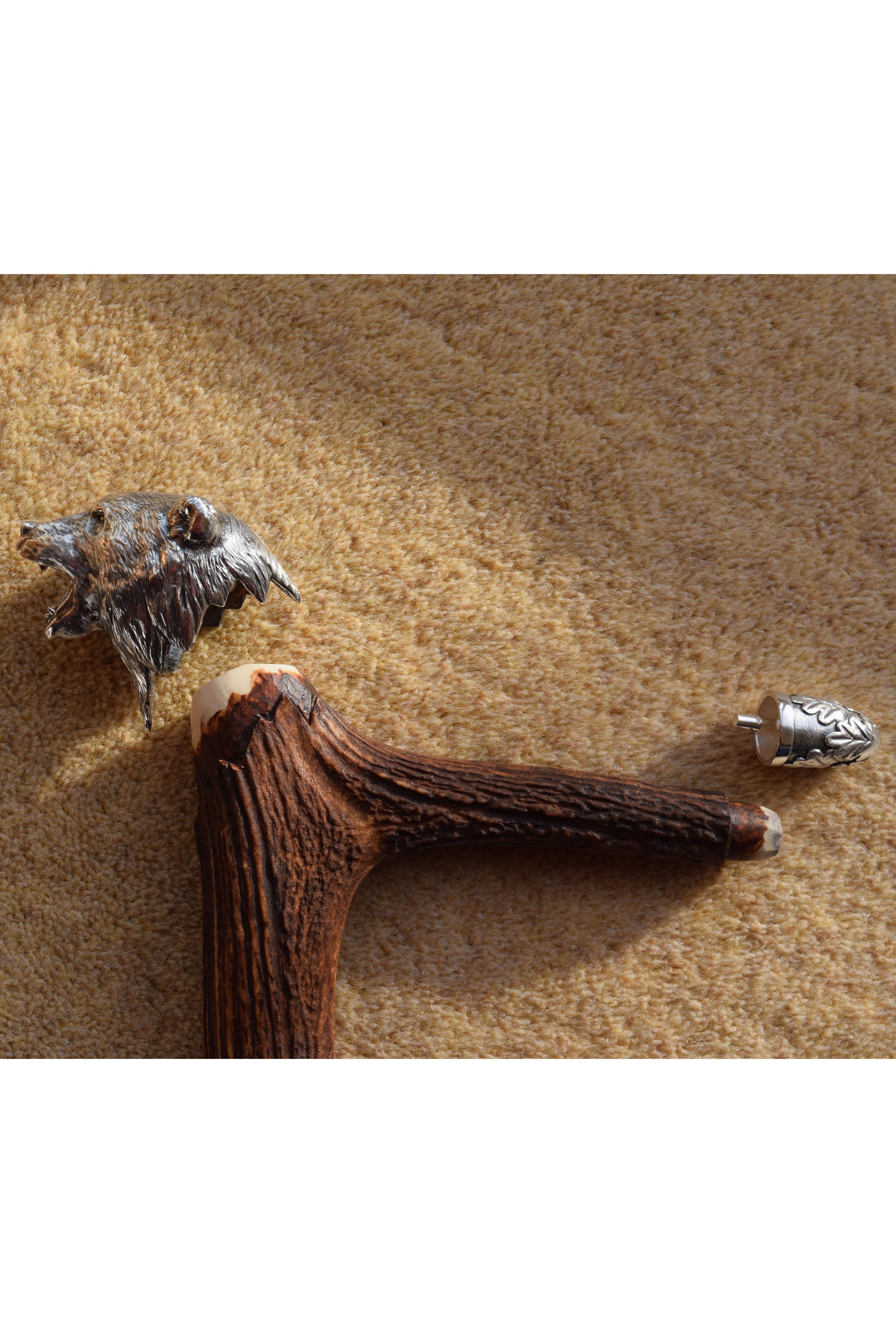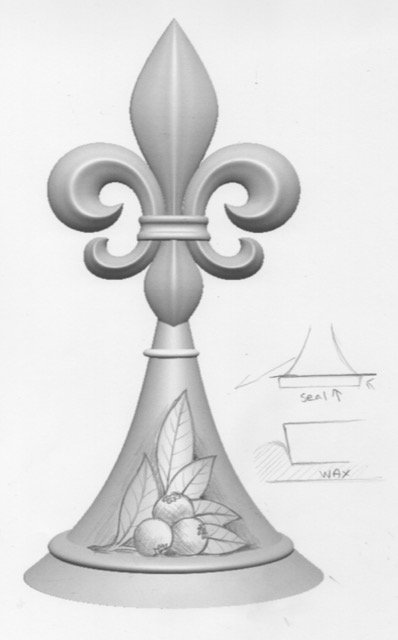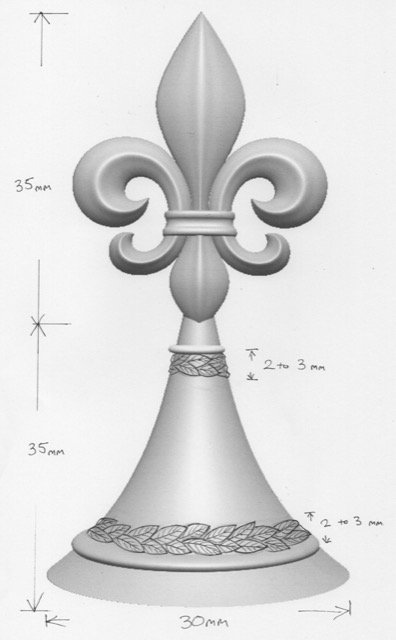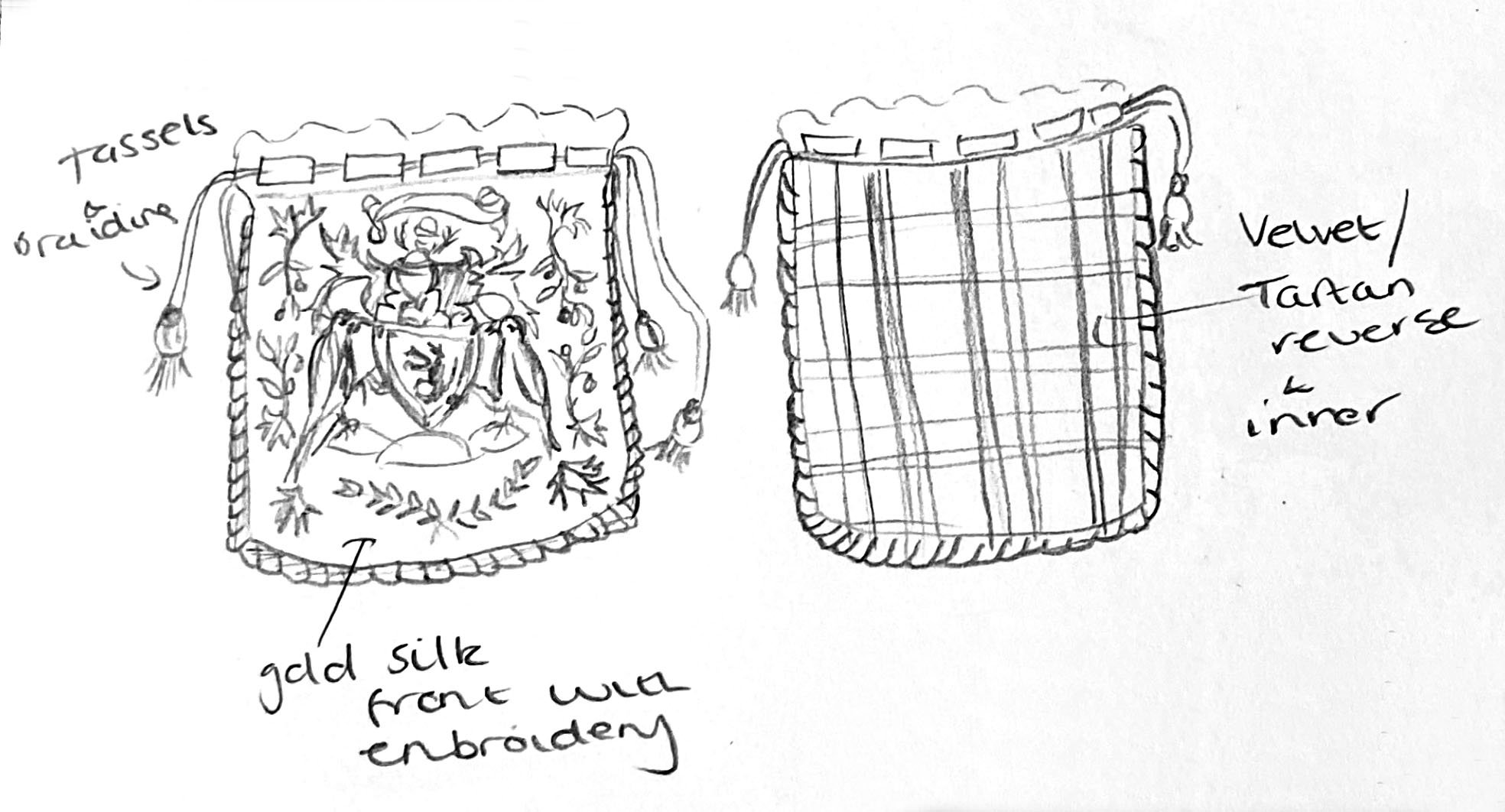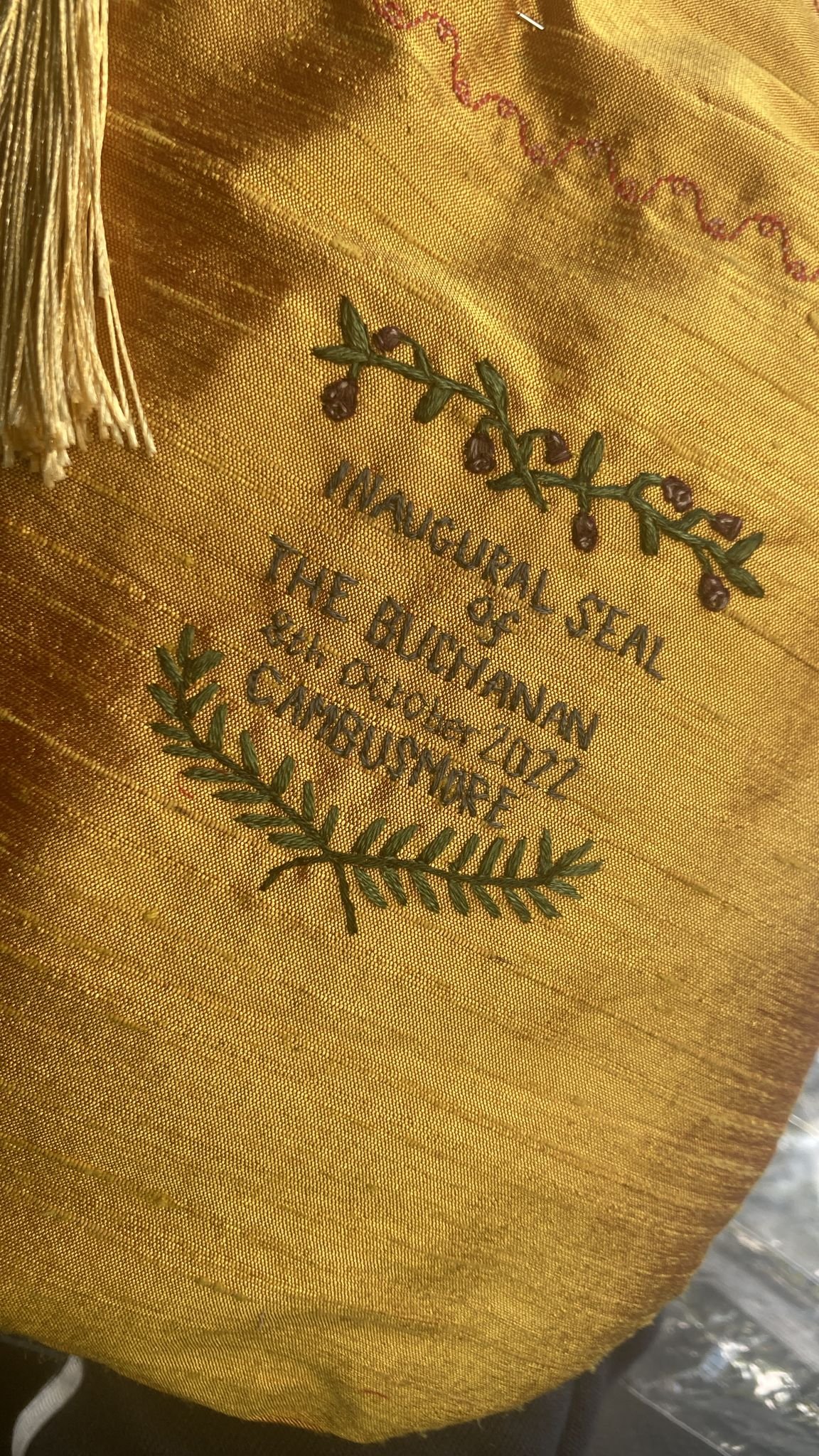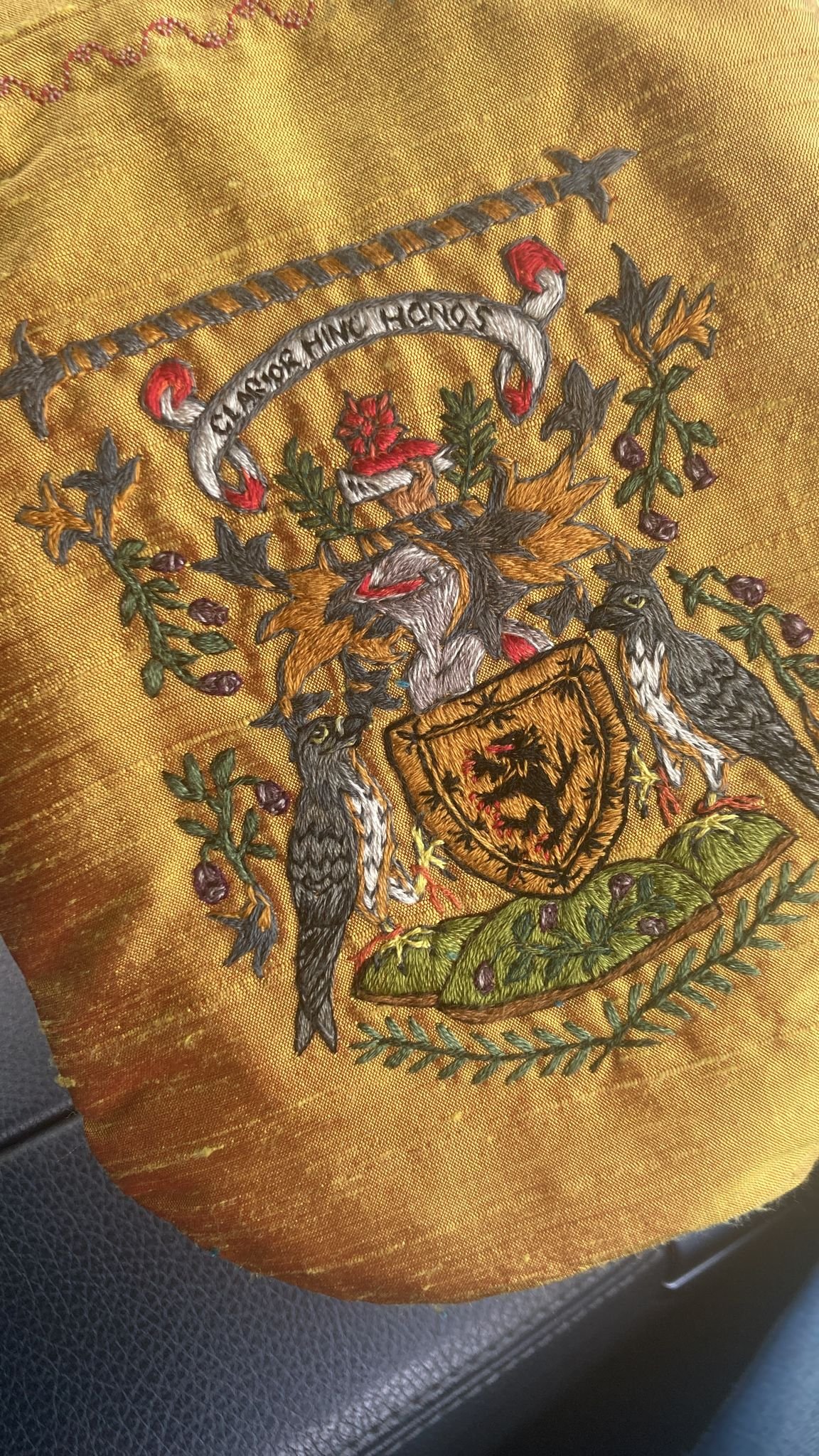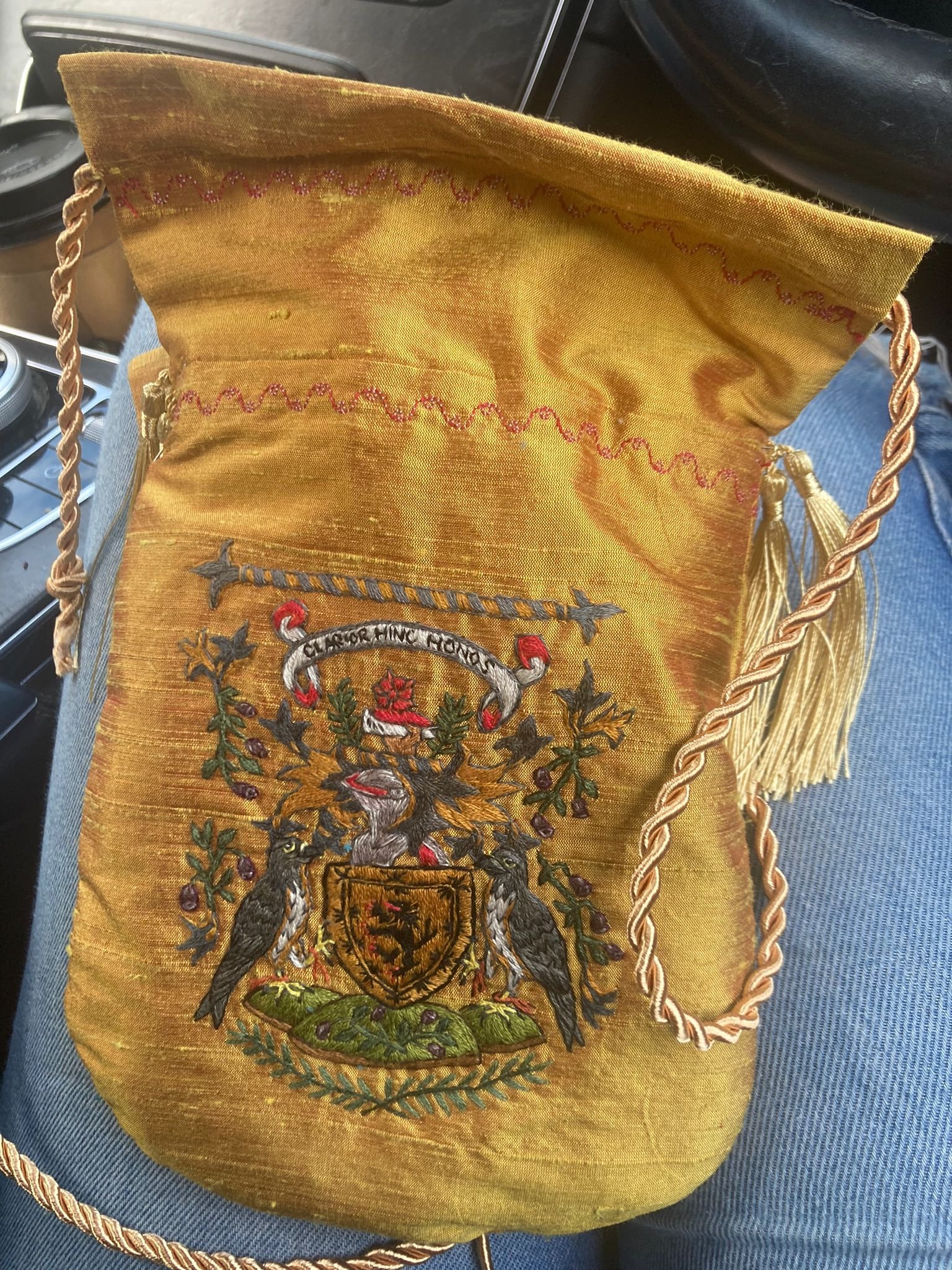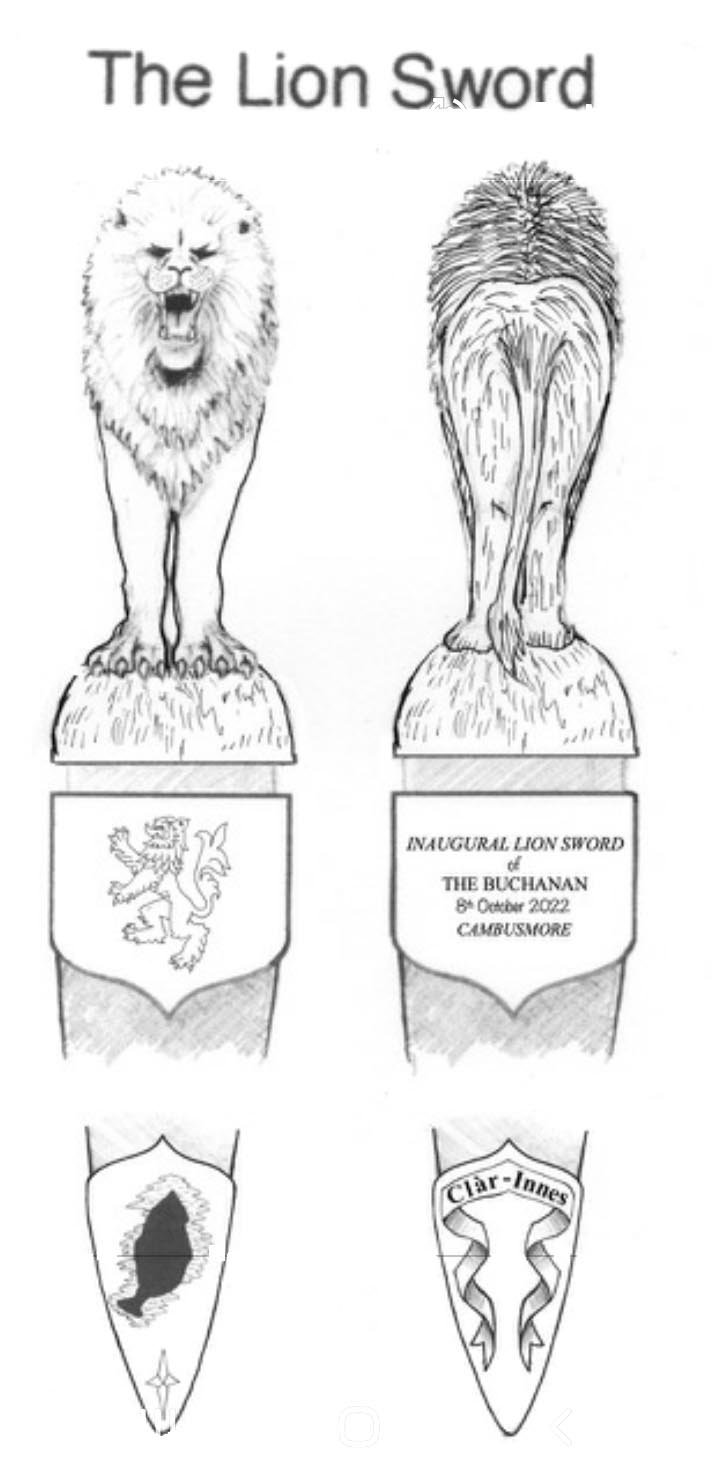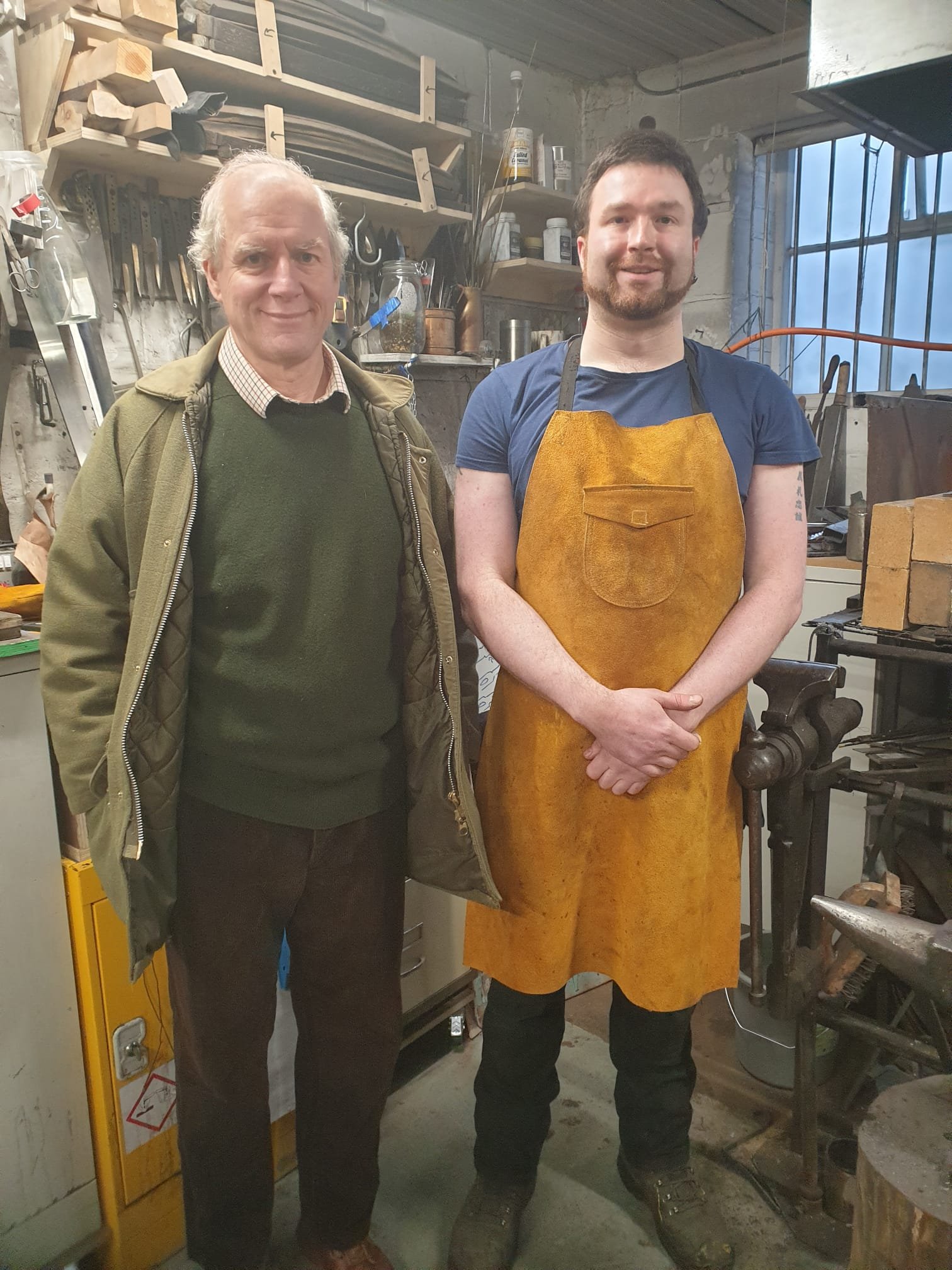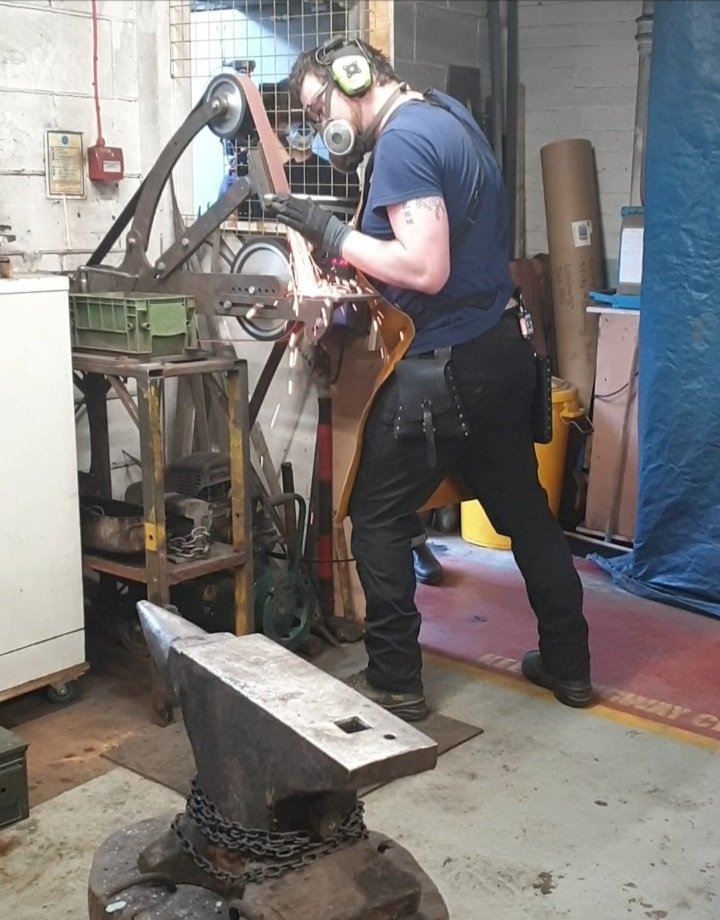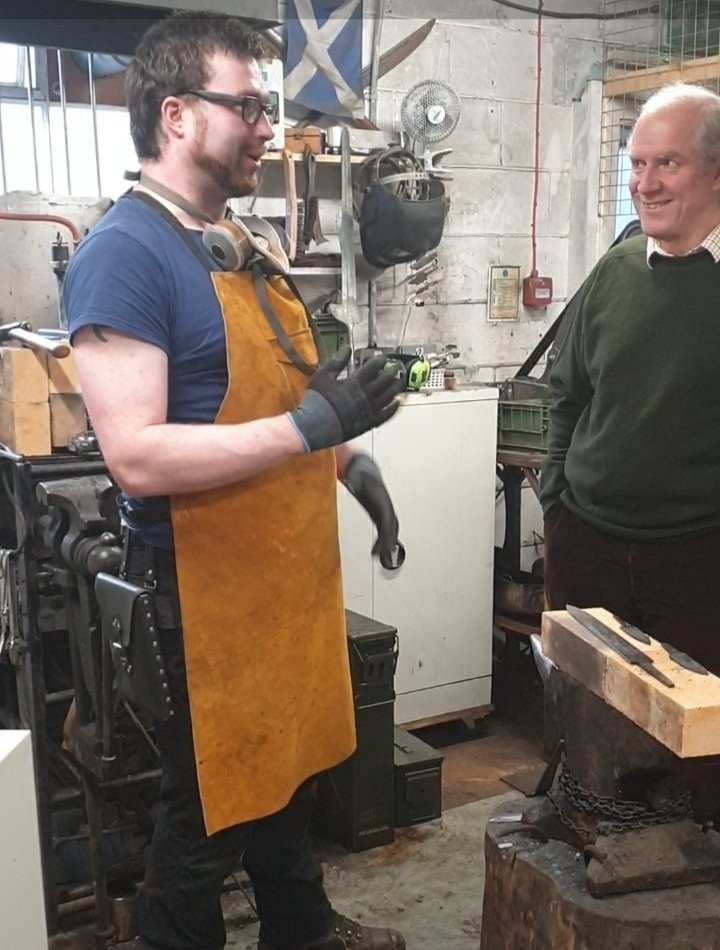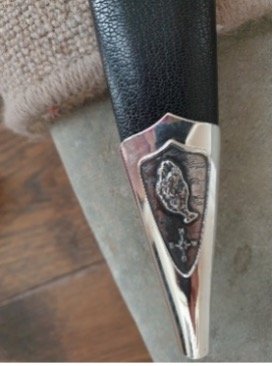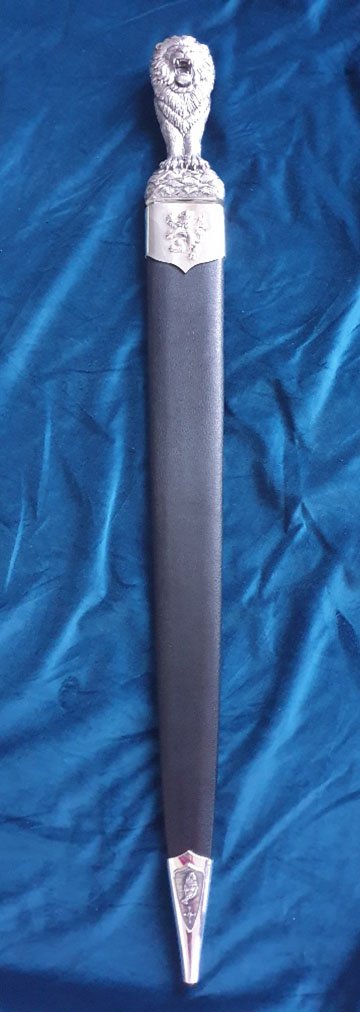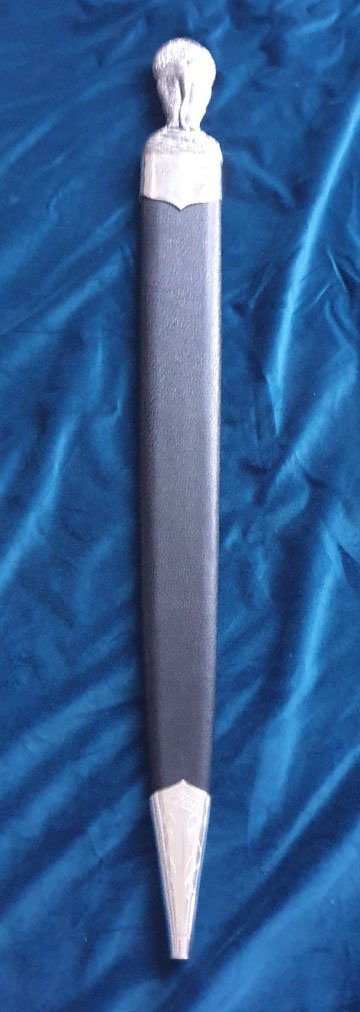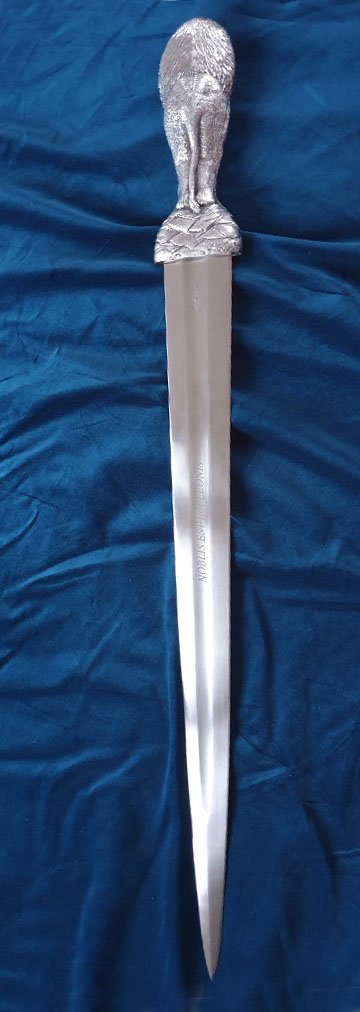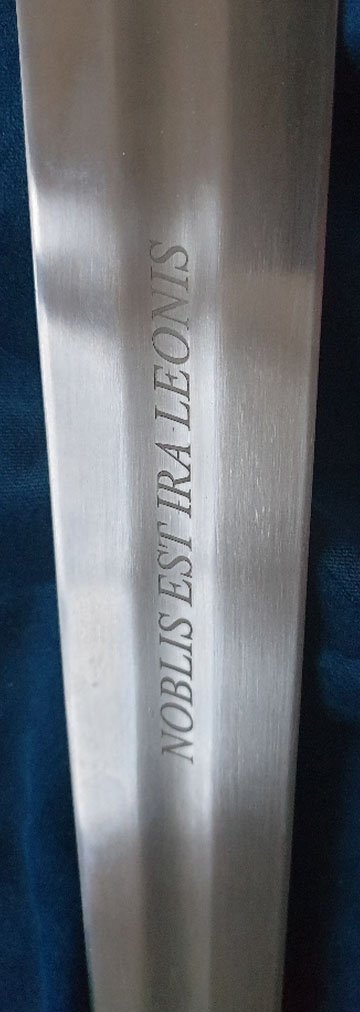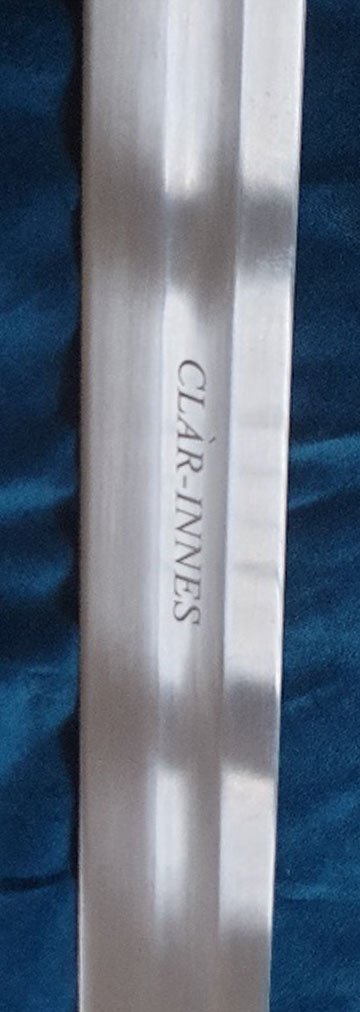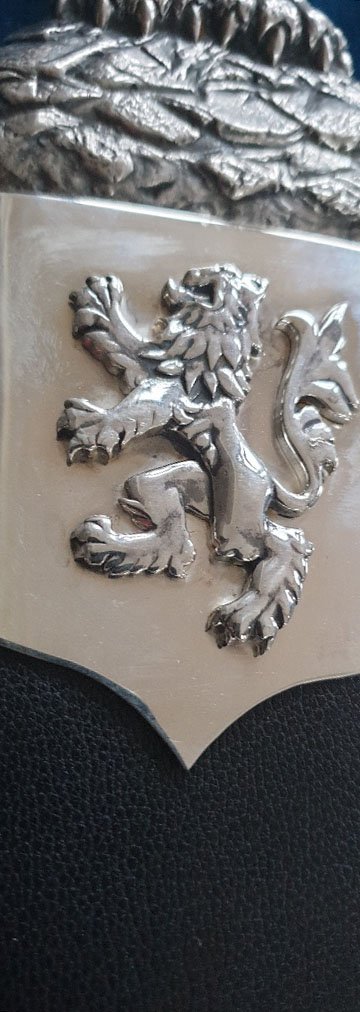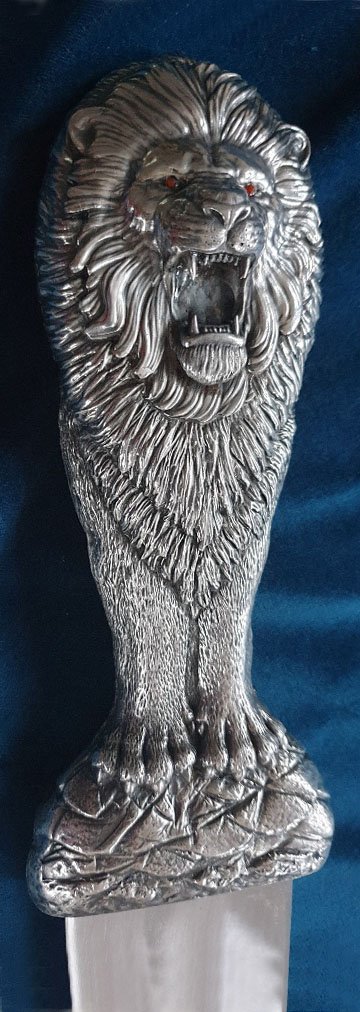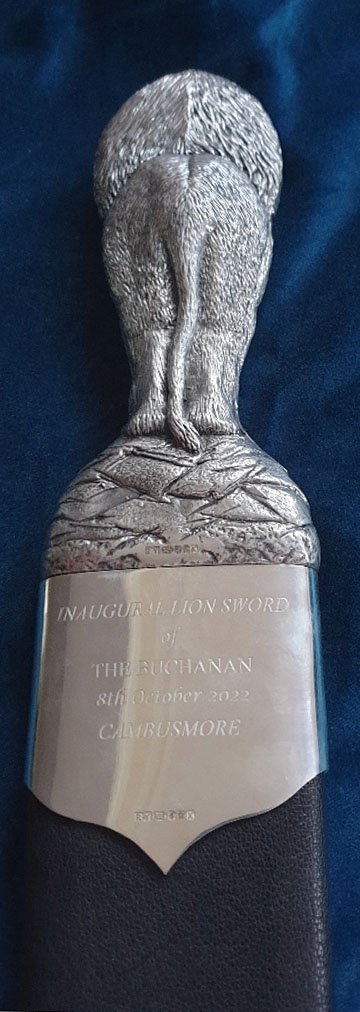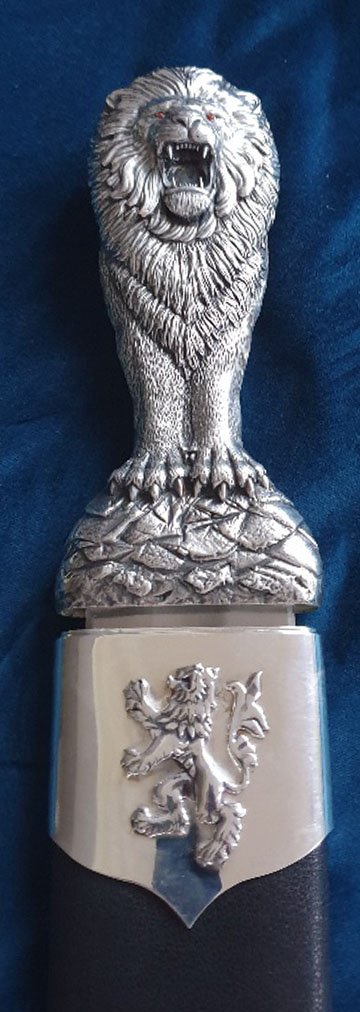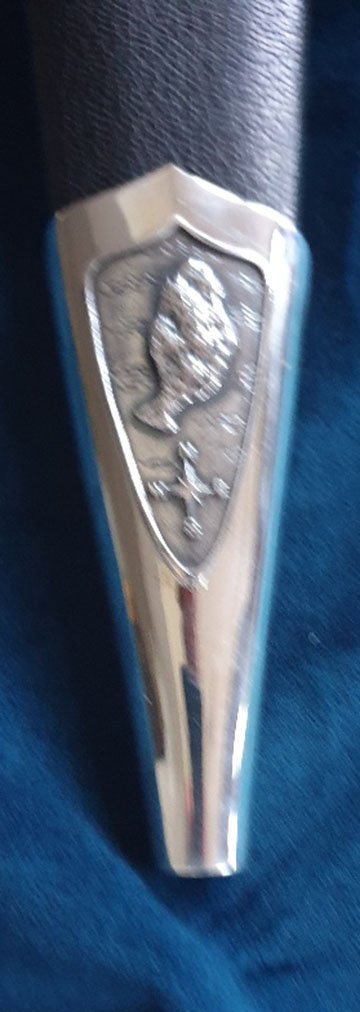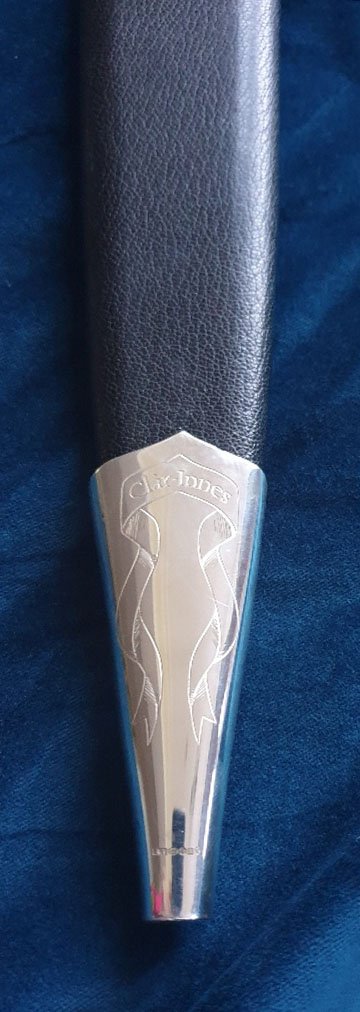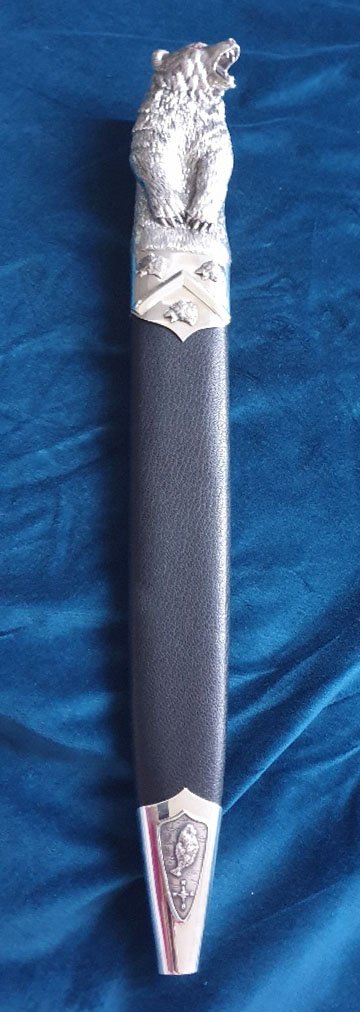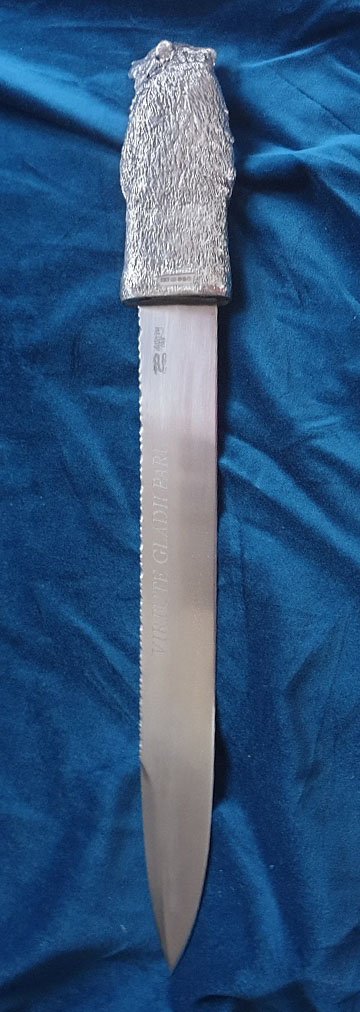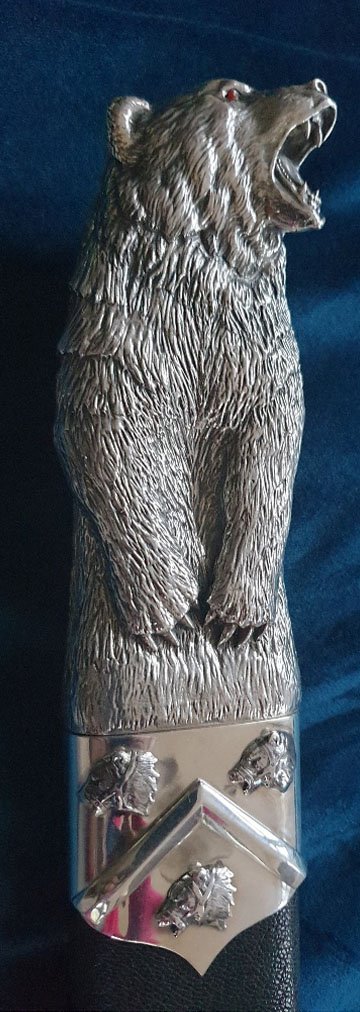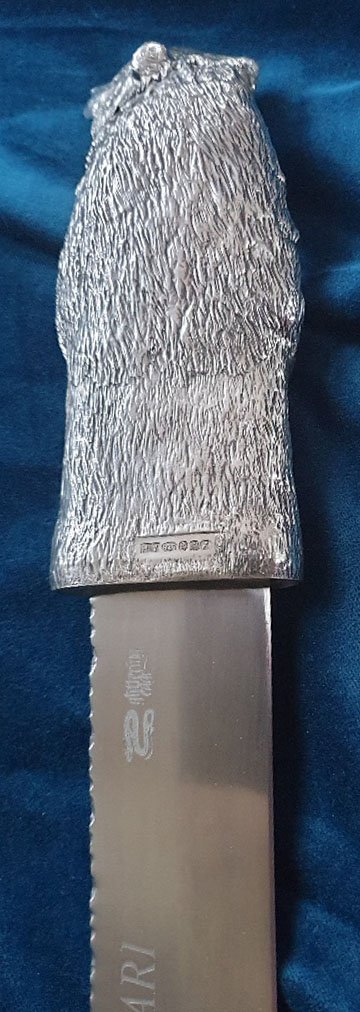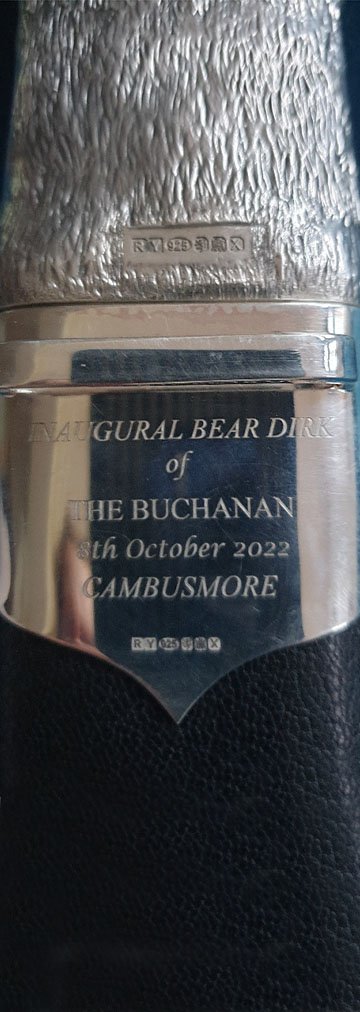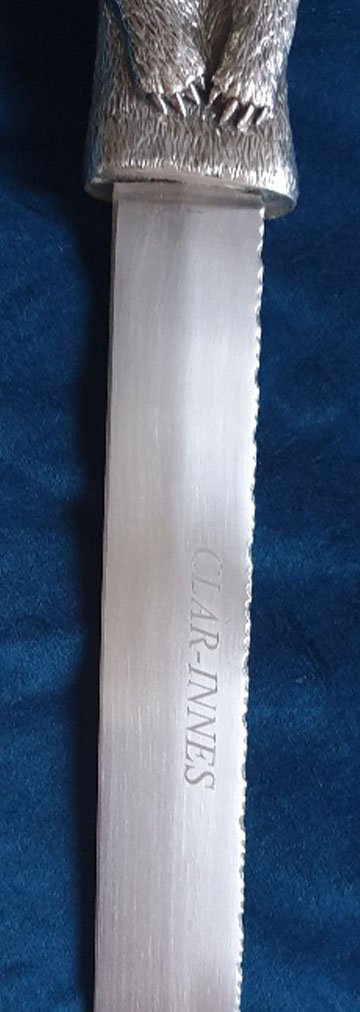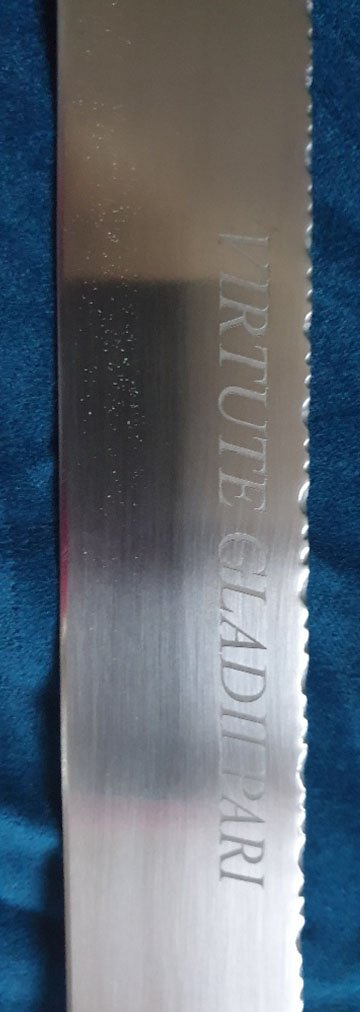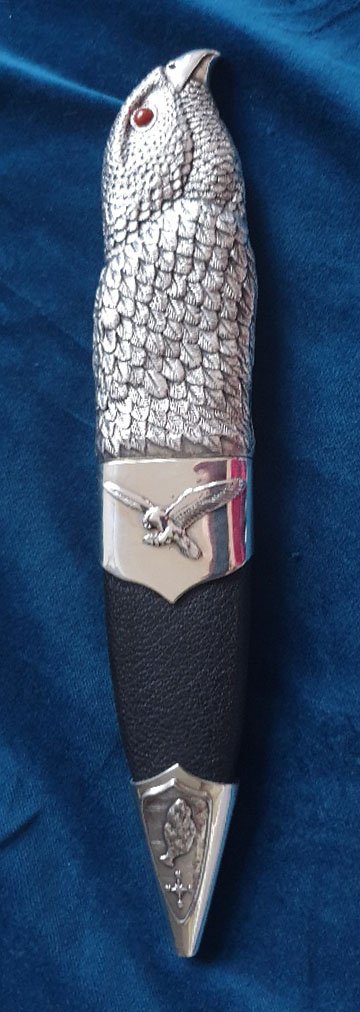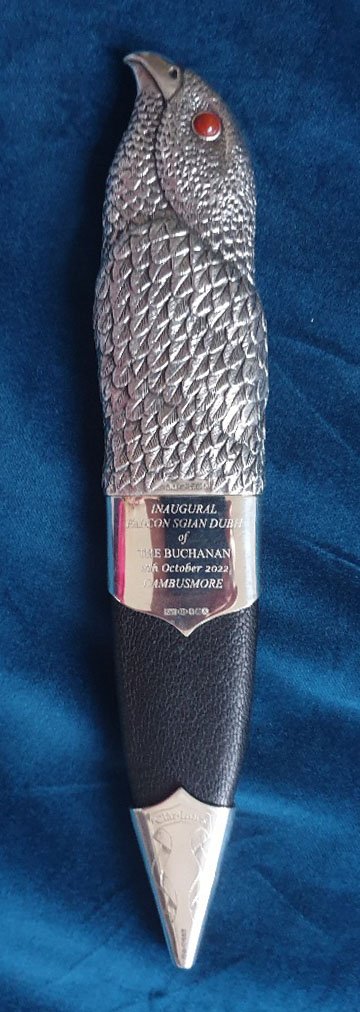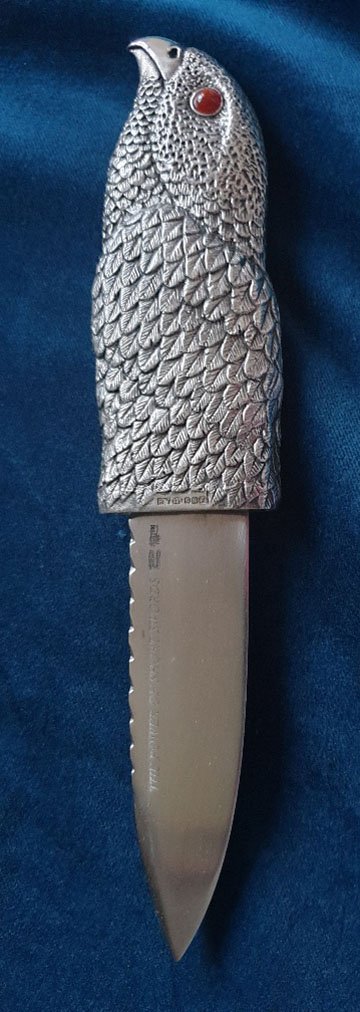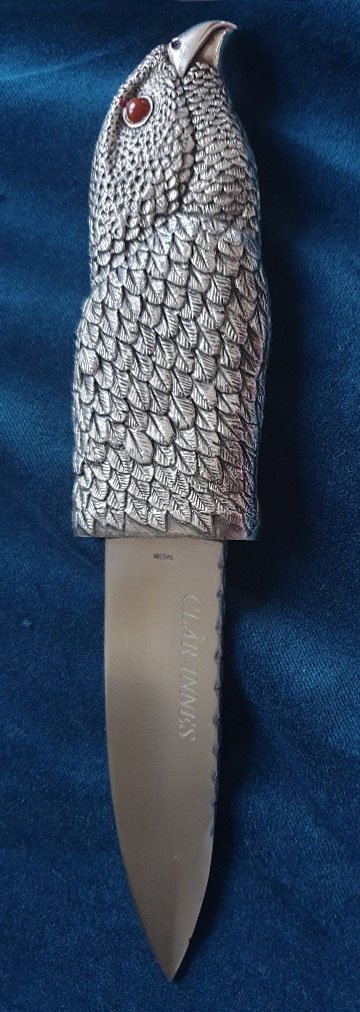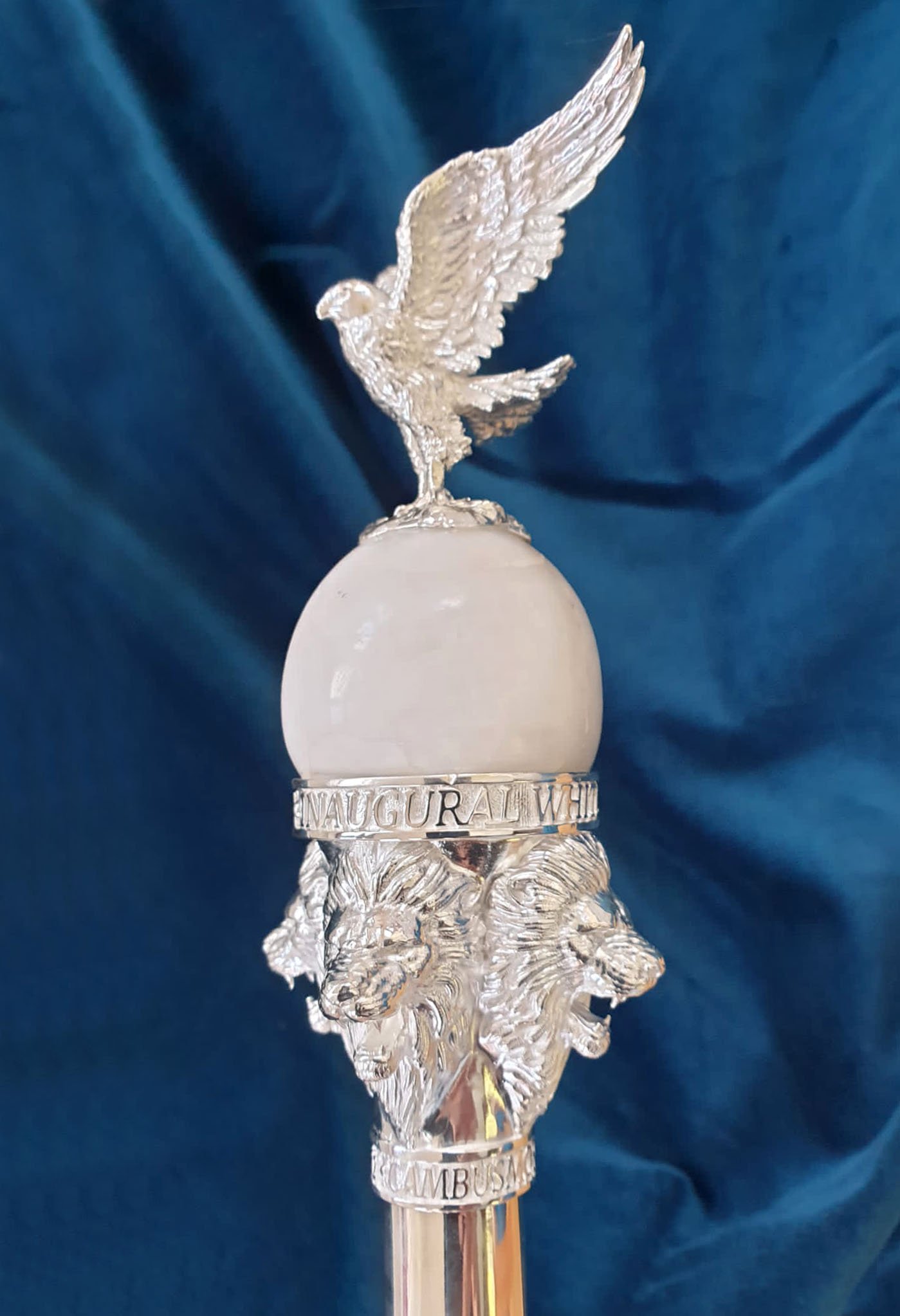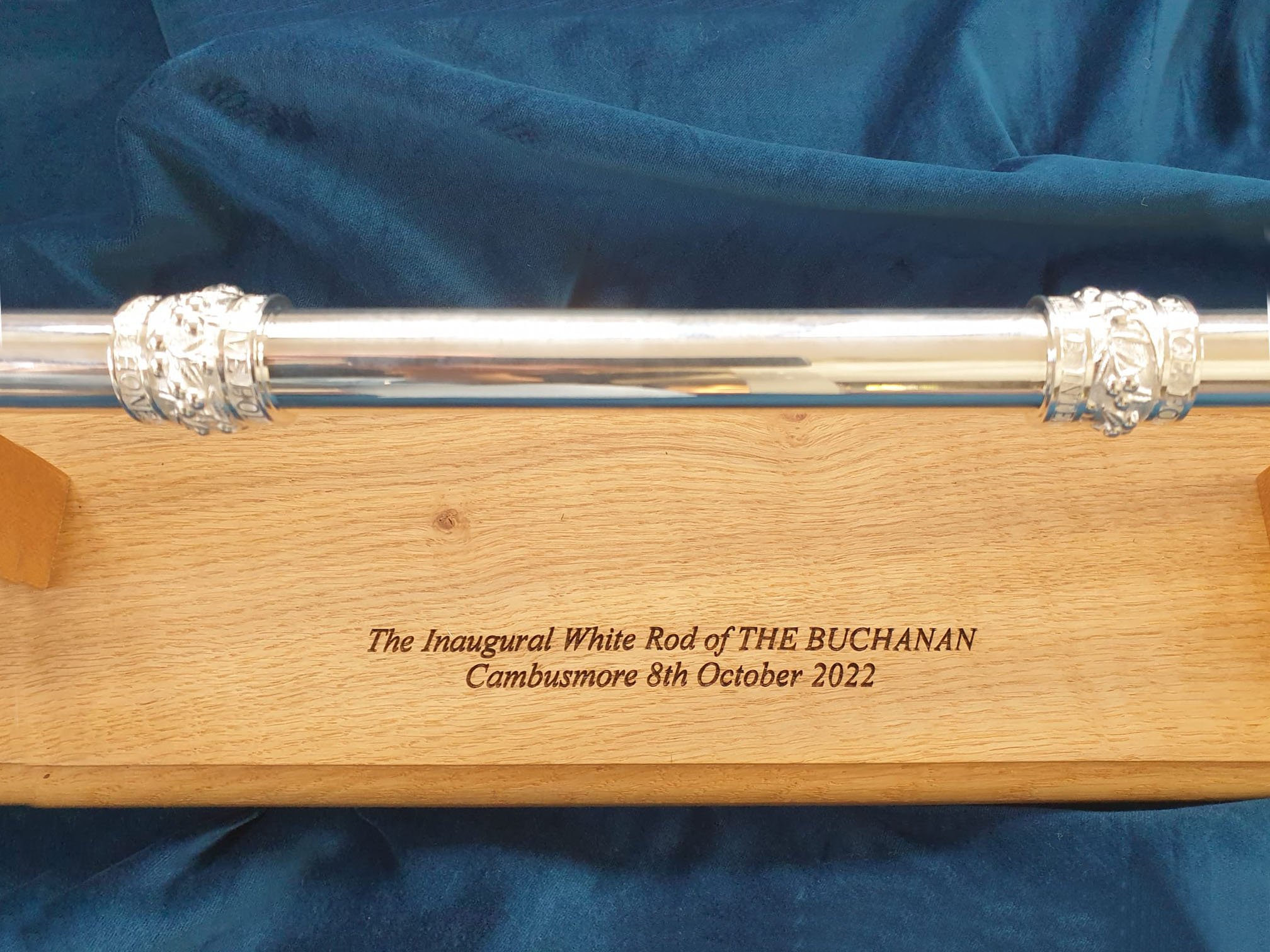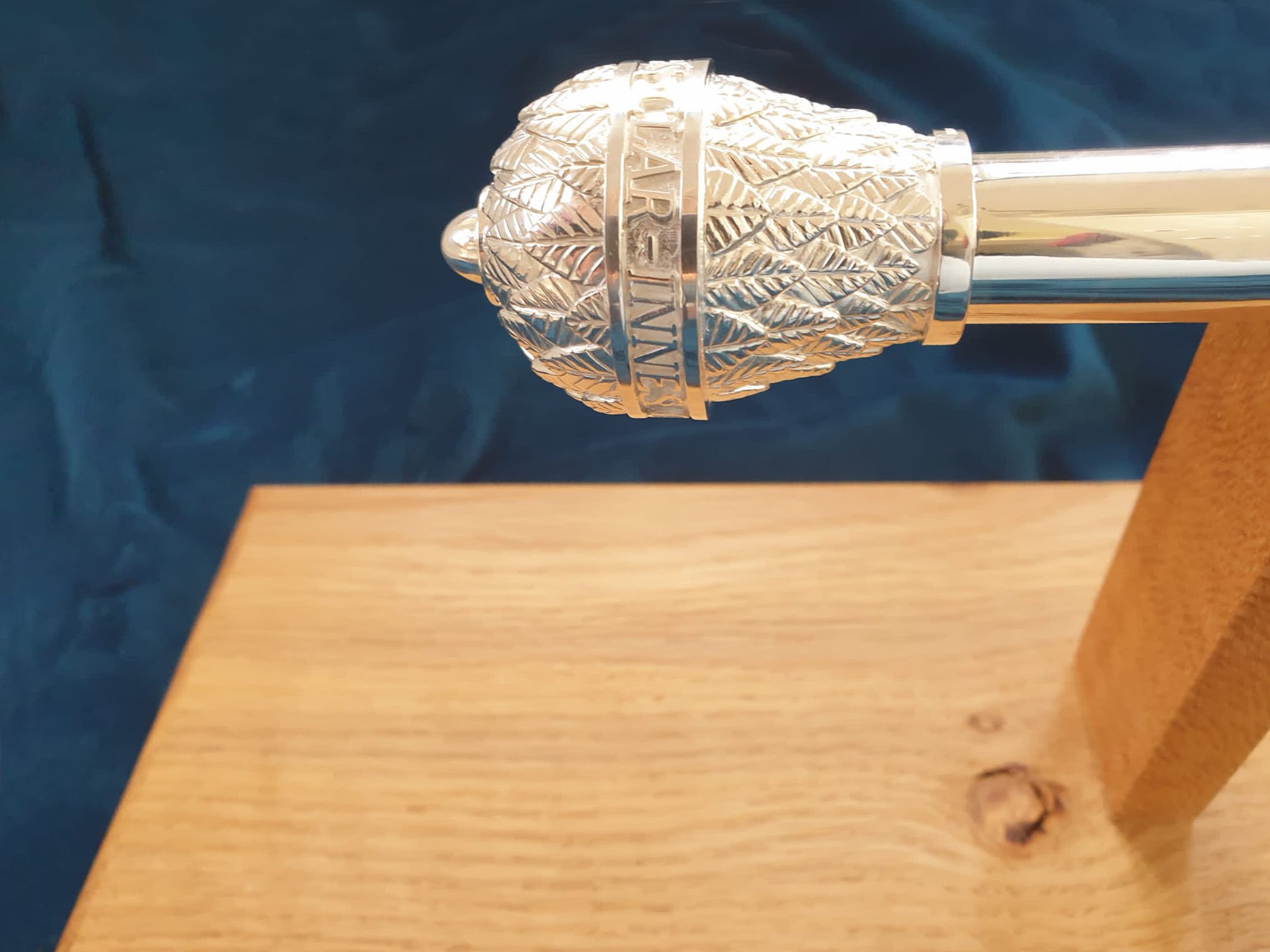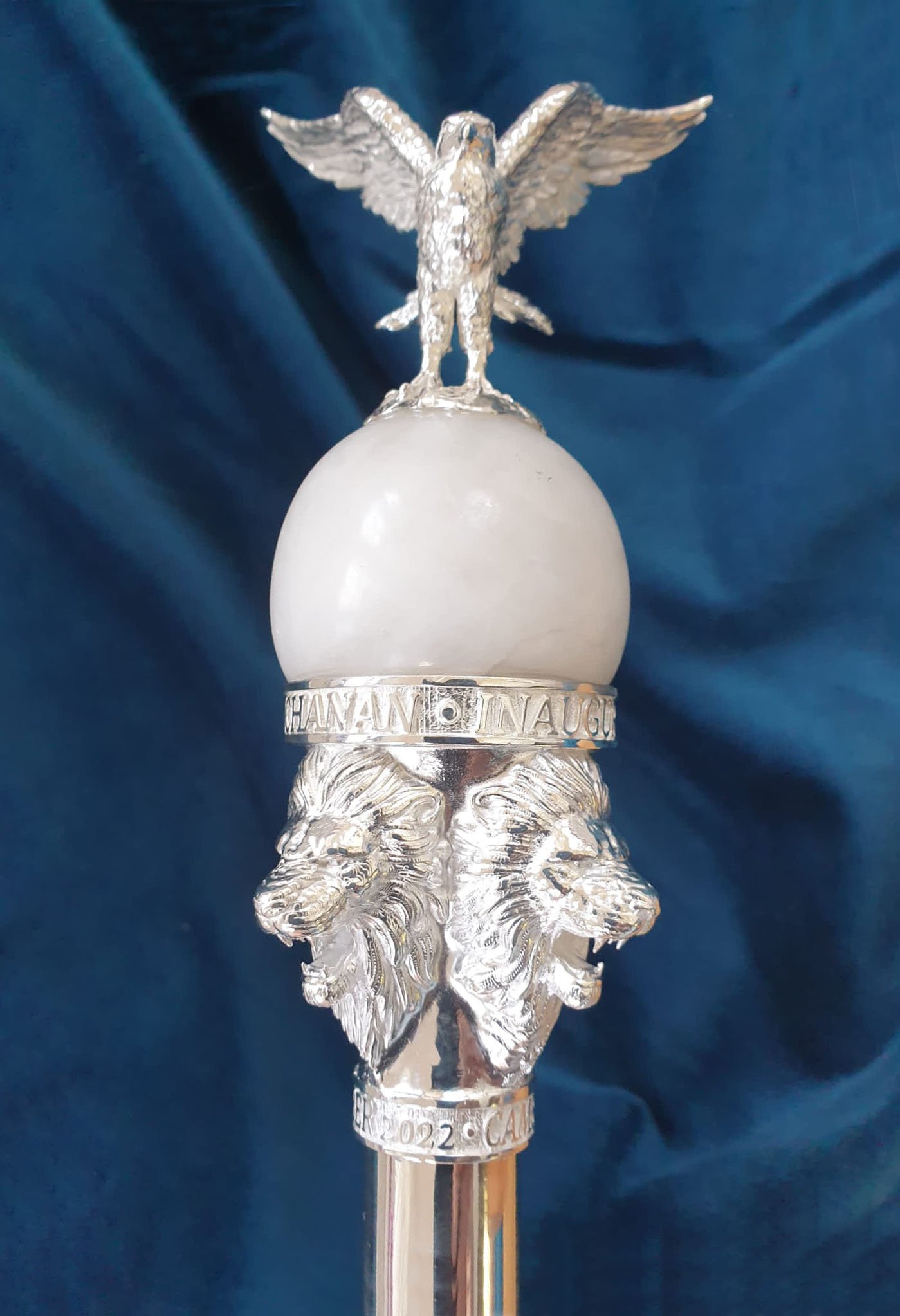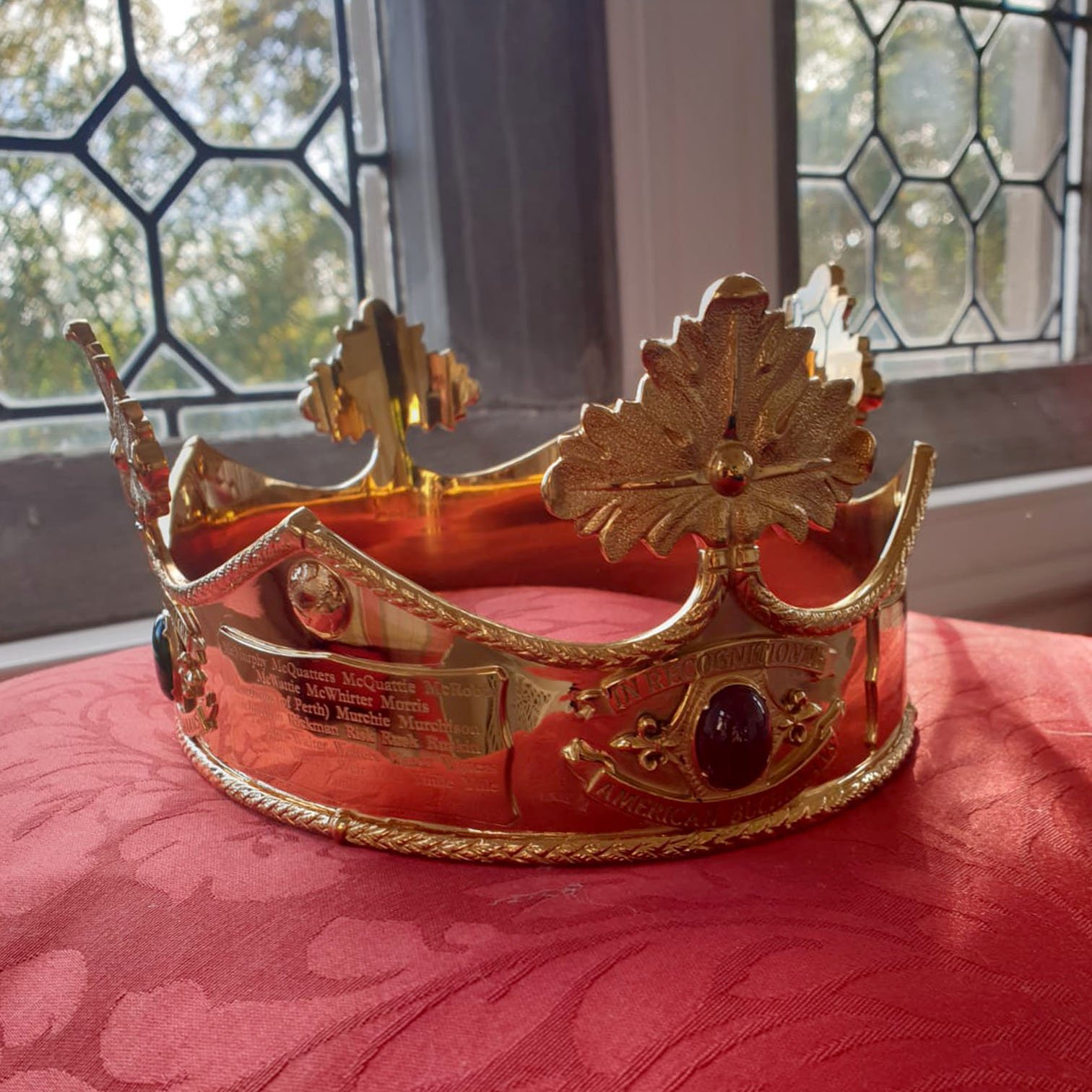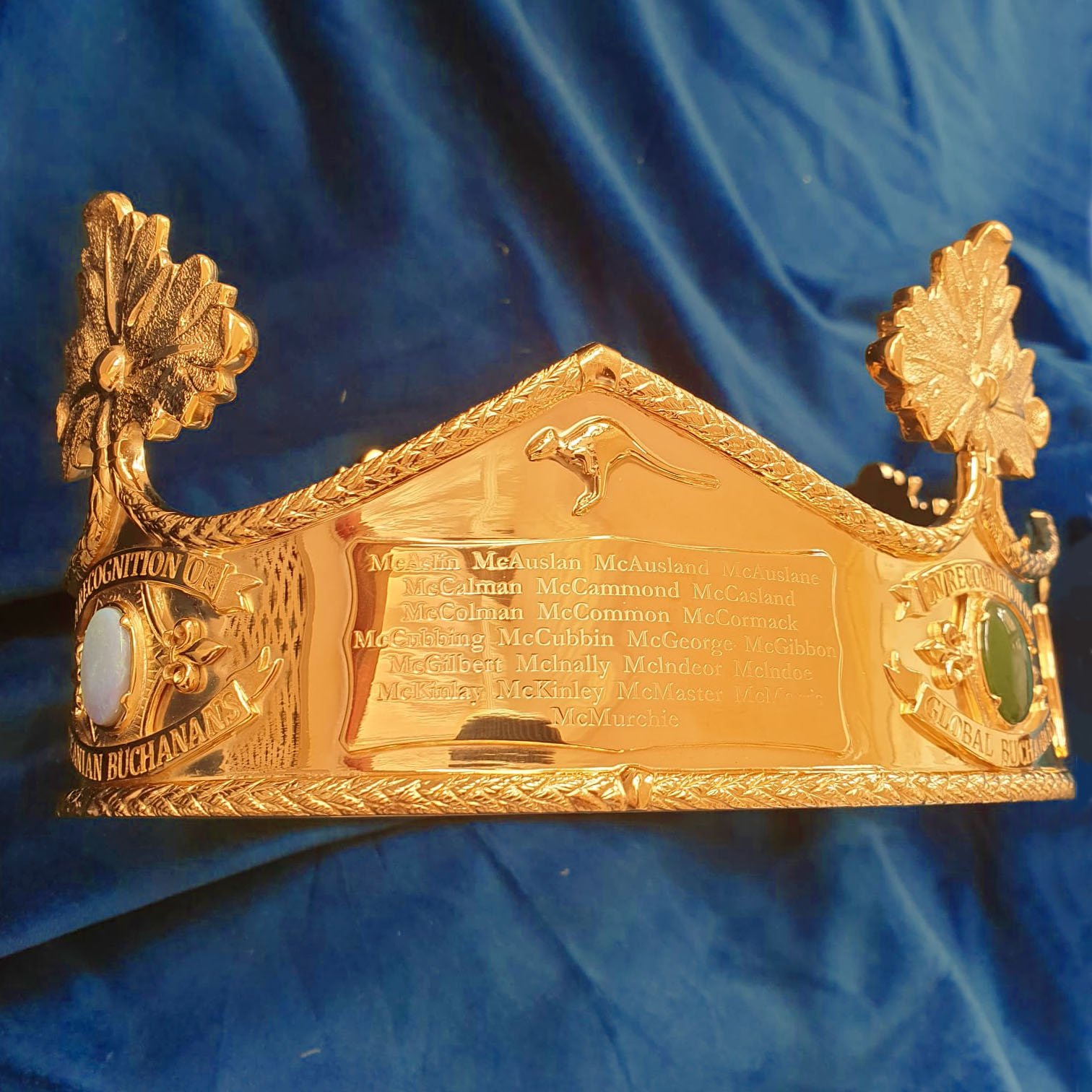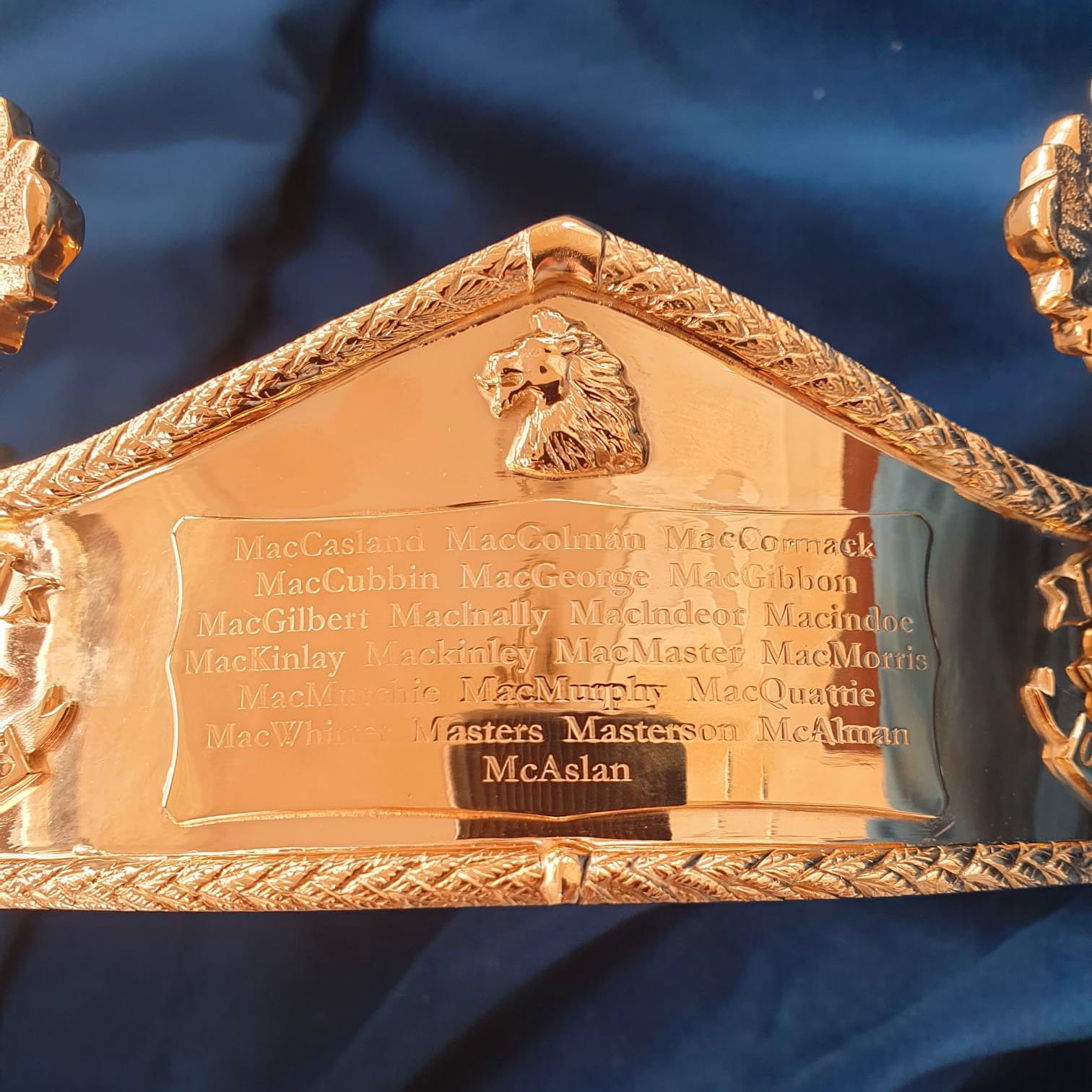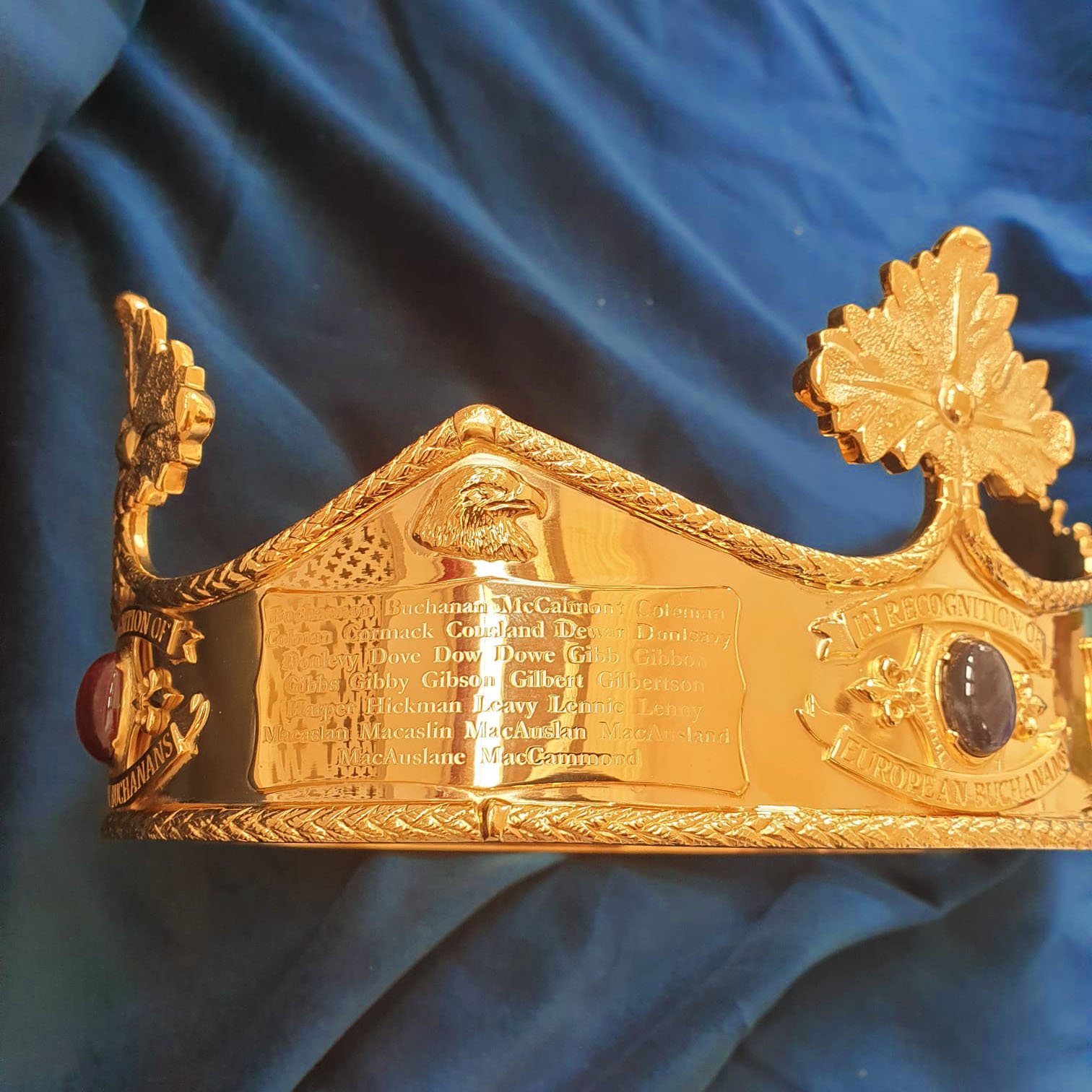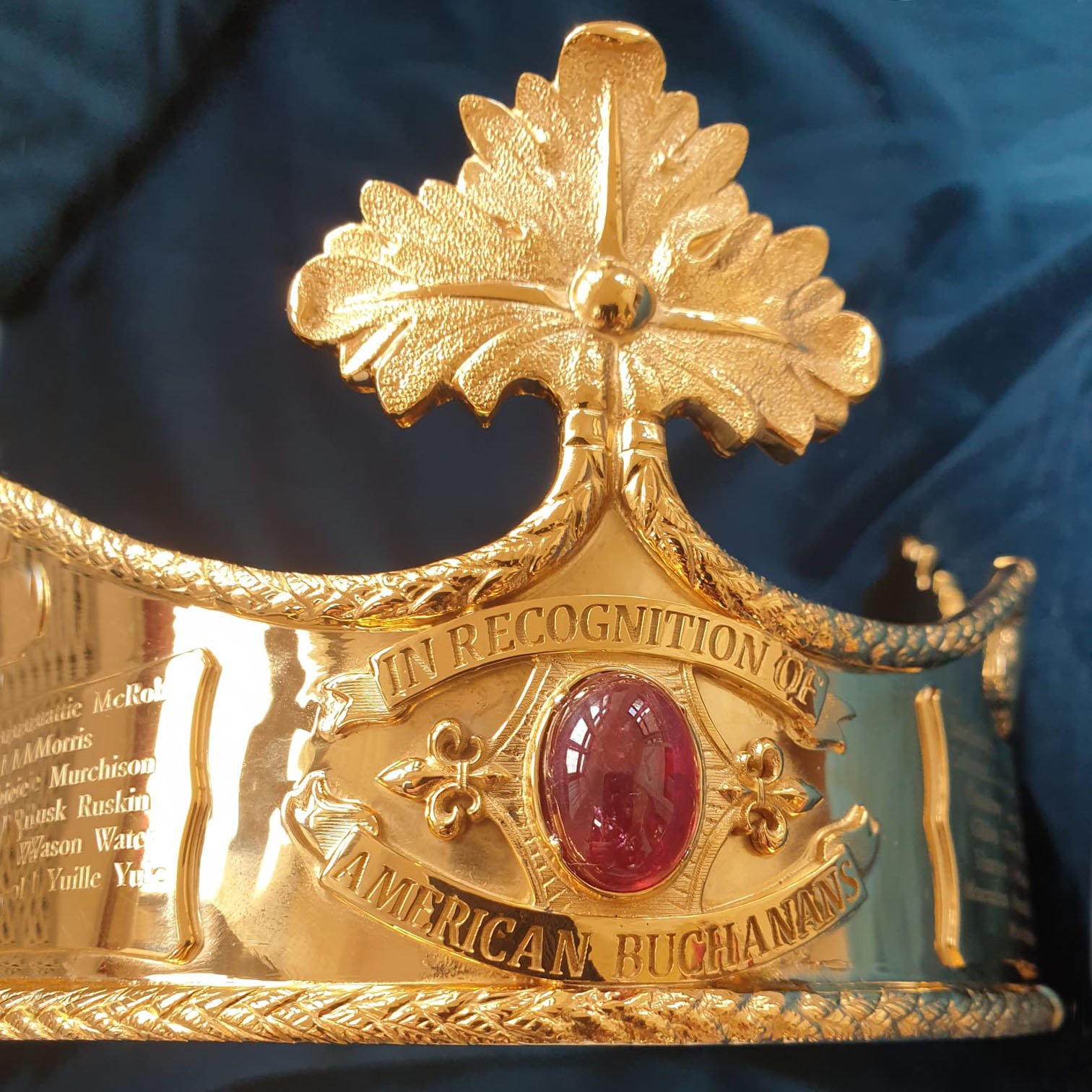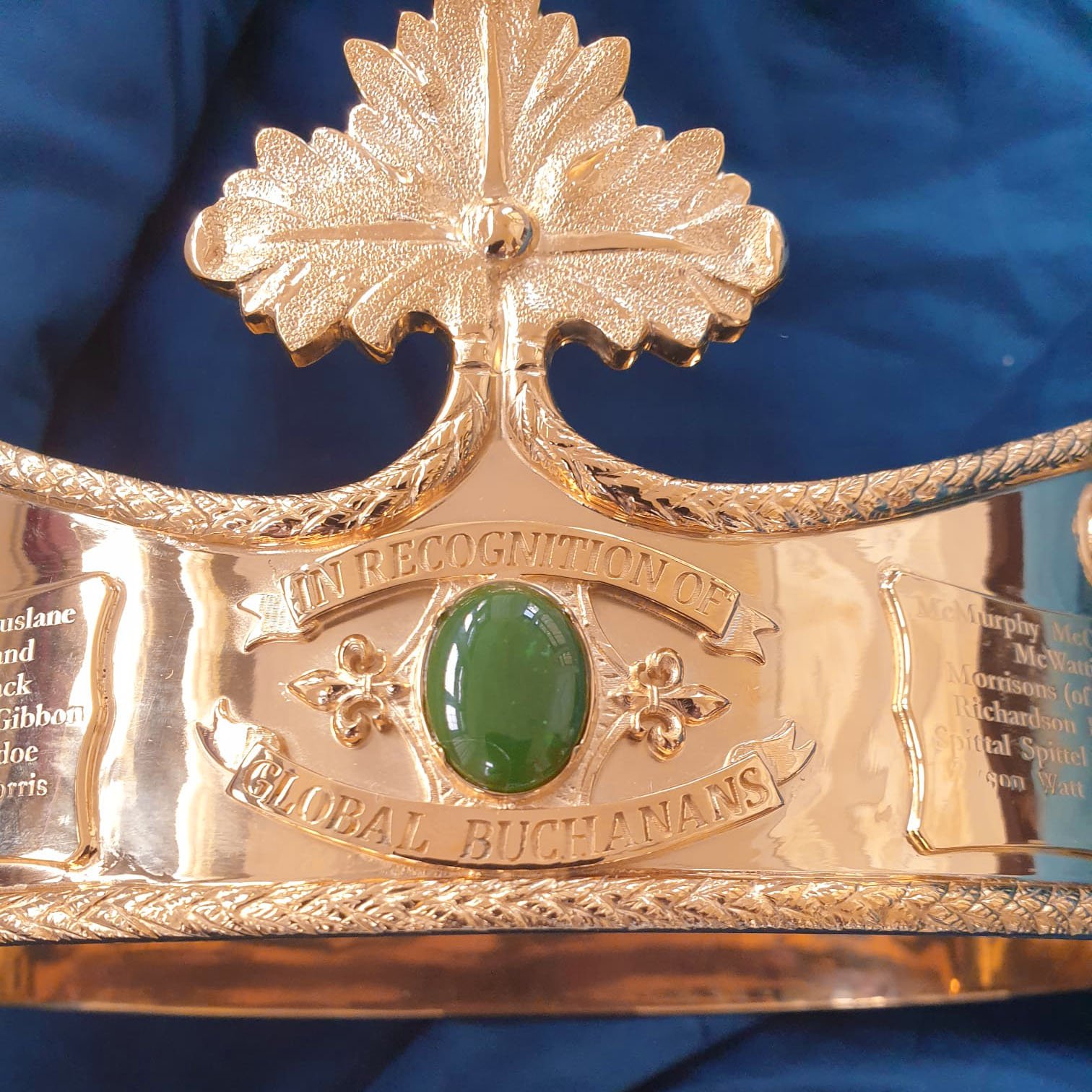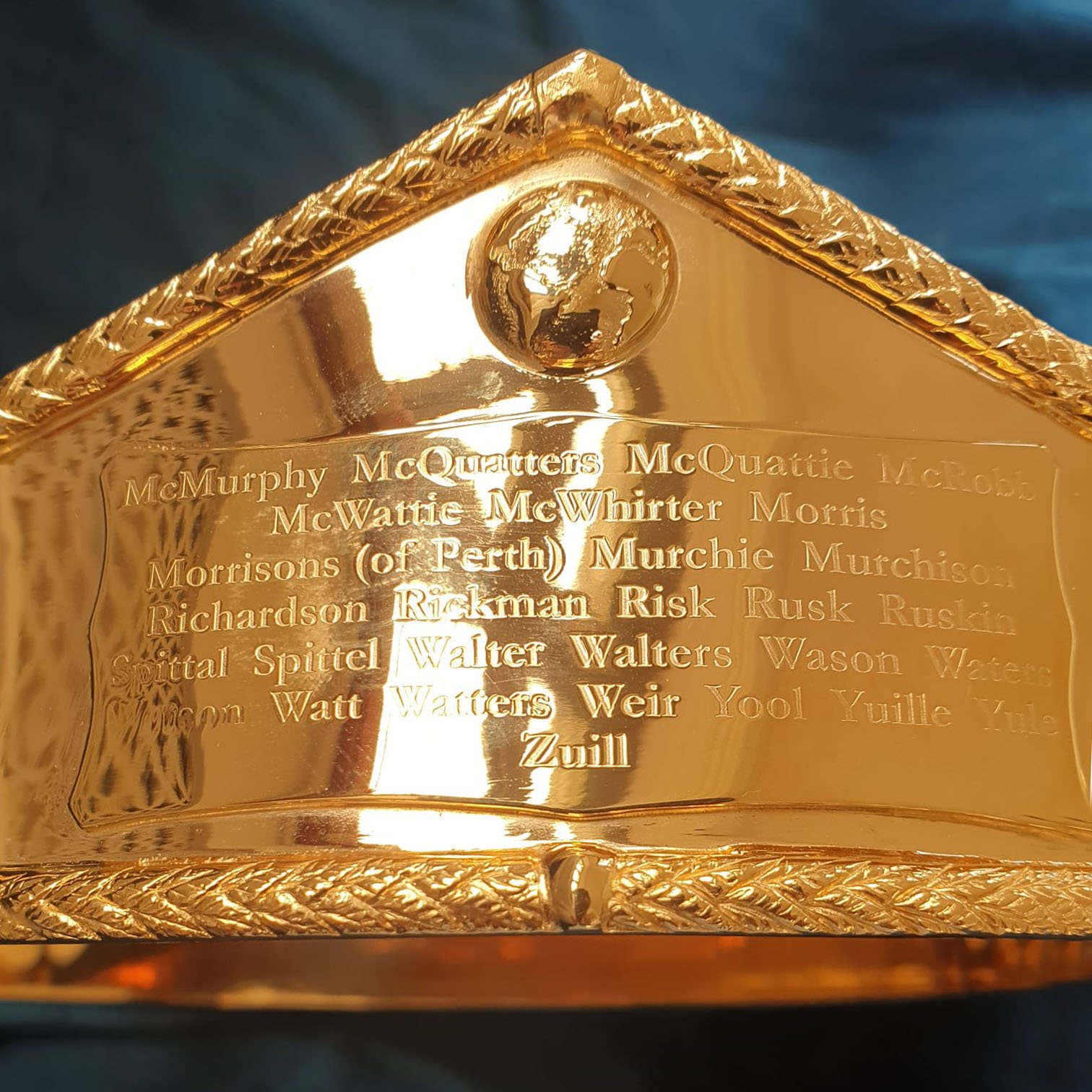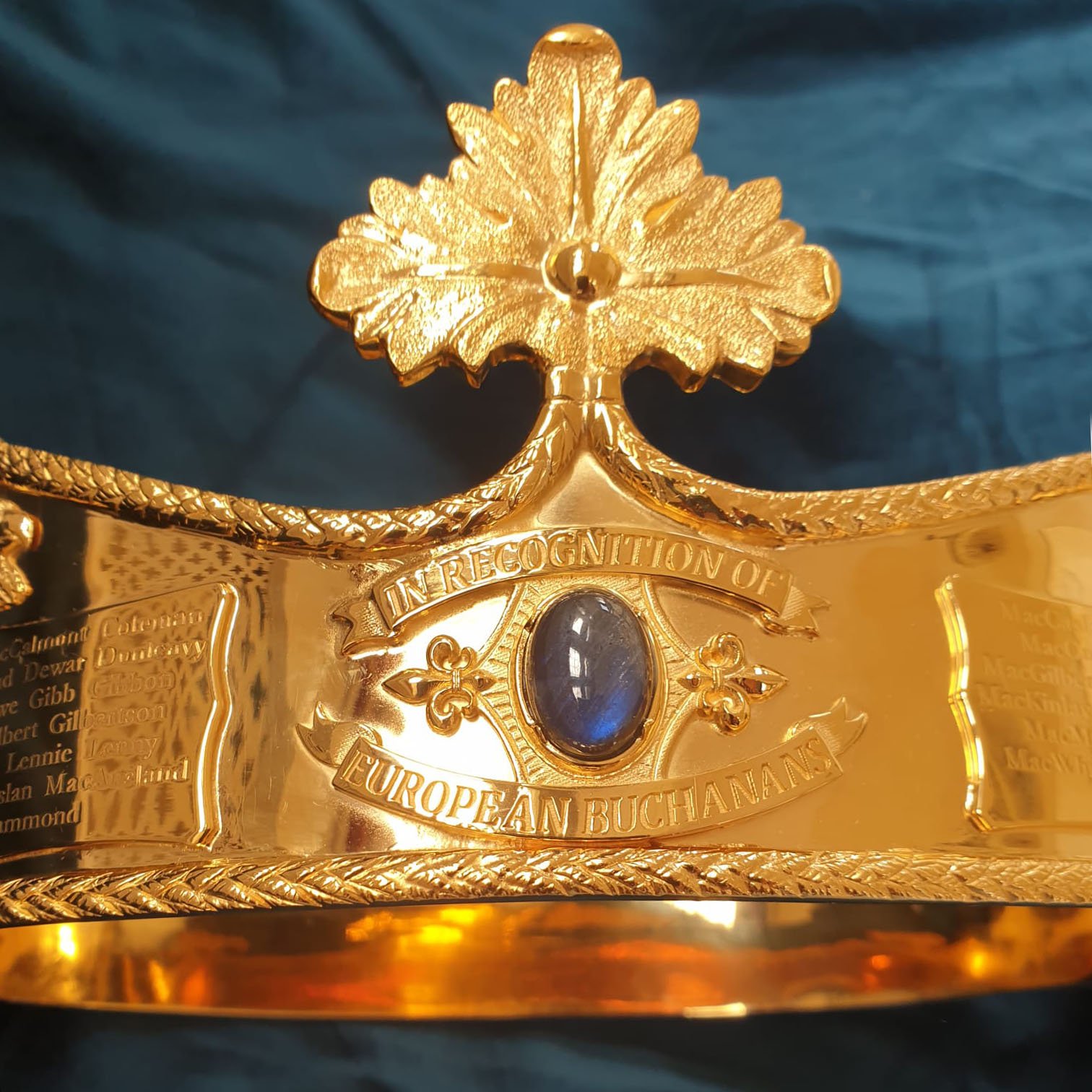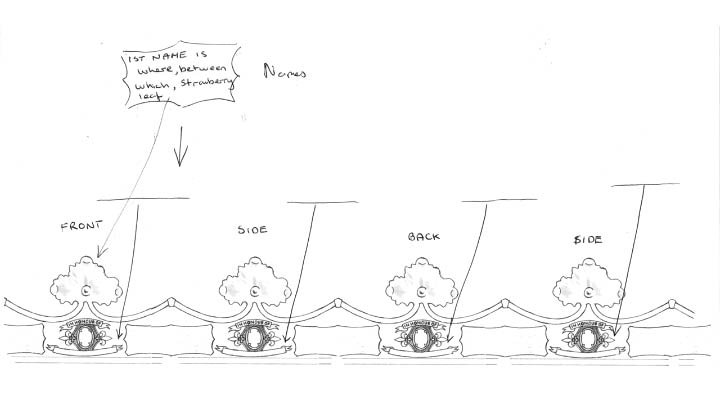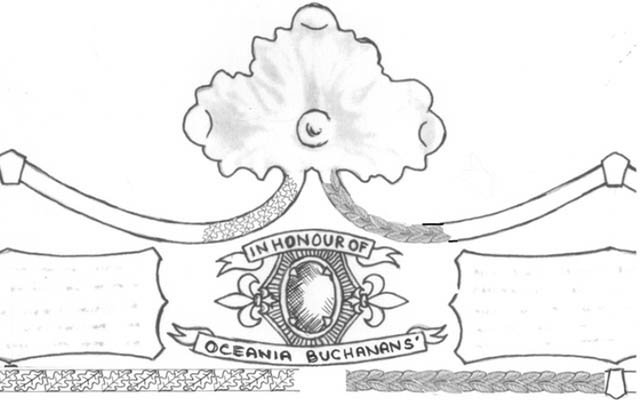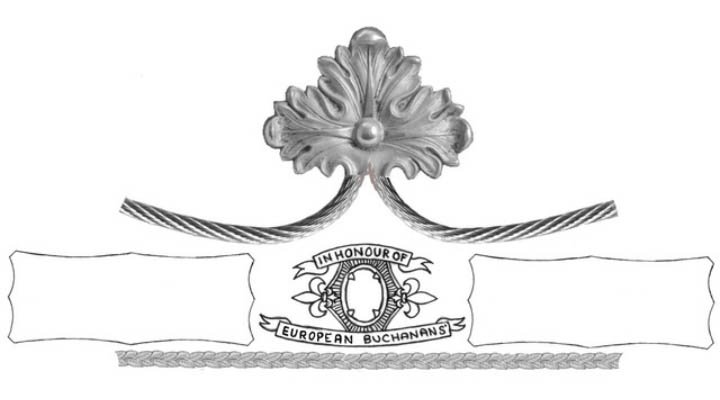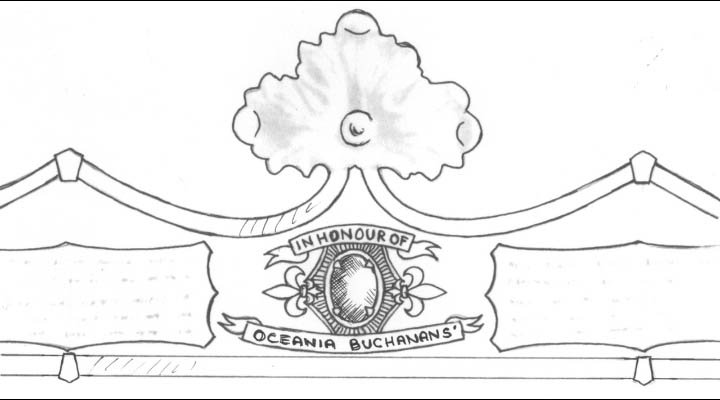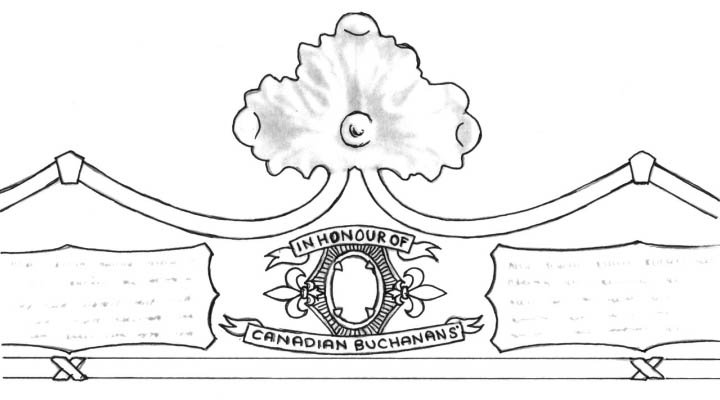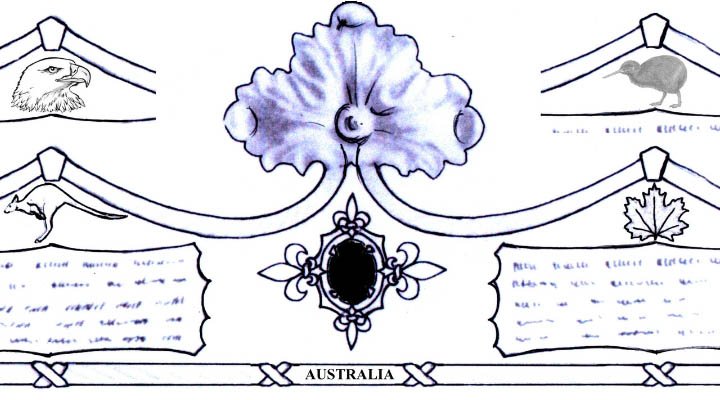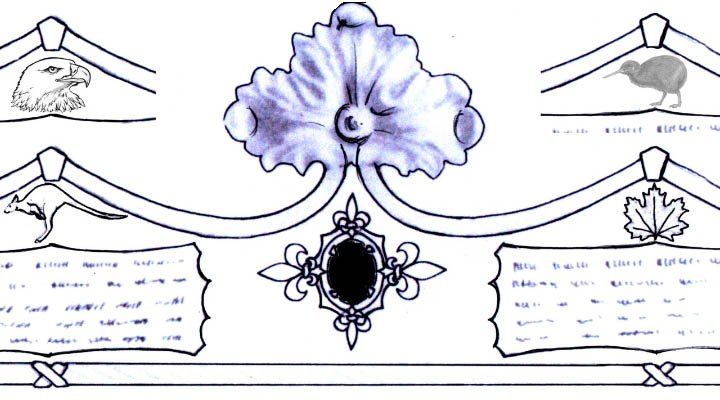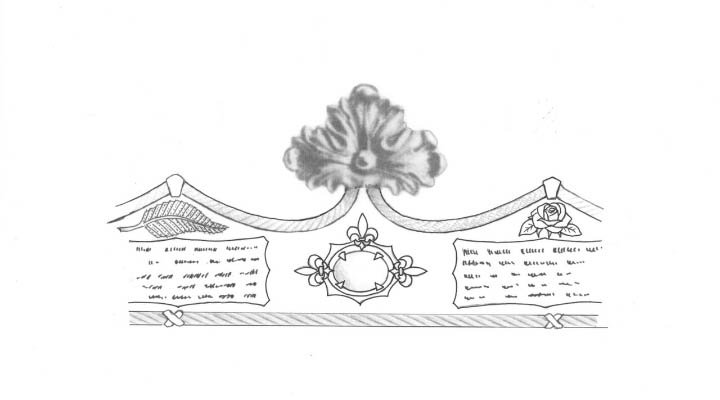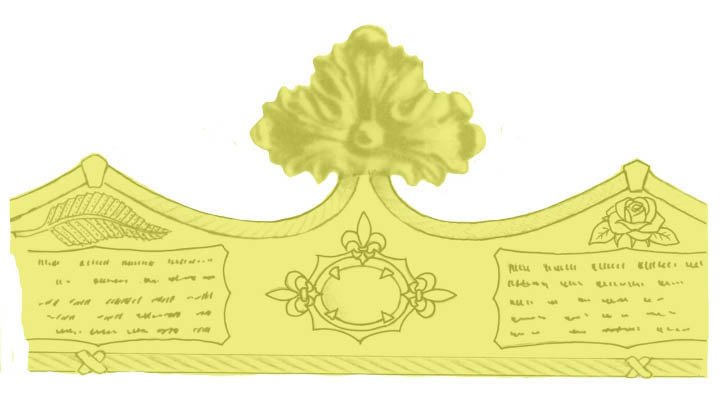BUCHANAN CLAN JEWELS
CREATED / RESTORED FOR THE CHIEFS INAUGURATION
Much care has been taken by Scottish craftspeople to create a set of inauguration regalia. Many items include semi-precious stones sourced from Cambusmore or from historic Buchanan family lands.
These have not only been gathered or recreated to support the Inauguration ceremony, but they are also intended to act as symbols to revive the importance of key elements of Buchanan histories to current clan life. They will be the focus of all the future inaugurations as well as other major Buchanan events held at the Clan Seat.
Why have we created all these things?
One of the consequences of the absence of a Buchanan Chief (since 1682) is that we sadly have large gaps in our Buchanan Clan’s ceremonial past and insignia heritage. The lack of clear succession left by the last chief, resulted in both the physical loss of all the ancient Buchanan family charters and any accompanying insignia. The charters seemingly stayed with the building and were fortunately put into the National Museums of Scotland’s collections by the Montrose family who now own the buildings. With the insignia largely gone, any ceremonies created around their presence, were also lost.
Things got worse after the failed Jacobite uprising in 1745 and the Highland Clearances (laws designed to suppress and break up all aspects of clan culture – under pain of imprisonment, death or deportation). With the Buchanan of Leny and Arnprior being the treasurer and armourer for Bonnie Prince Charles’s Jacobite army, our family were very much in the front line. It is not surprising that following Francis’s execution at Carlisle, all our family’s own Insignia (such as the small ancient silver Leny Sword, which acted as a charter), was confiscated by the government.
And not only were our artefacts lost, our ceremonies and customs were lost too. Many of these laws were rescinded 40 years or so later (enabling trades to be restarted, such as the recreation of tartans). However, the passage of time and the absence of a Chief’s court and insignia meant many of the oral traditions, ceremonies and experiences held by a clan and its members, were lost forever.
So, The Buchanan family have recreated and resurrected these artefacts to continue and renew our clan culture !
The manufacture of most of these new jewels was project managed by Roddy Young, silversmith of Inverness, plus he designed and sculpted all the silverware.
-
The Inauguration ceremony appears to have developed over ancient tribal times from the Picts – LEARN MORE. There is evidence that they settled in the traditional Buchanan land areas approximately 7 thousand years ago . Earliest records suggest this early Celtic/Pictish tribal blood very much runs through our veins!
Picts were a society which celebrated totemism. This means that sacred objects, symbols, historic items, served as emblems for tribal family groups. These symbols, which were often carved in stone or made from natural materials, not only preserved a tribe’s experiences with certain animals (which came to represent each different tribe/clan), but also preserved historic events and their leader’s family lines. Items on which the symbols were carved on have also themselves been described or regarded as insignia.
Pictish society did not have a written language; therefore physical items played a major role in their world and every day lives.
-
Insignia are defined as a sign or token of something. They include a range of objects made and used by clans to create symbolic images. Also, certain historic or meaningful items in their own right can be viewed as insignia, as they themselves represent a symbolic meaning to the tribe.
These insignia tended to be made from stone or other natural materials, but as time moved on these insignia started to be made of metal and other different materials. Insignia were a very practical way of preserving important individual clan symbolism and unique experiences. They were of utmost importance to the whole clan as they symbolised not only its identity, but its very essence.
Objects commonly depicted included trees, plants and animals, possibly as a result of a clan’s particularly experiences with these plants or animals in an area where they lived. Early animal symbols carved into stones as tribes often used animal symbols to represent the spirit of the clan, such as the stone 5000 to 6000 year old images of deer antler stone carvings found recently in Argyllshire. There are many other stones which have carved lines and patterns, but few now understand what they mean. Some have supposed they indicated the family lines of the clans’ leaders.
This is a precursor to heraldry, LEARN MORE
To understand what things were important to a clan, you need to look at what acted as Insignia and what it was that gave them special symbolic meaning.
-
In early days, the use of stones as forms of insignia were widespread. Stones ranged from being either large rocks out in the open or smaller ones made into chairs or other objects.
Antler and bone would have been available from the start not only being an important part of early Insignia, but they could also be used to represent the animal itself.
The availability of wood would have made it a popular choice for an Insignia. Again, even the type of wood chosen could be symbolic.
Early insignia such as stone or wooden clubs will have progressed into weapons made of metals as these materials started to be introduced. These not only allowed the symbolism of a weapon but also enabled early writings to be engraved on to it.
There may have been more objects used as insignia at this time, but the lack of written records and the passage of time will have destroyed the most fragile ones, leaving only those made from the hardiest materials.
-
Over the millennia, the type of insignia changed and evolved reflecting the evolution in materials and manufacturing.
This can be seen in changes in symbolic items related to our family. Early objects showing the ownership of Clan lands in ancient times included the ownership of the Leny estate lands ‘by virtue of a small sword’ and tooth of the saint, St Fillan’s. Now land ownership is in the form of paper charters and more recently online documents. All these forms of information are symbolic and have their own meaning in their own times.
Also, contemporary society influenced the type of insignia produced. Early tribal and Pictish forms of insignia were mainly symbols. However, when Pictish ways died out and when writing materials became more commonplace, clans started having more written form of insignia. At this point there was a gradual switch to written symbols.
This gradually reduced the need for the possession of the actual physical insignia as physical insignia could then be represented by drawings or writing. The rise of writing has led to the redundancy of actual objects as the need to be stored and kept safe carries a cost, consequently many of the actual insignia are now lost, or in museums.
-
From what can be seen, this passage of information about the lives of generations of families living in a clan in a certain area is reflected and preserved in the modern heraldic emblems used today. Indeed, the early symbols provided the basis for modern heraldry as we know it. They form the basis of the real differences making up clan’s heraldic arms.
These reflect different clan’s experiences, and stories. These symbols are often those found from those seen in a tribe’s ancient insignia. Indeed, even images of the insignia used at key ceremonial events themselves, can be used and seen in modern heraldic arms.
As such, early tribal insignia, played a monumentally important role in preserving a clan’s unique early clan traditions, stories and symbols. Without these early insignia, Scottish heraldry as we know it would probably not exist due to the ancient Pictish custom of not writing down histories.
-
Possibly the most important event in a clan’s early history was the succession. Ensuring a smooth successful succession was indeed key to a tribe’s very survival. This appears to be reflected by the presence of specific Insignia either made for this event or historic items preserved for it. These typically included an historic sword, a stone with symbolic carving and a white rod, a crown or other similar headwear and some form of item indicating the leadership lines or heritage, like a seal or a particular wood or stone carving.
The importance of the inauguration is also indicated by the amount of time, effort and expense made by the tribe in support of the people.
The ceremony would be guided by the Seanchaidh (Scots Gaelic, Anglicised: Seannachie, pronounced “SHEN-e-KHEE“), the clan’s historian, keeper of tradition and genealogist, whose main job in life was to orchestrate and enable these ceremonies to take place. A major part of the Seanchaidh’s role was to memorise their Chief’s entire set of ancestors. So, when a leader died, they would be able to effectively determine who should be the next one according to their laws on succession.
We understand that in early times, stones were used as the place for that tribe to gather for all their most important events, such as the Chief’s Inauguration ceremony. In this ceremony, the Chief usually stood on the stone (or sat on it as a chair) while the ceremony itself was taking place.
-
Obviously succession would occur following the demise of a chief; facilitating his Younger to ascend.
A key element of the inauguration was validation of the new chief. A way to achieve this, involved the passing of the former clan leader’s precious insignia, key items bearing the tribe’s emblems of office and honour to the next leader. The wearing of these succession related Insignia provided a visible form of succession. The symbolic importance of these insignia were used to carry the fact that while individual faces may change, the whole identity and meaning of the tribe/clan continued as before.
This Inauguration event was vital not only in helping to maintain tribal stability though these early dangerous times but in providing continual effective leadership so the tribe could defend itself against hostile outsiders. As such these inauguration insignia bearing images of the tribes’ important animals, and other symbols of a tribe’s history and previous leadership, conveyed powerful meaning to not only those who saw them within the clan but also outsiders. They also helped conferred to those who wore them their new serious responsibility of protecting and defending a tribe’s identity, existence and future.
-
The symbols found in modern heraldry represent the spirit of a clan and its individual history. Within clan Buchanan we have bears, boars, falcons. and of course, the Rampant lion.
Older clans will have acquired more history, having existed as a tribe for a longer period of time. This is often reflected in their more numerous number of symbols found in an older clan’s Chief’s heraldic arms. Plus older families tend to be larger, have more lines and therefore a more extensive set of heraldic symbols.
What we do have is revealed through Buchanan heraldry
The age of Clan Buchanan could explain the presence of bears in our early Buchanan Chiefly heraldic arms (circa 1445). Despite bears being absent from Scotland for well over 1500 years, perhaps the heraldry originated from the presence of bears in earlier tribal insignia, made by ancestors familiar with these animals. This early heraldic representation of the early Buchanan clan being a ‘bear clan’, appears to have originated in our earlier Buchanan of Leny arms, potentially reflecting the earlier origins of the Buchanan chiefship through the female Leny of that Ilk line.
Buchanan representation in the Scots Roll in 1455, include a lion rampant and Bear.
Connection to the Rampant Lion is described in our connection to Robert the Bruce through marriage. READ MORE
The last Chief’s full achievement (coat of arms) was fortunately registered in the newly formed Public Register of all Arms and Bearings in Scotland (“Lyon Register”), established in 1672. We also have wax imprints of some of the early Buchanan seals made from around the 16th and 17th century, made from different Buchanan family members held at the Lord Lyon office. These include a range of symbols, although sadly some have melted or deformed over the years.
Together they help us to build up an idea of the previous key symbols for our Buchanan clan through the years.
Walter Scott’s preservation of Buchanan heritage
In the 1790’s, a young student known to the family as Wattie (AKA aclaimed author Sir Walter Scott), used to stay Cambusmore in his summer holidays with his best friend John James Edmonstone, a nephew of John Buchanan (our chiefs direct ancestor).
By his own written account in his Biography, Wattie said that he enjoyed spent many hours at Cambusmore listening to John Buchanan of Arnprior, recalling his very many Buchanan ancestors’ achievements and history. This included the events of the ’45 and the earlier Jacobite battles and many skirmishes the family were personally involved with.
Fortunately, many of these stories were written down in a wee book we still have at Cambusmore. Unsurprisingly, many of these oral histories appeared to have found their way into many of his most famous ‘fictional’ works, such as the Lady of the Lake. Indeed, the heroine of which appears to have been based on Helen Buchanan, one of John’s daughters as she was the one who first showed him the local lake featured, known as Loch Katerine.
Sir Walter also appeared fascinated with symbolic items, and due to him, this book lists many ‘insignia’s still in our family, but also some of those lost. In this way he personally helped to preserve not only our Buchanan family’s personal histories but also significant symbolic items, which could easily have been lost.
The Buchanan Seat
HISTORY
The Buchanan Seat is a stone chair carved with the Buchanan's arms on its back. Stone carvings have been used for inauguration events for many centuries. An example of this is the Hay’s clan’s falcon stone. The Hay’s falcon stone acted as a place where ancient Inaugurations and gatherings would have taken place. Not surprisingly, a falcon is in now preserved in this clan’s crest badge.
As a clan stone appeared to be a key element of not only inaugurations but also all early tribal clan gatherings, we chose to use stone for the chair to reflect this ancient past. We were fortunate to have the talented local stone mason, Adam Innes with his father James as seen in the photo above to have created this amazing chair for us.
RESEARCH
Featuring the chiefs crest, with the clan motto “CLARIOR HINC HONOS”, the side panels feature the fleur de lis from the Buchanan's arms.
The bear heads on the outside back of the chair symbolised the links to the ancient pictish Buchanan of Leny family line — placed on the back as it reflects the past.
DESCRIPTION
Made from Woodkirk stone. The seat is 118cm tall, 61cm deep and 75 cm wide.
It weighs a lot — 370kg (815 pounds)! To move it, panels need to be unscrewed and the pieces taken separately to where it needs to be; then reassembled. This is obviously something which is not done on a whim as it takes several people to achieve.
Stone maisons
MANUFACTURED BY
Adam James Innes of James Innes and son. Adam Innes is a partner in his family's 6th generation stonemasonry company that was established in 1850. He was classically trained in stone sculpture at the City and Guilds of London Art School and works on sculpture and construction projects throughout Scotland. The company based in Edinburgh and Doune (only a couple of miles from Cambusmore).
A stone suitable for carving was selected by Adam. His knowledge of Scottish stones was key to the final result as not all stones can be carved with such intricate designs. Firstly he created a clay sculpture of the coat of arms. Then he used this to sculpture the arms as seen on the inside back of the chair.
MANUFACTURE PROCESS
The process of creating this piece was done in a very traditional fashion that has been carried out for hundreds of years.
Adam came up with two different designs that he thought would be suitable after thorough research.
OPTION A was a Gothic styled chair with the crest on the back of the chair and falcons on the arm rests.
OPTION B (selected) was a medieval styled chair with a large coat of arms on the back of the chair and fleur de lis on the side of the arm rests.
Adam did a lot of research on historical designs of the Buchanan Coat of arms. He finally designed his own version of the Arms which shows heralic form but still has a natural essence. This was then drawn full size to scale and approved by The Buchanans.
The Drawings were transferred onto a clay board to create the line of the coat of arms and Adam modelled the coat of arms in clay. The clay model was then used as a template for the hand-carving of the stone with chisels.
The chair was then constructed with threaded rod and bolts.
Ready for Inauguration
CUSHIONS
We initially thought about making the cushions in the inauguration tartan. However it occured to The Buchanans that the robes of the pictish 'Inaugurators' (i.e. those who Inaugurated a Clan Chief), were originally red. This is possibly why the Lord Lyon's official coronation robes are red, reflecting the fact he is the Inaugurator of the monarchy. As such we thought red would be the best colour for not only the cushions for the seat, but also the cushions on which the clan jewels would be placed for the ceremony.
HOW WE’LL USE IT
The seat will be used for all future inaugurations. It will stay at Cambusmore in the 1st floor tower room, as seen in the photo to the right.
This chair is at the current home (centre point) of the Buchanan Clan, being the home/hearth of the Buchanan Chief. So it is symbolic of the home of the Buchanan clan from what I have read from Frank Adams's book.
Sword of Leny
RESEARCH
A claidheamh beag or claybeg. Recreation of the Sword of Leny, circa 971
The replica sword of Leny, click to enlarge
This small silver sword, formerly having been described as being of Scotland and Leny, is one of the earliest known symbols of Investiture of a clan chief in Scotland. It is found on the Buchanan of Leny and Buchanan of Arnprior’s coats of arms.
For the early Leny clan, their possession of this small silver sword, symbolised their ownership of the Leny lands before written charters existed. The original will have served as a key Insignia item, used in the earliest of clan ceremonies.
This sword has many meanings. The engraving on the side names Gillespic Moir, the then head of the Leny of that Ilk. He was presented this sword by King Culenus about the year 965 as a form of charter of confirmation of lands which Gillespic Moir and his family had previously owned since earliest times.
Unfortunately, it was in the Buchanan of Arnprior’s charter chest, which was confiscated after the Jacobite uprising. Whilst there was a published drawing of the pieces of this small sword, the original has never been found.
So, we chose to make a replica from the drawing, using materials it was likely to have been made from, although another replica is in possession of Frank Clark (see the letter from Mr Davis H Caldwell of National Museum of Scotland for details).
DESCRIPTION
The curved nature of the blade seen in the drawings was surprising as we are more used to straight blades. However further research showed that in the early days when this sword was created, some blades were indeed curved.
18 cm long / 7 inches (we did say it was the small sword)
Stirling silver blade with cast handle
MANAFACTURED BY
Roddy Young, Inverness based silversmith
The process was:
Artwork and brief supplied
Agree to the designs
Confirm details, like the lettering
Computer aided design - CAD
Freehand carving of bone to produce copy of handle
Make mould of the blade
Wax casting of the blade
silver casting of the blade
Fabrication, polishing and finishing
HOW WE’LL USE IT
This will be used at all future inaugurations. It will also be a symbol of our very early pictish roots, showing our ancient historic link to this area. It reflects a real event and our historic symbolism and connection with short swords and early Scottish monarchy which has been reflected in many of our mottos, and those of other septs and related clans!
The source of our research
This was in the box of Frank Clarks Replica sword (photos below) and was originally thought to be a replica of St Fillans tooth, but David Caldwell (Scotland Museum) suggested that this was the swords pommel. And thus, we used it as inspiration to make the swords handle…
Another replica sword in Frank Clarks possession:
The Chief will also be rearing a small replica of the replica as a Kilt Pin…
Kilt Pin Sword of Leny
Roddy Young made an identical version of its larger brother, in exactly the same process.
12 cm long / 4.7 inches
Family naval sword
HISTORY
Likely to have been owned by Captain Morshead Buchanan Buchanan-Baillie-Hamilton circa 1894. In 1910 he was the captain of HMS thistle which went to China, where he successfully peacefully supressed the Hankow riots and was commended for his bravery.
This obviously shows a connection to the countries Naval forces.
RESEARCH
This sword has a historical link to The Buchanans and have been at Cambusmore for many years and are still in our family's possession.
DESCRIPTION
The naval sword appears to have a brass handle topped by a lions head, the mouth of which is where the hand guard appears to come out of, attached to which is a golden material tassle on a cord. The bottom outer part of the hand guard has the emblem of a crown under which is an anchor. The grip has a quartz lined surface with brass banding. The blade itself has a lovely etching pattern on the front and back of both its surfaces.
The scabbard has an elaborate brass pattern at the top and bottom, inbetween which is a layer of fine black leather. The scabbard is joined by brass and leather to a fine black leather belt which has a brass buckle with the same crown and anchor symbols in bas relief.
The sword itself is 82 cm long (32”)
HOW WE’LL USE IT
This sword will be used in the procession and ceremony at the inauguration. It will be carried by a sword bearer. It is important as it reflects some of the many military service roles that different members of our Buchanan family have played since ancient times to help keep our clan and country safe.
This artifact is of significance to the future generations as it represents the sacrifices made by many Buchanan family members in protecting their family and clanfolk.
5 ball spadroon infantry officers sword
Circa 1780 - 1790
It is likely to have been owned by Major Alexander Buchanan, 5th of Arnprior who lived at Cambusmore.
RESEARCH
This sword has a historical link to The Buchanans and have been at Cambusmore for many years and are still in our family's possession.
DESCRIPTION
The 5 ball spadroon infantry sword has a bony/ivory handle with verticle metal lines scored through it. There is a hook at the top of the handle and at the bottom of the handle is the hand guard which features 5 balls. The blade is quite rusted, but engravings can be seen all the way along it on both sides. The scabbard appears to be made of a black velvety material sewn together over a wooden frame, with some type of animal skin at the handle end of the scabbard and at the middle. There is a leather strap attached to the outside of the scabbard.
It is 94cm long (37”)
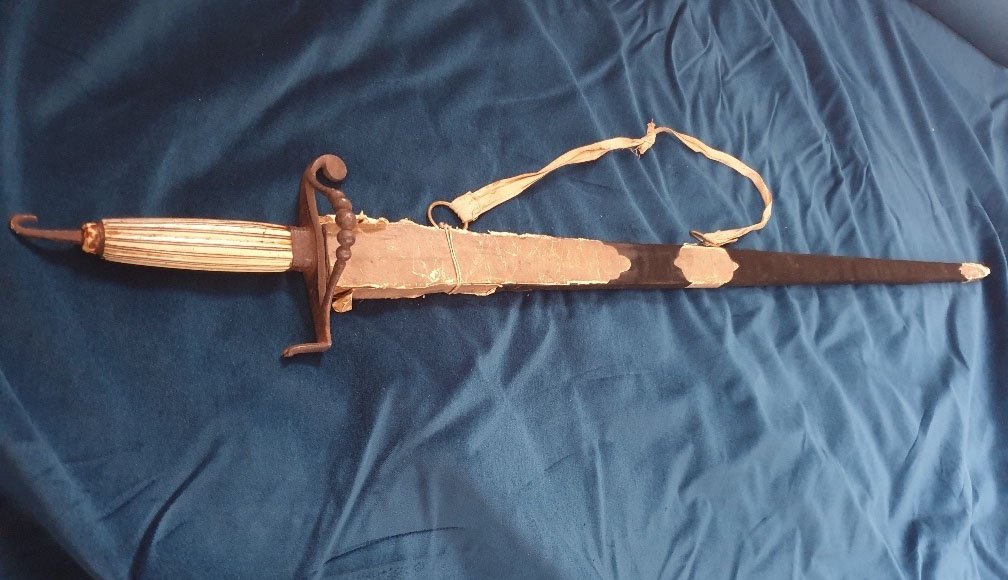
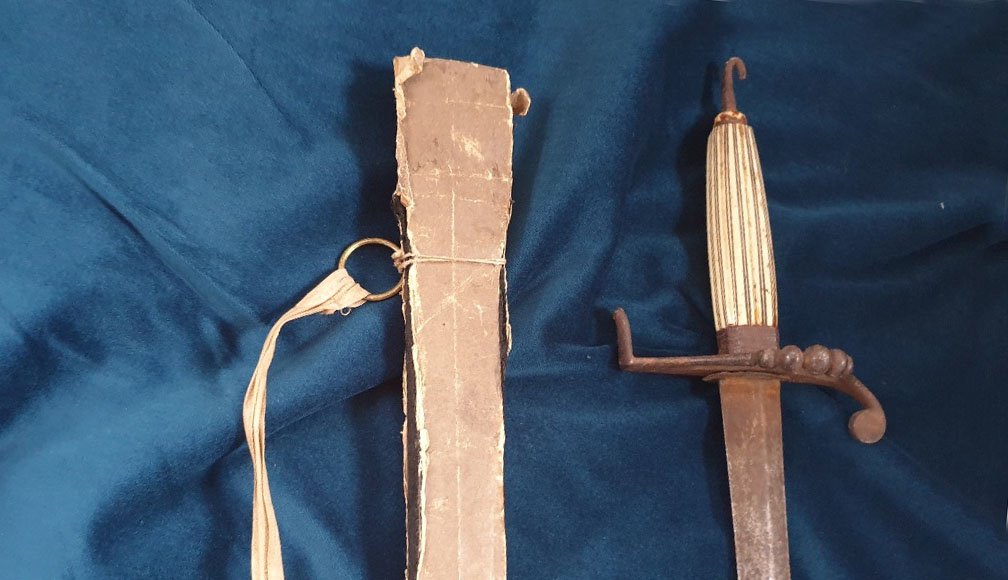
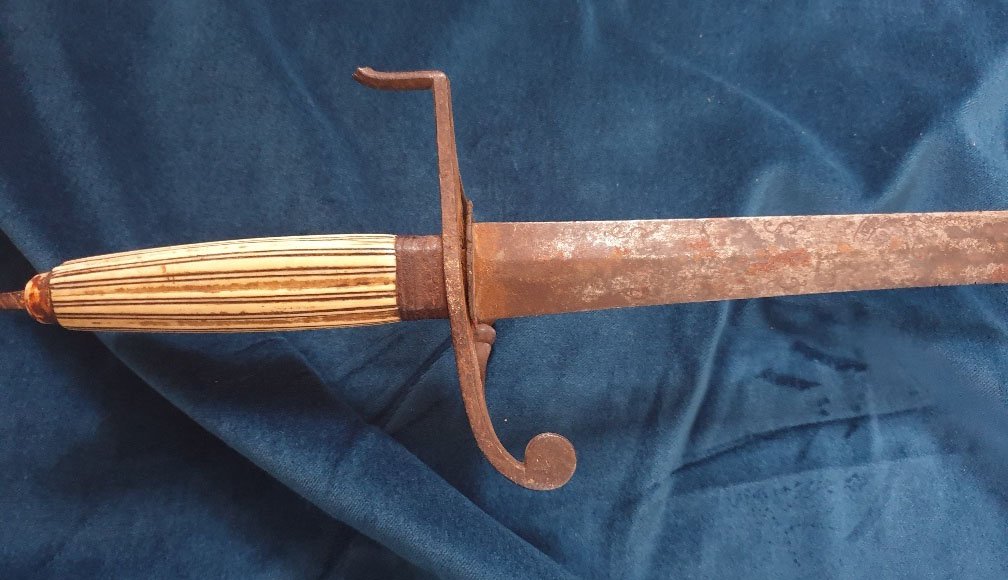
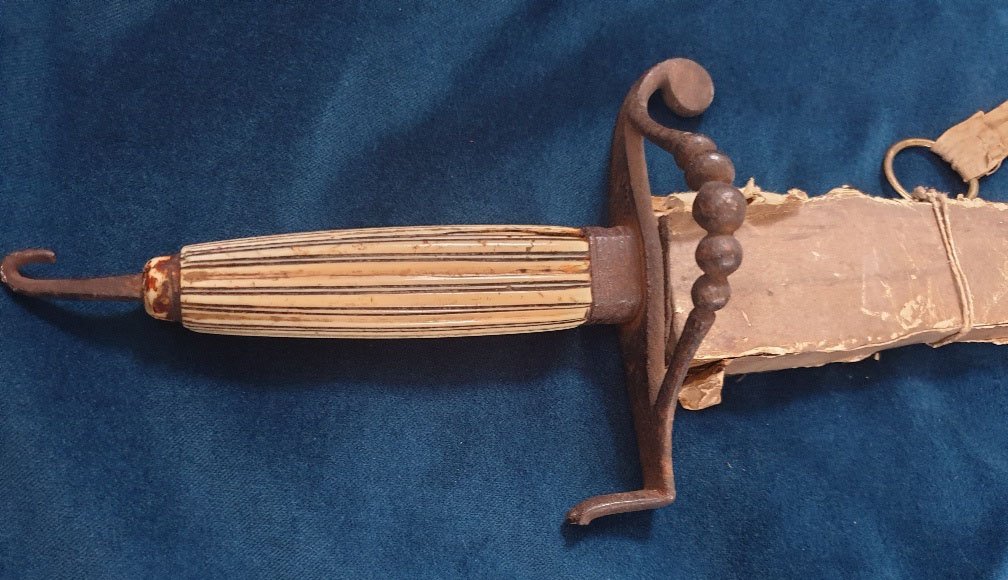
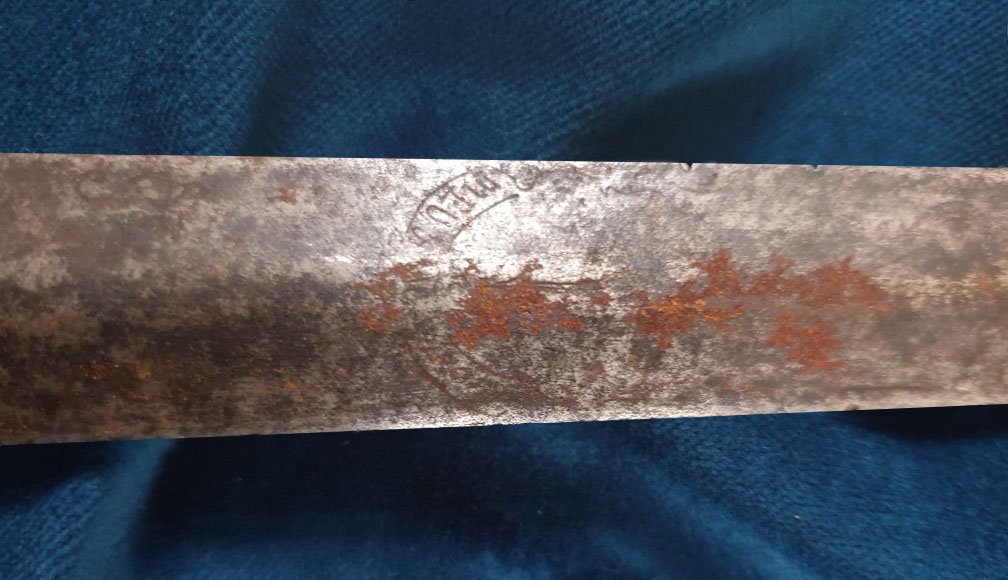
HOW WE’LL USE IT
This sword will be used in the procession and ceremony at the inauguration. It will be carried by a sword bearer. It is important as it reflects some of the many military service roles that different members of our Buchanan family have played since ancient times to help keep our clan and country safe.
This artifact is of significance to the future generations as it represents the sacrifices made by many Buchanan family members in protecting their family and clanfolk.
The Silver Jacobite rose
HISTORY
This is a silver Jacobite rose, which was created in the 19th Century to celebrate the martyr's and other key people involved in the 1745 uprising. Francis Buchanan of Arnprior was deemed one of the 5 martyrs of this uprising. As such his name was engraved in one of five inner petals, depicting the main 5 Jacobite martyr's. The recreation of this silver rose and several other items will help inform the clan that our Buchanan ancestors were key players in the Jacobite uprising.
MANUFACTURED BY
Roddy Young, Inverness based silversmith
MANAFACTURE
Made from a mould taken of the original Jacobite Rose, in possession of Frank Clark
6.5 cm diameter / 2.5 inches
HOW WE’LL USE IT
This replica silver Jacobite rose broach symbolises our relationship, contribution and losses from the Jacobite fall out. As well as being a recognised connection for the Buchanans to the Jacobite cause.
The chief will be wearing this to pin his plaid on to his jacket at the Inauguration. He could also wear it at other important events in Scotland.
A letter from Mr Davis H Caldwell of National Museum of Scotland to Frank Clark (Frank is the owner of the original Silver rose and a replica of the wee sword of Leny) detailing the likely origins of the Jacobite silver rose.
Frank's mother Cilla Hay Young inherited these artifacts along with many others from Leny house, which she sold in the 1960's. She was related to the Leny family but not by Buchanan blood. When the last Buchanan at Leny died, the house went to the Murray family, his maternal cousins who had no Buchanan blood. Frank has really helpfully previously given us many of the books with copies of the Buchanan of Leny Charters, which helped us with the chiefship claim.
The Bear Cromach
HISTORY
The Cromach (shepherds stick) has been increasingly used as a symbol of clan chiefship. Whilst anyone can have one, more and more chiefs are seen at events with specially created Cromachs. These are thought to represent chiefs as family leaders guiding their family.
RESEARCH
The bear was used as a symbol as it represents the very early and historic Leny of that Ilk origins of our family and also since bears were also a key symbol in early Buchanan Clan heraldic arms.
DESCRIPTION
A 6 foot tall stick.. he he he
MANUFACTURE
The process of making the Cromach was one that involved Roddy Young and Ron Spiers of Scottish Stickmakers of Dunkeld, who met up in person to discuss the various options.
From the information provided by Paula, they came up with designs for the bear’s head emerging naturally out of the antler. Roddy’s design was chosen by Paula and he first carved the jagged recesses that the silver would sit into, then sculpted the joining collar that would attach to the bear's head model, which had been sculpted using a 3D modelling tool on the computer. The head model was cast in silver then soldered to the cast collar, polished, antiqued then hallmarked. This was then attached by both glue, and a heavy pin, to the antler. The tip, collar and base were modelled using a combination of hand sculpting and computer sculpting. They were then moulded, cast, then finished as above. The silver parts were then all fitted to the antler and stick by Ron Spiers.
The timber is Hazelwood; 6 foot (182 cm) long
HOW WE’LL USE IT
This reflects the relatively recent role that cromachs appear to be playing with clan chiefs. The cromach appears to represent the leadership role that the chief has, other have suggested it is similar to a shepherd and a flock. This represents the Buchanan chiefship and will be used at future inaugurations and other important ceremonial events in Scotland.
The Antlers used in the Cromach
Mold for the collar
The Buchanan Seal
HISTORY
Seals are typically used as a stamp in wax as a sealing device and authentication. It will be used to make wax seals for different clan documents regarding the Chiefs Court's appointments. It provides the traditional form of a signature. As such it is an important insignia as it represents that what ever the document it is on has the Chief's approval.
RESEARCH
This is the ‘family seal’. It has Mikes full achievement on it and it is an essential part of the ceremony. It represents Mike’s signature.
We went through different options for the handle of the seal – from looking at historic seals and our family seals in the Lyon office. We settled on having a handle in silver as this could be also used to show some Buchanan symbols more readily. For such a small object, it required a lot of thought and effort.
Since the account of the Chief's inauguration in Frank Adams amended book The Clans, septs and had a description of the Chief's seal being in a bag embroidered with the Chiefs full achievement coat of arms, we realised we also needed to make an embroidered bag to revive that tradition. The embroidered bag, which Sir Thomas Innes of Learny mentioned in his account of the Inauguration ceremony has been embroidered with Mike’s full heraldic achievement.
DESCRIPTION
8 cm tall / 3.2 inches
MANAFACTURER
Roddy Young
MANAFACTURE PROCESS
Roddy needed to make it in two stages. He had to create the handle then create the seal at the bottom itself as the seal needed to be functional as well as to look good. We supplied Roddy with the artwork of the seal, which was drawn up by the wonderful heraldic artist Thomas Freeman. Once Roddy received the art work, he had to investigate different ways in which it could be created. He settled on 3D printing the letters and design of the seal so on the wax the design would be raised.
HOW WE’LL USE IT
This represents the authority to make decisions, and place the chiefs ‘stamp’ on clan issues.
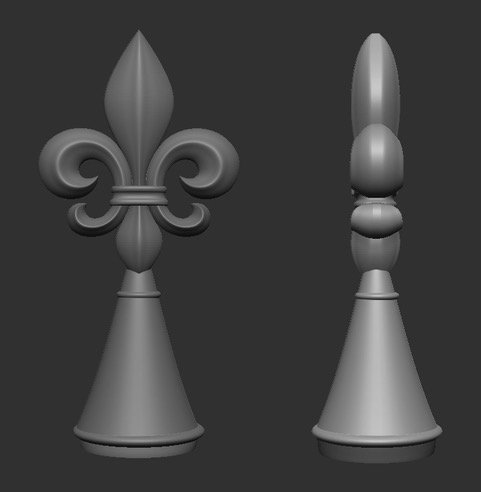
Seal purse
The seal purse is almost as significant as the seal itself, certainly as beautiful and ceremonial.
Made by Katy Eccles and Judy R Clark (who made the Buchanan Seat cushions and many of our ceremonial robes) to incorporate the Full achievement of the Buchanan on an embroidered purse. Katy made the embroidery and Judy creating the purse itself.
The Buchanan Seal Ring
HISTORY
This red ring reflects several things. It symbolises a commitment to the clan and the authority to lead it. It is made from a red agate stone. This colour stone also reflects the ruby ring given by Bonnie Prince Charlie to Buchanan of Arnprior in recognition of his work in supporting the Jacobite cause.
A ruby ring was given by Bonnie Prince to Francis Buchanan of Arnprior (circa 1945) was reportedly given by Arnprior’s sister Jean McNabb to the Museums of Scotland.
RESEARCH
When working out what was needed for a ring, we looked at armorial rings. It seems that there are only a few craftpeople left in the UK who could have the stone engraving skills neccessary to engrave stones on rings. To find someones who could actually carve a chief's full achievement arms on to a tiny stone, is even harder. Unfortunately since the one person was too busy, we found a company called Dexter rings in Kent.
William Wright, who appeared to help found the company as it is today, has been there for many years and has this amazing skill set. He still makes hand engraved rings using the time old teqniques which have been used for centuries. He was the one who made our Buchanan ring. So now we had the person who could make it, we then had to work out the design of any ring.
DESCRIPTION
Engraving: Traditionally seal engraved with full heraldic achievement and motto
Ring table engraving: A laurel branch border design surrounding the stone mount
Shoulder engraving: A fluer de lis on both shoulders with a background/floral pattern
Inscription: Buchanan Inauguration 8th Oct 2022 engraved inside the shank of the ring in Script font
MANAFACTURER
It seems that there are only a few craftpeople left in the UK who could have the stone engraving skills neccessary to engrave stones on rings. And to find someones who could actually carve a chief's full achievement arms on to a tiny stone, is even harder. Unfortunately since the one person in Scotland was too busy, we found a company called Dexter Rings in Kent.
William Wright has been with Dexter Rings for many years and has this amazing skill set. He still makes hand engraved rings using the time old teqniques which have been used for centuries. Williams’ son Simon is head engraver and managing director, has been an heraldic hand engraver for 30 years and mainly concentrates on precious metal engraving. The recent addition of grandson Joe, as apprentice currently specialising in gemstone rings, means Dexter Rings has now three generations of Wright family engravers! Gemstone engraving is an ancient, extremely rare, and somewhat time-consuming craft,
Ring 3 cm deep / 1.2 inch, and the face is is 2 x 1.8 cm oval shaped / .78 x .7 inches
HOW WE’LL USE IT
This red ring reflects several things. It symbolises the taking on of a commitment to the clan. As it also has the chiefs full achievement coat of arms engraved on it, it shows that its owner has the authority to be the chief.
The person who has this ring is the one who is identified to be the Buchanan chief and support the Buchanan clan. The circle reflects the fact that the chief is now there to make the clan whole and a legally recognised one, as it was formally. Since at many Clan events abroad, a clan which has a chief is treated differently to one which does not and is a chiefless armigerous clan, having a chief is important. The Buchanan seal inauguration ring will be mainly used for inaugurations but could be worn by the Buchanan at special events.




The finished product showing an image with the imprint it made on wax.
The Inaugural Lion Sword
HISTORY
Bonnie Prince Charles also bestowed an (unrelated) sword to Francis Buchanan of Arnprior (circa 1945). This came to Francis’s sister: Jean, when Francis was executed. Jean kept the sword, then married the chief of McNabb Clan; it is now in possession of the current McNabb chief.
RESEARCH
We have envibed many significant elements onto this jewel:
the bottom of the scabbard has a depiction of the Buchanan clan island Clair Innes
The blade has the words Clair Innes on one side
The blade also has the the Buchanan of Leny Motto, “Noblis Est Ira Leonis” on the front of the blade
DESCRIPTION
It also at the bottom of the scabbard has a depiction of the Buchanan clan island Clair Innes. The blade also has the words Clair Innes on the back and the Buchanan of Leny Motto, Noblis Est Ira Leonis on the front of the blade. It has two red agate stones as eyes, which were sourced from Cambusmore Estate.
87 cm long / 34 inches
MANUFACTURE
All the silverware components were designed by Roddy Young according to a list of emblems that Paula had supplied.
At Glittering Edge (with Greg Marr, the sword maker), Roddy showed Paula and Mike the ideas he had – they were unconventional, but they chose them in order to make an impression and for them to stand out.
The handle was sculpted using both traditional sculpting methods and 3D computer sculpting tools. These were then sent to a specialist caster who moulded and cast the parts front and back. They were then soldered together to form the handle.
Laser engraving by Cammy Rae of CJR Laser.
Stones were cut by Nat Forno of Scottish Gemstones which were then set in to the eyes of the lion, bear and falcon. The sheath components were constructed from silver sheet to fit, then all the motifs were sculpted, moulded, cast in silver and soldered onto the metal back plates.
HOW WE’LL USE IT
This sword will play a key role in the ceremony. It represents clan justice. It has the lion as a handle as this reflects the historic presence of a lion rampant on the Buchanan Chief’s Coat of arms.
The Inaugural Bear Dirk
HISTORY
This dirk respects the Clan’s history with Scottish small swords as well as the bear from the Leny branch of the family, as well as reflecting early Buchanan Chiefship heraldry.
This dirk also symbolises the early origins and heraldry of the clan and also the fact that for many years our family have been the guardians of the small silver sword of Scotland. As such we were keen to feature the different very Scottish forms of small swords which are now more commonly recognised.
DESCRIPTION
Virtute Gladii Pari “by virtue of a short sword”, is engraved on the front of the blade.
The words “Clar Innes” are engraved on the back.
It also has a small red agate recreating the bear’s eye. This stone was obtained from Cambusmore.
48 cm long / 13 inches
MANUFACTURE
All the silverware components were designed by Roddy Young according to a list of emblems that Paula had supplied. The blade itself was crafted by Greg Marr of Glittering Edge. Laser engraving by Cammy Rae of CJR Laser.
The handle was sculpted using both traditional sculpting methods and 3D computer sculpting tools. These were then sent to a specialist caster who moulded and cast the parts front and back. They were then soldered together to form the handle.
Stones were cut by Nat Forno of Scottish Gemstones which were then set in to the eyes of the lion, bear and falcon. The sheath components were constructed from silver sheet to fit, then all the motifs were sculpted, moulded, cast in silver and soldered onto the metal back plates.
The Inaugural Sguian Dubh
HISTORY
This small sword is well known by Scots as the Sguian dubh. It is now commonly worn in the sock as part as contemporary Highland Dress wear.
RESEARCH
We used a falcon, as falcons are found in the Buchanan arms as supporters.
The Motto “The Power of Short swords” is engraved on the front of the blade. This more contemporary wording in English.
This English translation, which is now found on the Auchleshie arms reflects again the important family link with short swords.
DESCRIPTION
Again, it has two red eyes from the red agate stone sourced at Cambusmore.
23 cm long / 9 inches
MANUFACTURE
Initial falcon sketches
All the silverware components were designed by Roddy Young according to a list of emblems that Paula had supplied.
The blade was made by Greg Marr of Glittering Edge. The handle was sculpted purely by hand. They were then soldered together to form the handle.
Stones were cut by Nat Forno of Scottish Gemstones which were then set in to the eyes of the lion, bear and falcon. The sheath components were constructed from silver sheet to fit, then all the motifs were sculpted, moulded, cast in silver and soldered onto the metal back plates.
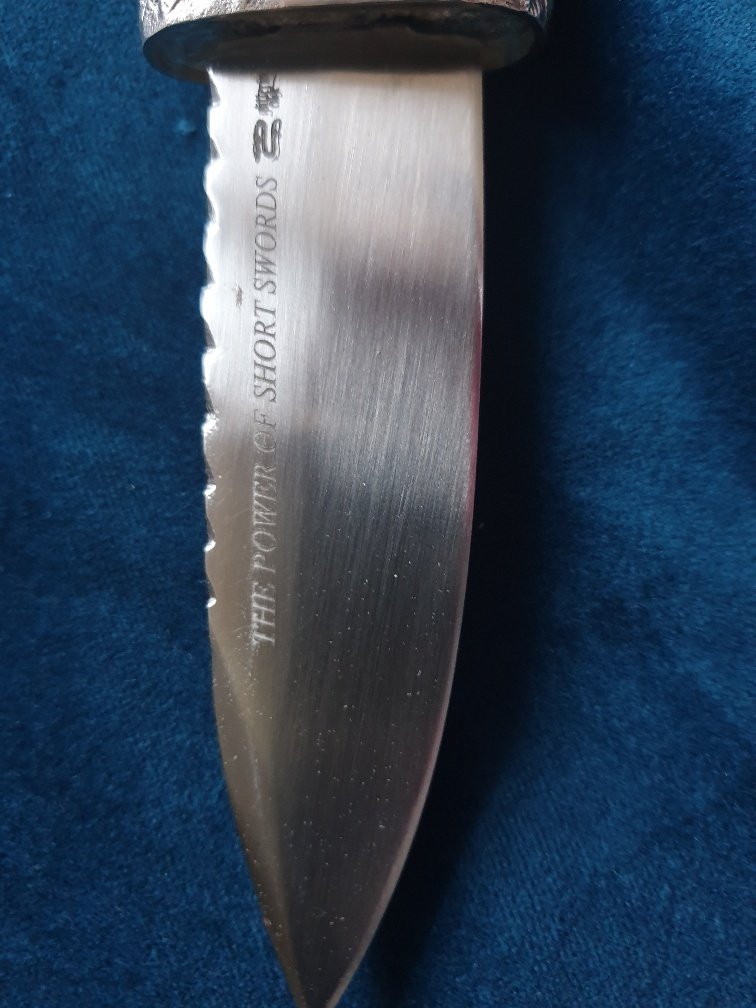
The Inaugural White Rod
HISTORY
A white rod or wand has long been used at ancient Clan chief inaugurations. It is mentioned in very early descriptions and appears to play a key role in this ancient ceremony according to Sir Thomas Innes of Learny, a former Lord Lyon (from the book Clans Septs and Regiments of the Scottish Highlands by Frank Adams and edited by Sir Thomas Innes of Learny).
It was used to symbolise the role of the chief in guiding the clan and for their role in providing fair rulings and decisions.
RESEARCH
Despite its very early use, there have never been any images of its useage. With the decline of all ceremonial aspects of the clan court after the Jacobite uprising, if there are any residual historic white rods/wands still in existance, they may be just “unidentified” and unrecognised as such. So we found the only remaining historic white rod/wand in existance and based our design around that.
The rod to furthest to the right on the initial sketch drawing is an early design at creating a white rod. It is based on the only white rod/wand in existence from the collection of Scottish Crown Jewels known as the Honours of Scotland.
DESCRIPTION
It features the Buchanan Falcon on top of a white quartz stone from historic Buchanan lands in the Killin area.
MANUFACTURE
Created by Roddy Young and was formed using a solid silver tube with the various elements added to it.
As there were many parts that included lettering, he chose to sculpt using a 3D sculpting program, and then cast them. The bottom section of the stick was made using a combination of hand and computer sculpting. The Falcon was also sculpted using 3D sculpting, then cast. The parts were then soldered, finished and hallmarked.
The stone was carved by Nat Forno of Scottish Gemstones from a rough stone found on Buchanan lands. It was pinned and screwed to the tube and the Falcon was then attached by pin and glue to the stone.
The timber stand was produced by Evergreen of Abriachan who does laser engraving on wood.
HOW WE’LL USE IT
The White rod or wand is thought to be a symbol of justice and leadership. It will be used as part of the inauguration ceremony itself and also the clan parliament. It will be used in all major events when the chief would be needed to be involved in making any decisions. It will also be present at important clan functions in Scotland to represent the chief.
Initial sketch
Final design
The Buchanan Sept Coronet
HISTORY
This crest coronet has been long assigned to Scottish Clan Chiefs. This is shown by the former Lord Lyon, Sir Thomas Innes of Learny’s book called Scots Heraldry. In this book, Sir Thomas states “Of this coronet, Nisbet states that it pertains to “Gentlemen of Name and Arms”, i.e. “of that ilk”. Sir Thomas also continued to say that “It has now been adjudged that the gold crest-coronet indicates a Chef du Nom et d’Armes (“of that ilk).
This crest coronet may have its origins in the earlier crowns worn by early tribal and clan chiefs, in the days they were regional kings.
RESEARCH
The insignia on our coronet has four strawberry leaves.
For us, its circular shape represents the global aspect of the modern Buchanan Clan. It is based on the crest coronet historically assigned to Clan Chiefs which has 4 strawberry leaves.
It features four stones:
an opal (from Australia) to represent Oceanian Buchanans
a red Tourmaline stone (from North America) to represent American Buchanans
a blue Labradite stone (from Finland) to represent European Buchanans
and a green Jadite stone to represent Global Buchanans — this global network is important and needs to be acknowledged and celebrated
MANUFACTURE
Rough design stage
Created totally by Roddy Young, Silversmith, Inverness
The Coronet was produced using measurements Roddy had taken earlier of Mike's head. He wanted there to be no join marks visible on the inside, so a squat aluminium vase-shape was spun on the lathe. The base was then removed and formed into an oval coronet shape. All the components on the surface of the coronet were hand and computer sculpted. The plaques were all laser engraved based on names collated by Paula. The areas that had the four stone settings had to be made separately for each stone, then soldered onto the coronet. All the components were then moulded, and the wax copies bent around the curves they were going to be soldered onto. They were then cast and soldered onto an identical silver version of the original mock-up. This was then hallmarked and sent for polishing and gold-plating. Finally, the stones supplied by Paula were set.
HOW WE’LL USE IT
It is not intended to be used for any ‘crowning’ in the ceremony as Mike will be wearing his hat with eagle feathers throughout. I imagine it will be just placed alongside the other insignia. However, we feel it is an important symbol as it represents and celebrates the historic past for our clan as the earliest known inhabitants and tribal chiefs/regional rulers of lands in some areas of Scotland.
It also combines it with the new situation in the clan in that we are now completely global and use many names in addition to that of Buchanan. As such, it also will have over 100 of the sept/family names engraved on four plaques on the side. This will hopefully increase awareness that there are many names associated with the Buchanan Clan which should support the hard work CBSI are doing to encourage new memberships.
Actually, we are also working out ways in which in can be used by clan members themselves, perhaps for photo opportunities together with sitting in the Seat of the Buchanan in a session after the event itself. Ideas are welcome. One person suggested that clan members could be filmed with the Sept Coronet talking about what it means to them for their name to be formally recognised or to be there at the event. For us much of the clan jewels are the people of the clan itself; so, the creation of the Buchanan Sept Coronet is our way of representing and celebrating all the Buchanans in the clan, wherever they live and whatever their surname may be.
Coronet working sketches:
Targe
RESEARCH
Targe (or “small shield”) is a shield strapped to the forearm by Highlanders when going into battle.
Historically made by fastening together thin sheets of wood with the grain going in different directions - making them stronger and less easy to splinter or penetrate.
DESCRIPTION
The core is wrapped with leather which is tacked in place with brass tacks. The brass center-piece was hand forged by fellow Clansman Peter Buchanan in Virginia. The brass tacks and centerpiece are designed to deflect arrows during battle. Finally, Rabbit hide is attached to the back to cushion the arm.
The diamater of the Targe is 51 cm (20”) and is 2.5 cm at the edge (1”) and the brass dome is 5 cm (2”).
Andrea Nissley Hertzler.
MANUFACTURER
It was created by Andrea Nissley Hertzler; fiancé to Trevor Paradis (CBSI Regent for Columbia, Virginia, West Virginia and Maryland) and and given to the Chief on his birthday in 2022.
The full story available in April 2022 Buchanan Banner
HOW WE’LL USE IT
The Buchanans have placed the Targe next to the library fireplace, in the hearth of Cambusmore. They placed it there as it represents the clan and the issue of protection.
Its creation and our acceptance symbolise the clans support and protection of the Chief, and equally reflects the aim of the Buchanan Chief to support and protect the clan.
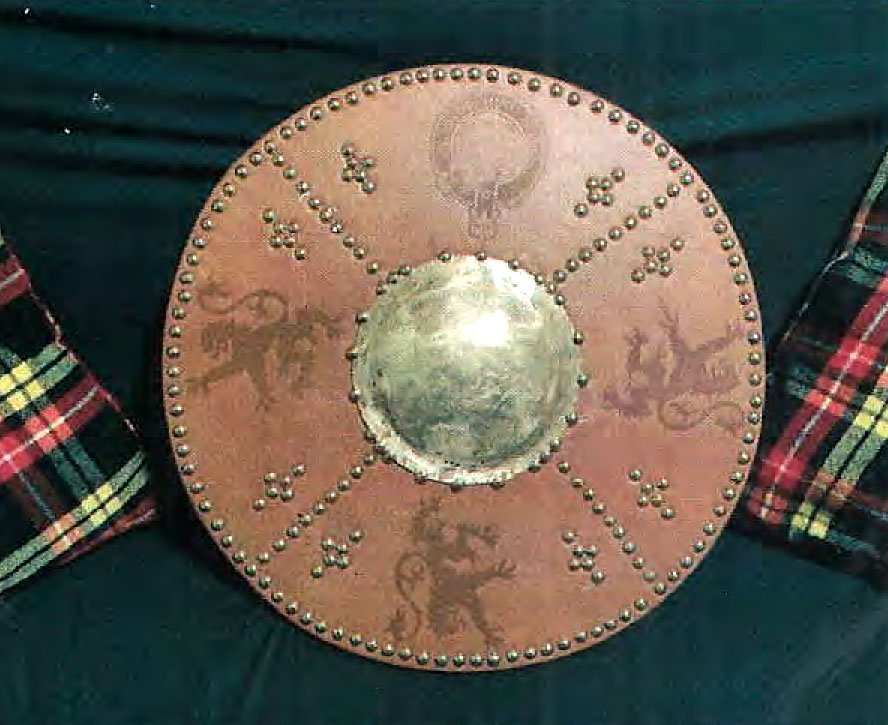

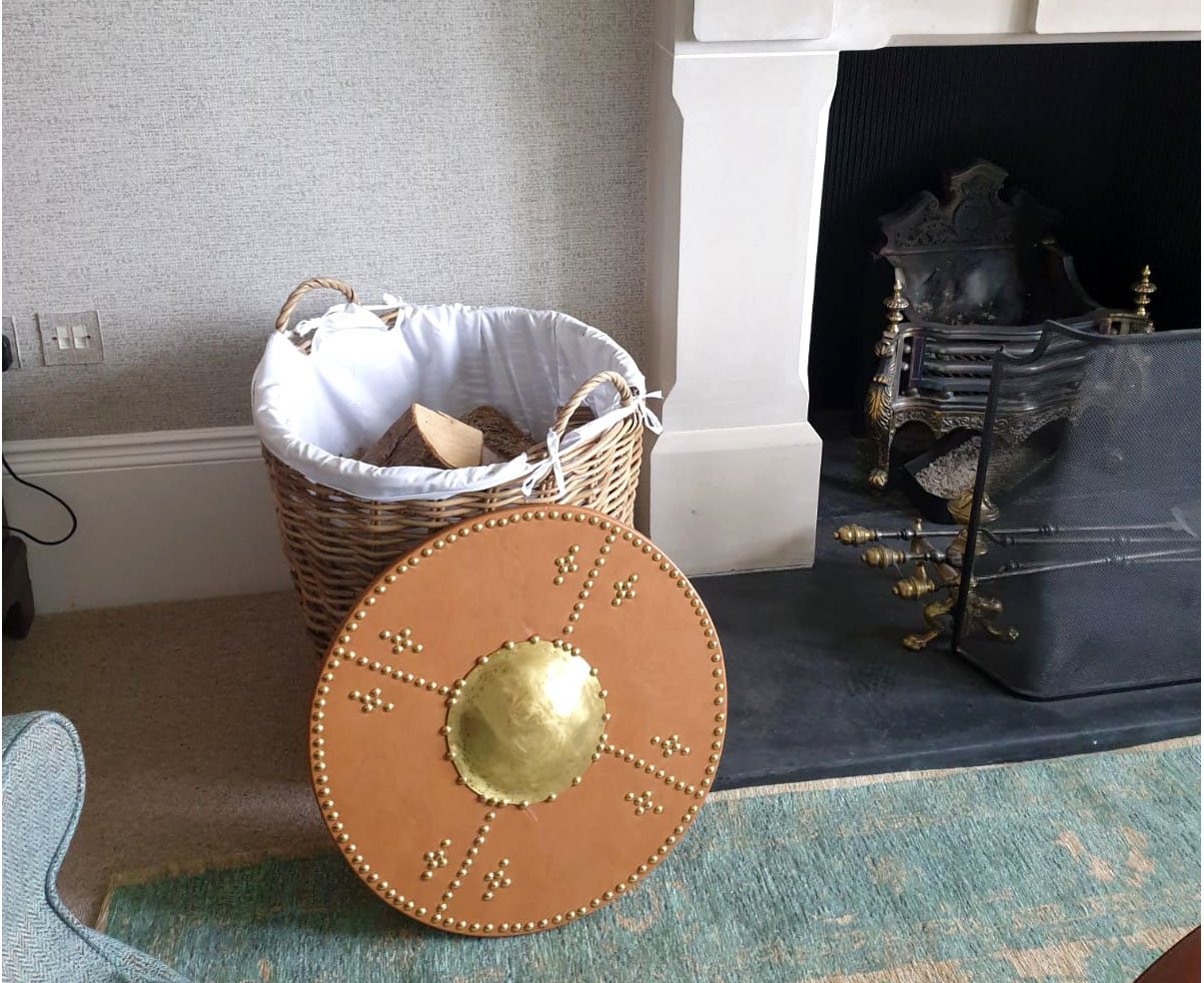
Roles of those in the Inauguration ceremony and Clan Parliament
Other titles and terminology that might be used in traditional ceremonies
… like a chiefs inauguration
Seanchaidh
(pron. “shen-e-kee”)
Scots Gaelic for the Clan’s historian and Keeper of the Traditions (Anglicised: Seannachie).
The clan Seanchaidh is essentially the genealogist, historian, storyteller and keeper of the memories, traditions and ceremonies.
It is an important position in the household of a king, noble, or clan chief, and a particularly significant one when it came to the choice, recognition and installation of a new chief - a process that was overseen by the Seanchaidh. His role was highlighted when he presented the new chief to his clan by reciting his pedigree - a ceremony also carried out at other important gatherings of the clan.
Seneschal
An Estate Manager or Chiefs Steward
A steward in charge of a lord's estate in feudal times.
A seneschal was an official in the houshold of a sovereign or nobleman, to whom the administration of justice and entire control of domestic arrangements were entrusted. The word "seneschal" has also been used to refer to the governor of a city or province, and of various administrative or judicial officers.
Neach-giùlain Àbhaisteach
Gaelic for Chief’s Standard Bearer
Fir brataich
(pron. “fid brar-tark”)
Gaelic for Flag men
Neach-giùlain Bratach
(pron. “nyuk-gyool-ine brar-tark”)
Gaelic for the Banner Bearer
A standard-bearer, also known as a flag-bearer is a person who bears an emblem known as a standard — a type of flag or sign, which is used (and often honoured) as a formal, visual symbol of a country, state, prince, military unit, etc.
This can either be an occasional duty, often seen as an honour, or a permanent position (also on the battlefield). If a perpetual position it might be reflected in official rank titles such as Ensign, Cornet and Fähnrich.
While at present a purely ceremonial function, at its origin in medieval warfare the standard-bearer had an important role on the battlefield: an indicator of where the position of a military unit was, with the bright, colorful standard or flag acting as a strong visual beacon to surrounding soldiers. It was an honorable position carrying a considerable risk, as a standard-bearer would be a major target for the opposing side's troops seeking to capture the standard or pull it down.
Neach-giùlain Chlaidheimh
(pron. )
Gaelic for the Chiefs Sword Bearers
An official who carries a sword before an officer on ceremonial occasions. Mostly a symbolic gesture that the dignitary is under physical guard at a time when the official might not be carrying their own arms. It is a token of authority to protect the ward and power to punish criminals.
Clairinch Pursuivant
(pron. “clare-inch per-su-vant”)
The title of the private Herald of Arms to the Chief of Clan Buchanan. Clairinch (Clairinsh) is the island in Loch Lomond granted to the Laird of Buchanan in 1225 and gives the clan its rallying cry or war cry “Clar Innis”
A pursuivant or, more correctly, pursuivant of arms, is a junior officer of arms attached to official heraldic authorities, such as the Court of the Lord Lyon in Edinburgh. In the mediaeval era, many great nobles employed their own officers of arms to ensure heraldic accuracy. Pursuivants of arms look after matters of heraldic and genealogical importance for clan members.
It is the Pursuivant's duty to assess and announce applicants for admission into the official clan functions by their names and titles; to take charge of the jewels and regalia of the clan; to attend all meetings of the clan, and to perform such other duties as may be required by the chief.
Pìobairean an Cannonaich
(pron. “Pib-rock piberairn clan Cannanack”)
Gaelic for the Clan Buchanan pipers. Cananaich translates to Buchanan
A ceremonial role of chief appointed pipers, to lead and play it official clan functions.
Magadh
(pron. “mag-ay”)
Gaelic for Mage
In Scottish history, the role of wizard, druid or sorcerer form more of a councillors or advisors role. Though some aspects like witches or seers were more cultural. Click here to read more of Scottish superstitions…
By some accounts, a chiefs wizard was a learned person — mathematician or scientist; a healer, translator or scholar — and through their intellect, able to perform “the miraculous” or predict the future. But, maybe, some were actual occultists.
Figures like Michael Scott (b.c. 1175) or Merlín (Myrddin c. 550 AD, Welsh born and Scotish raised ally to mythical King Arthur) have made the Magicians reputation more colourful, aligned to the culture of Scottish superstition and mythology.
Of course, The Scottish Witchcraft Act of 1563 saw many of those accused of sorcery to be convicted, strangled to death and then burnt at the stake. The 'Satanic panic' – was largely sparked by King James the VI of Scotland who not only considered himself an expert in witchcraft, but also believed he was the Devil's greatest enemy on earth.
Sir Walter Scott (close friend of Clan Buchanan) gained the nickname ‘The Wizard of the North’ because he first published his Waverley series anonymously, creating an aura of mystique as well as conjuring up magical images of Scotland
Other descriptions of Scottish Mages:
Faidh
(pron. “fiey”)
Gaelic for Seer
Draoidh
(pron. “druy”)
Gaelic for Druid
Buisneach
(pron. ‘bush-nyark”)
Gaelic for wizard


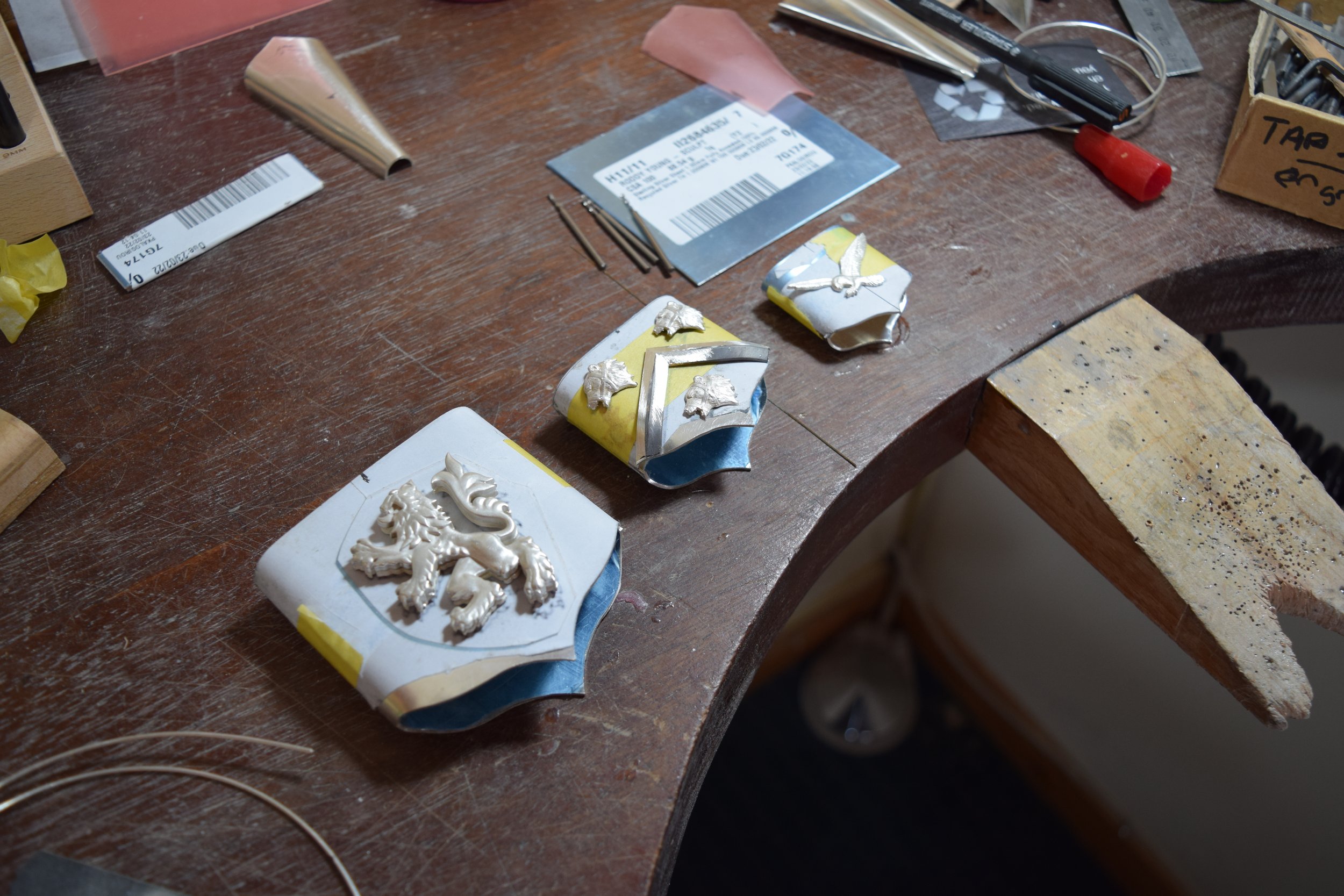
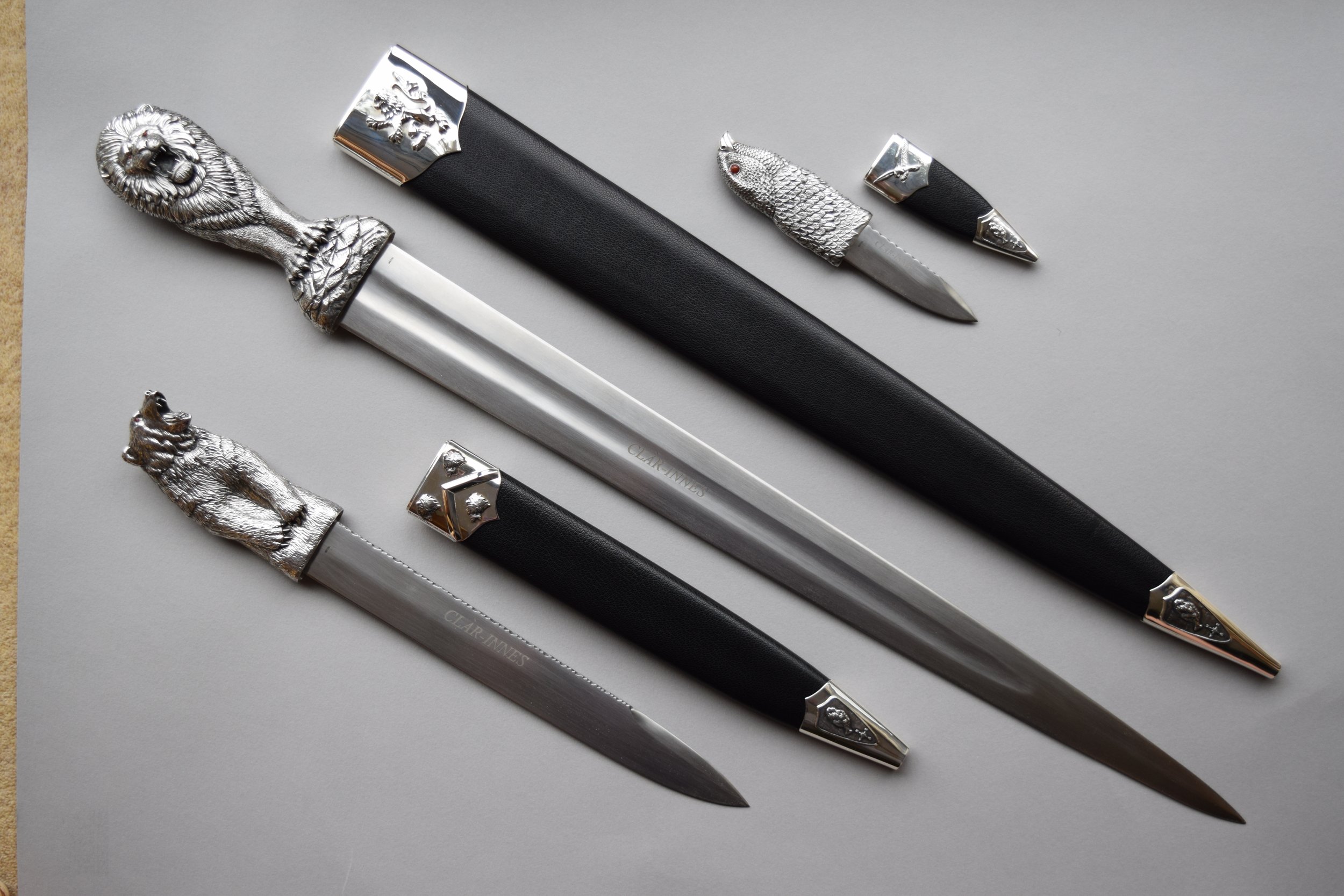
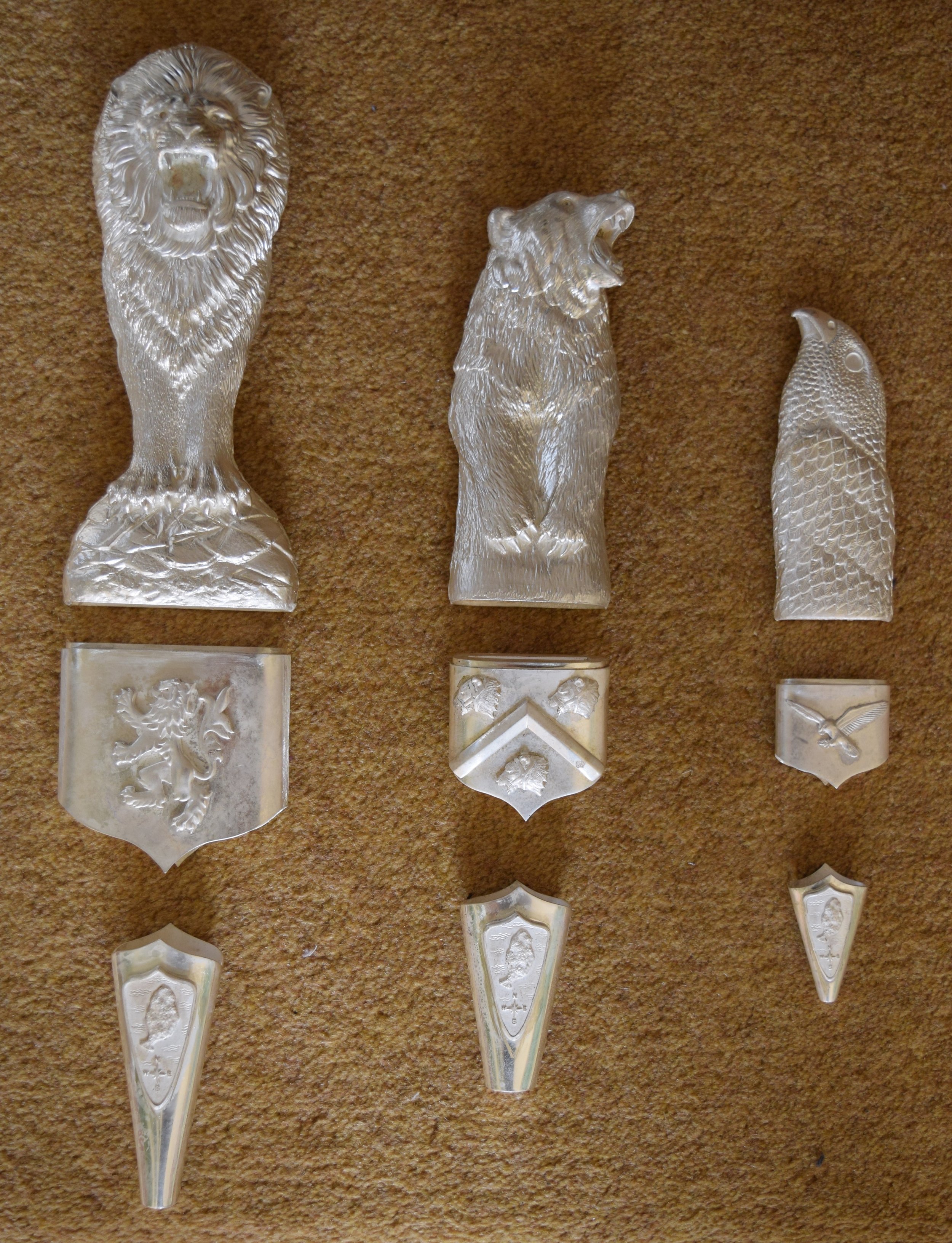
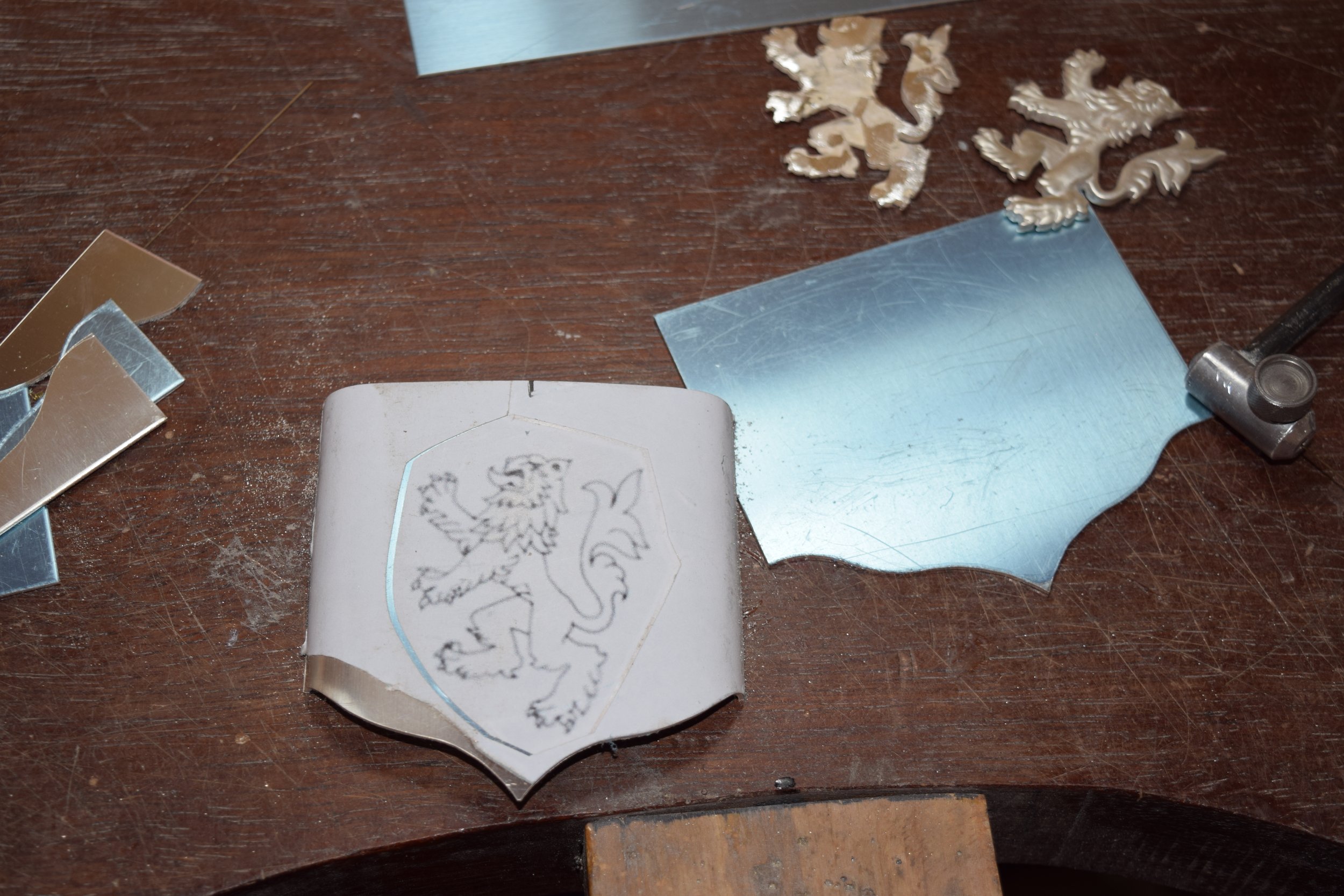

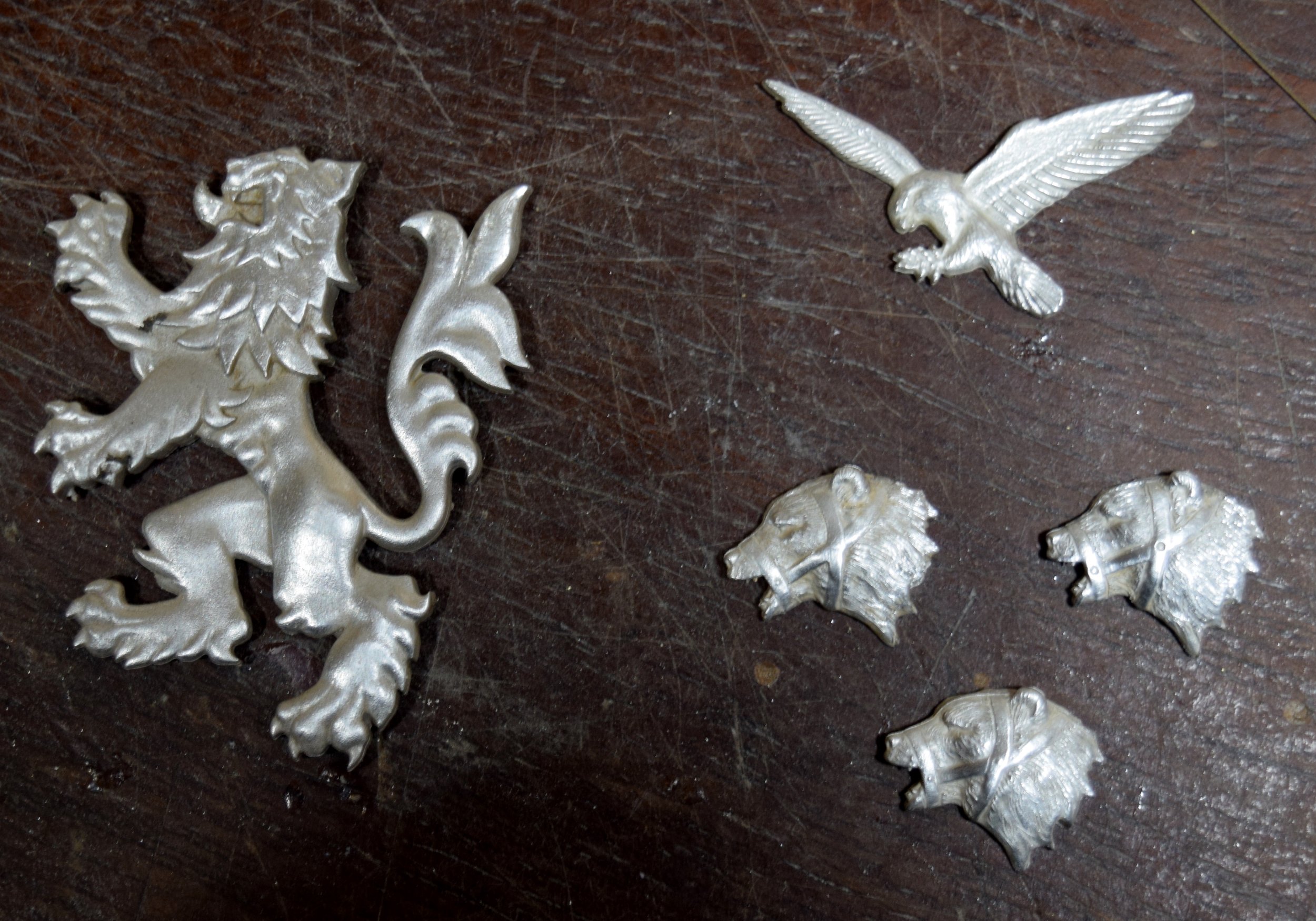
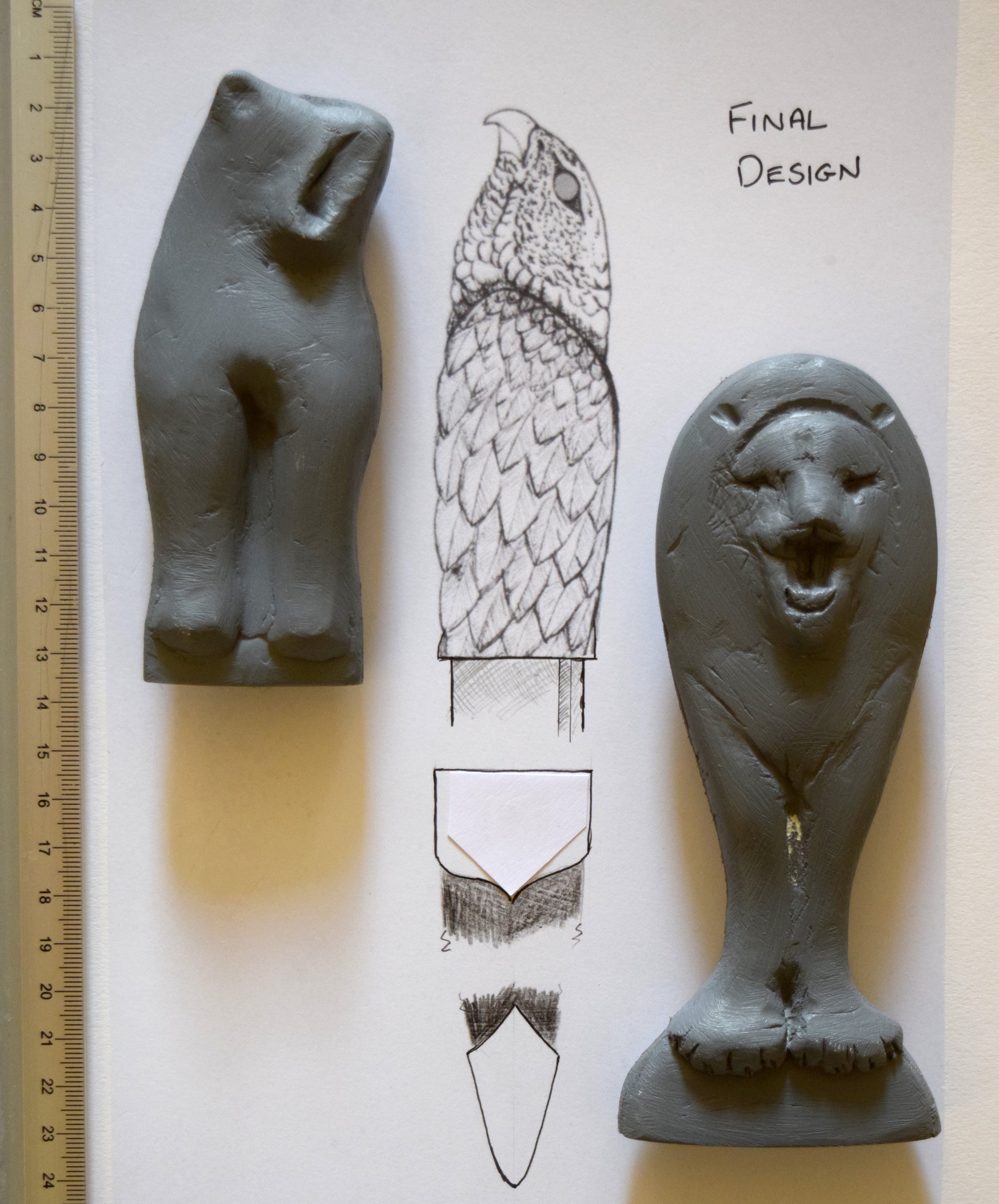




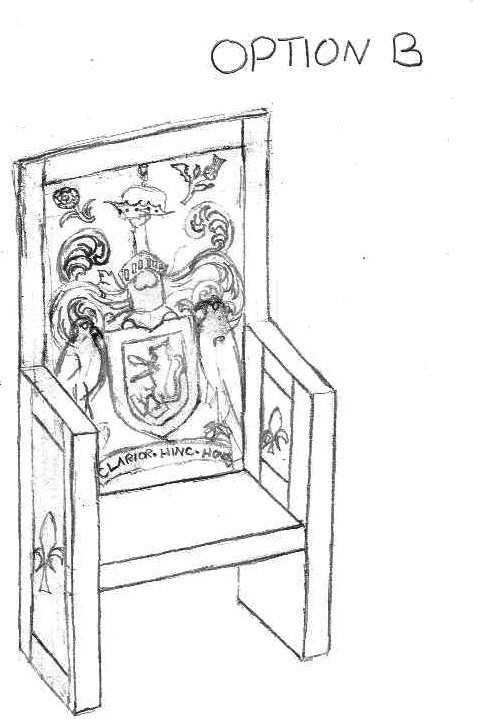

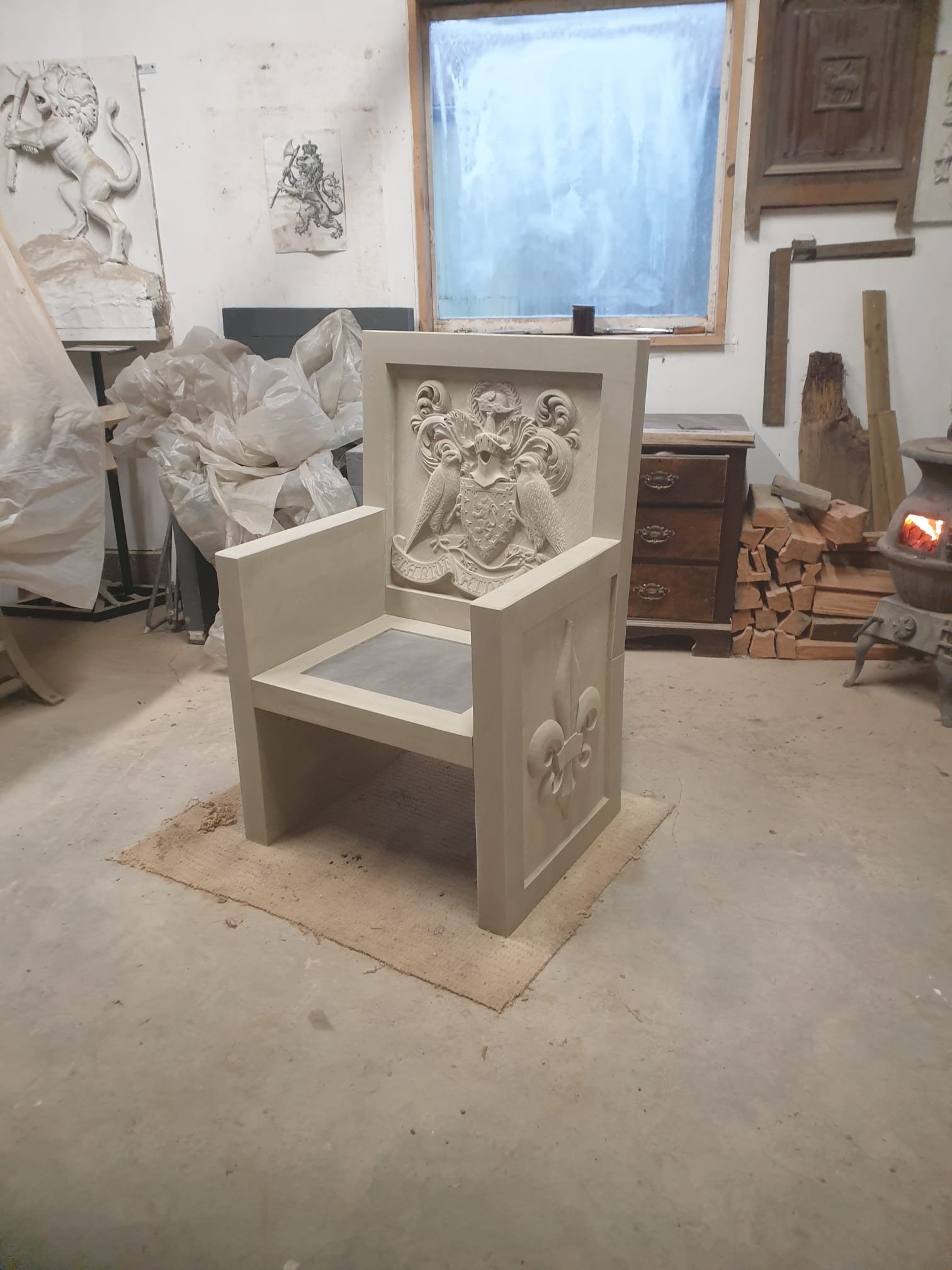
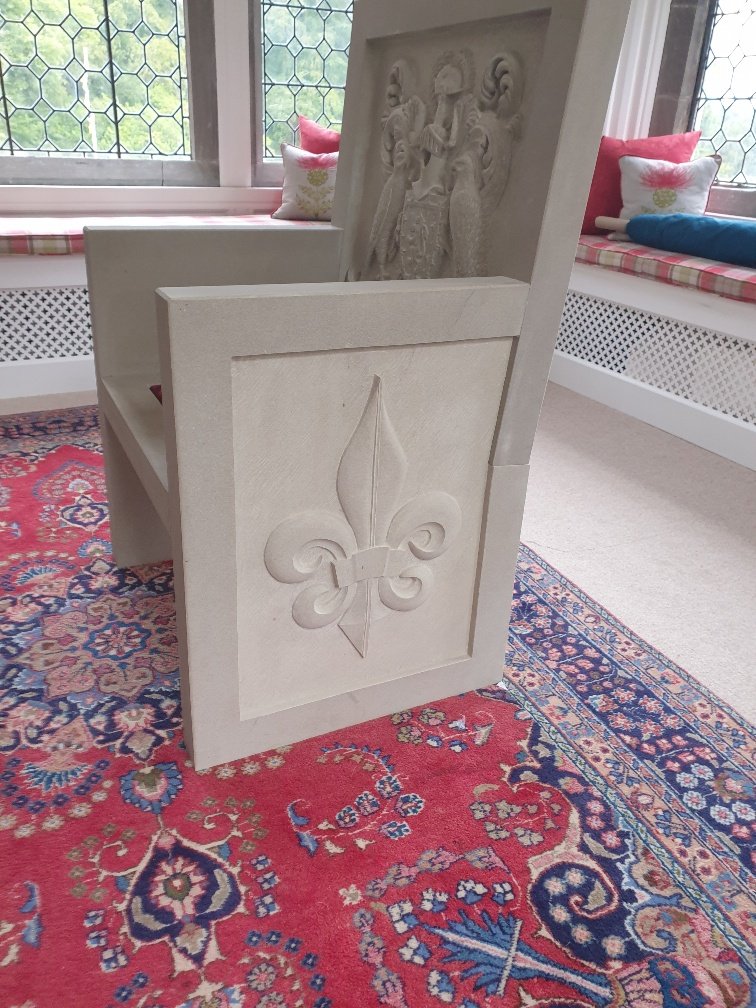
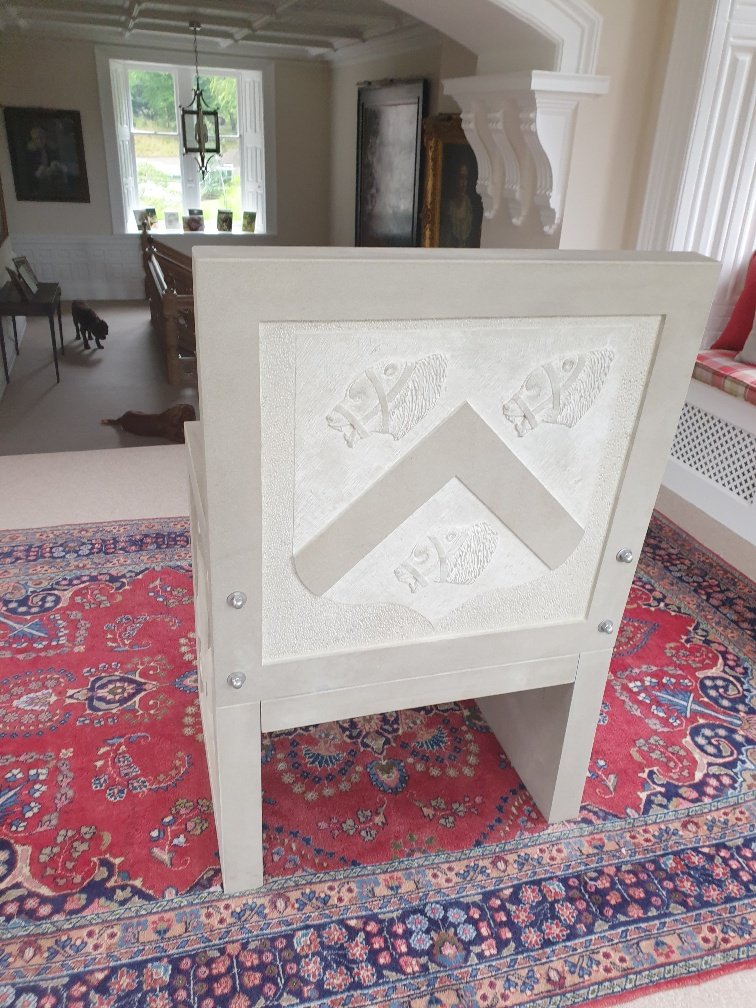




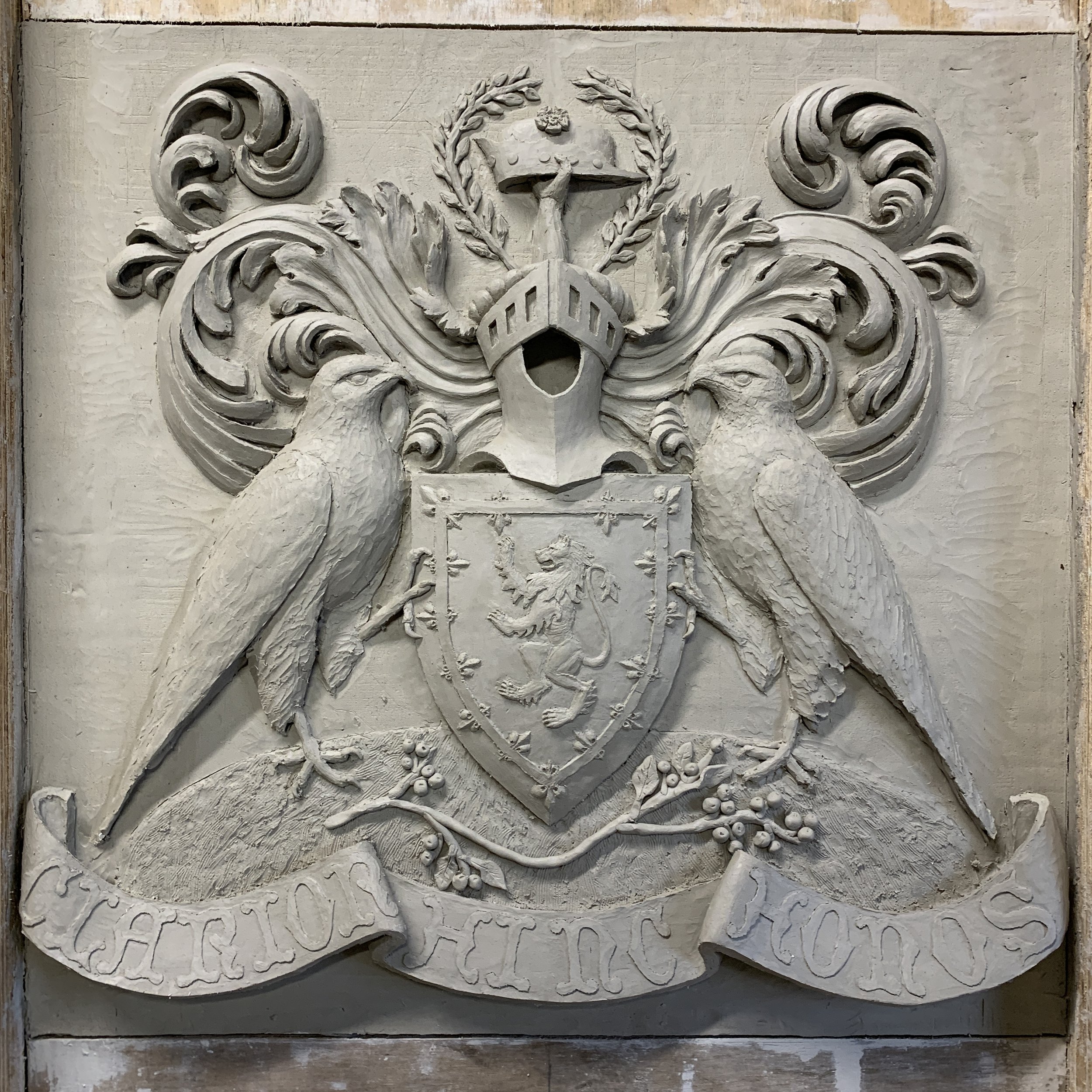





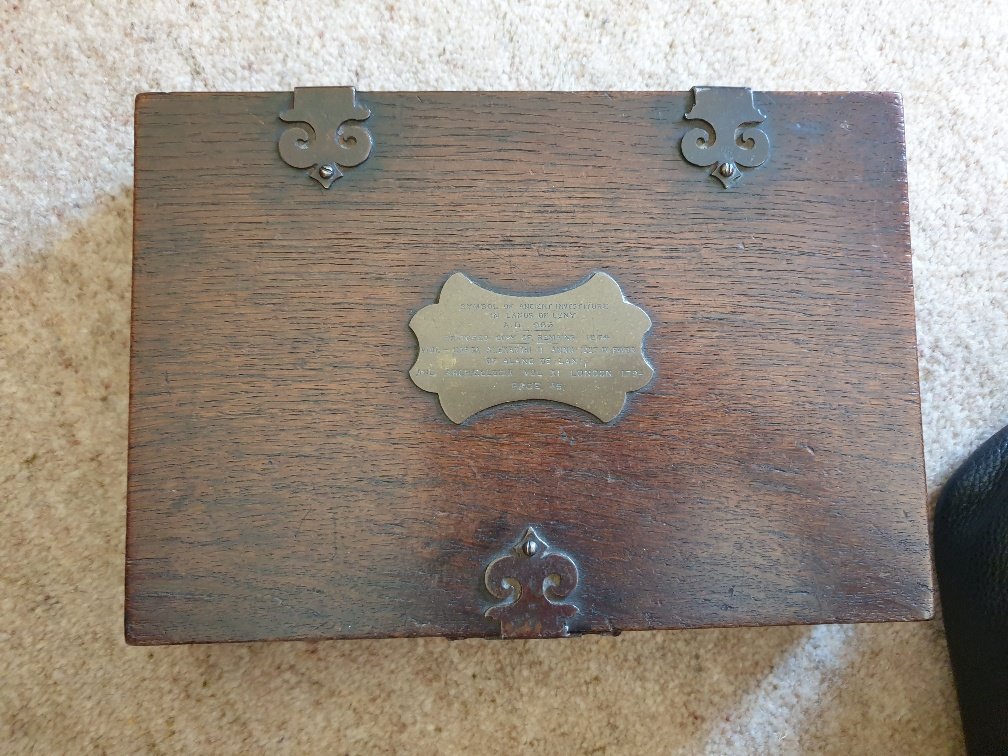
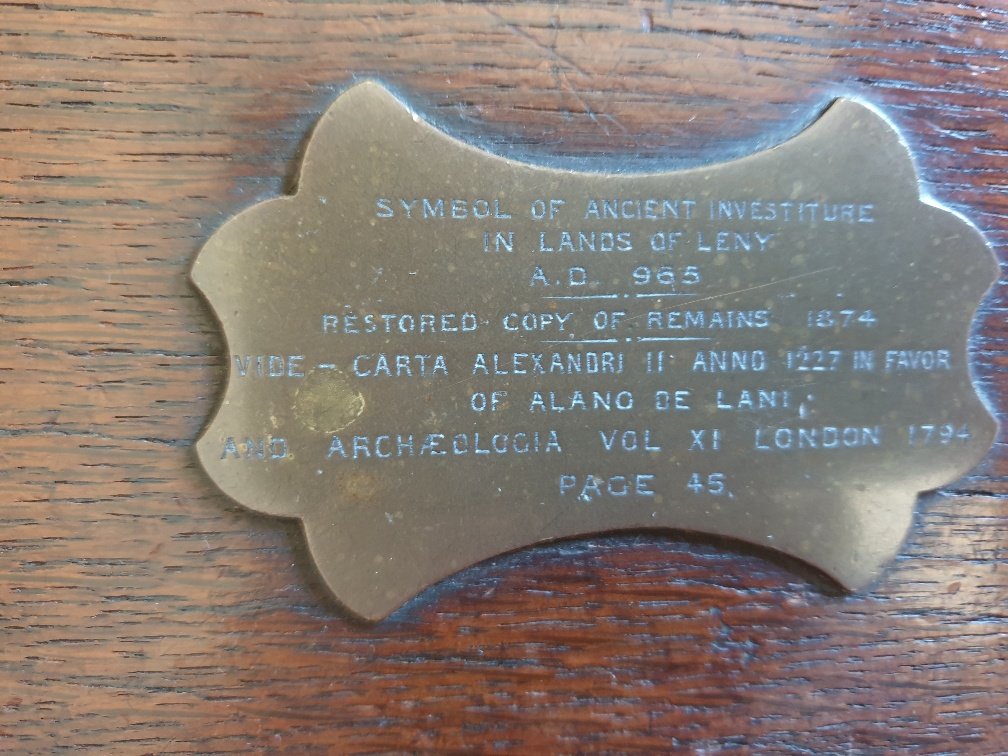
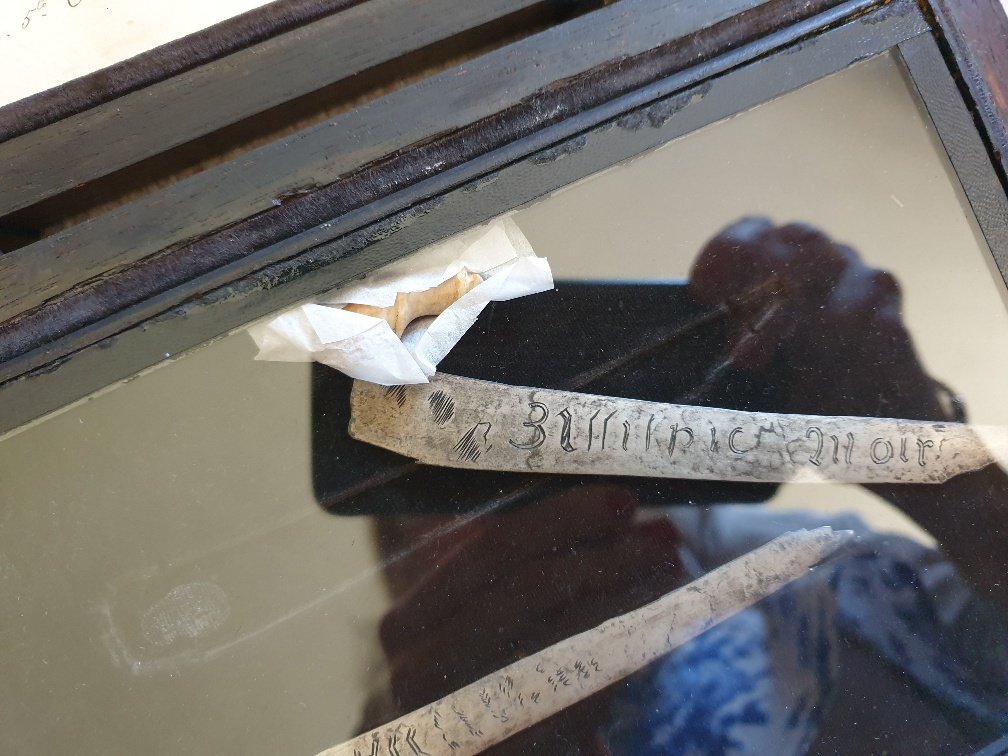
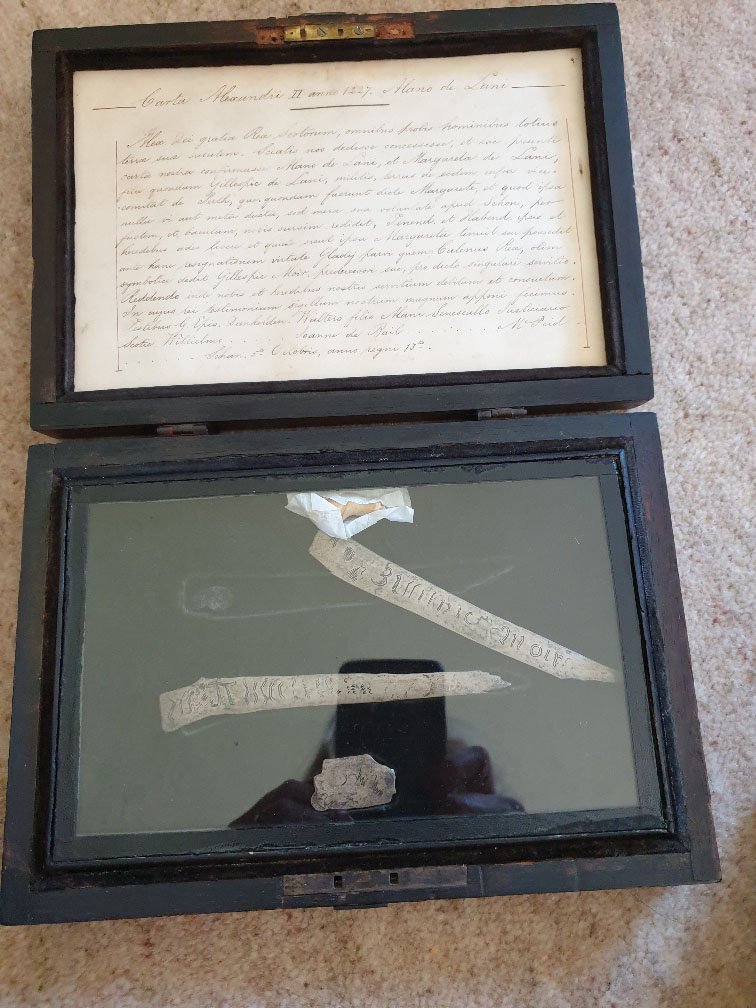

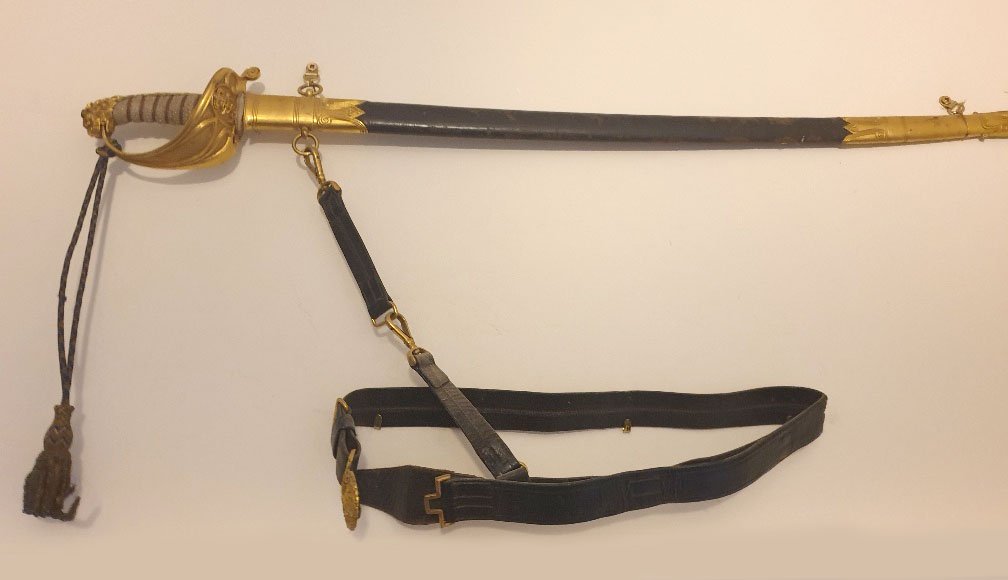
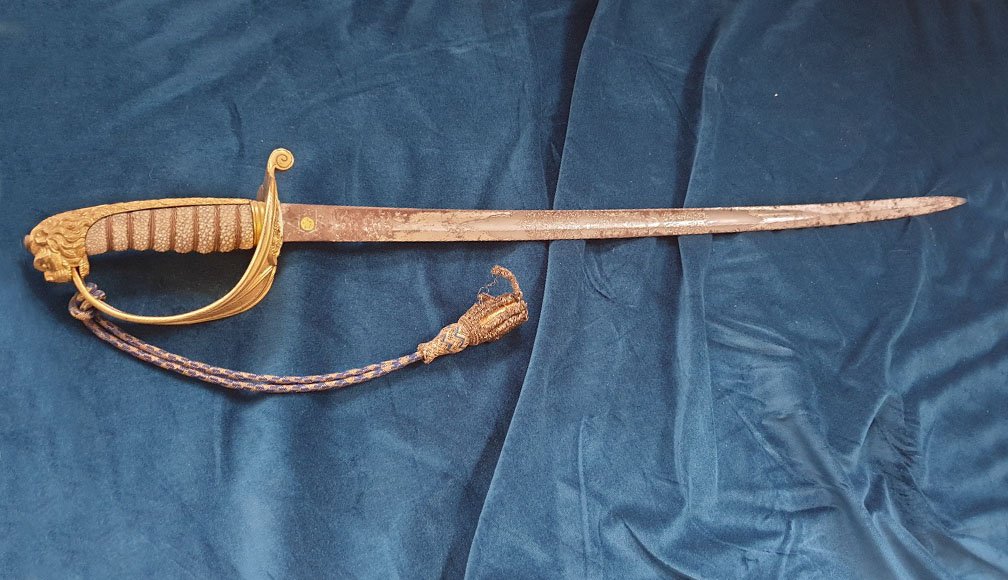
![20220822_175324_resized[1].jpg](https://images.squarespace-cdn.com/content/v1/5b5e5fcff8370a6f376d8ec4/1661209802492-KI2YE823P8XBJBGJGUCY/20220822_175324_resized%5B1%5D.jpg)
